Dissertation: Implementation Factors of Flexible Work in Malaysia
VerifiedAdded on 2023/04/23

A Critical Study of the Factors Influencing the Implementation of
Flexible Working Arrangements in the Malaysian Service Sector
Paraphrase This Document
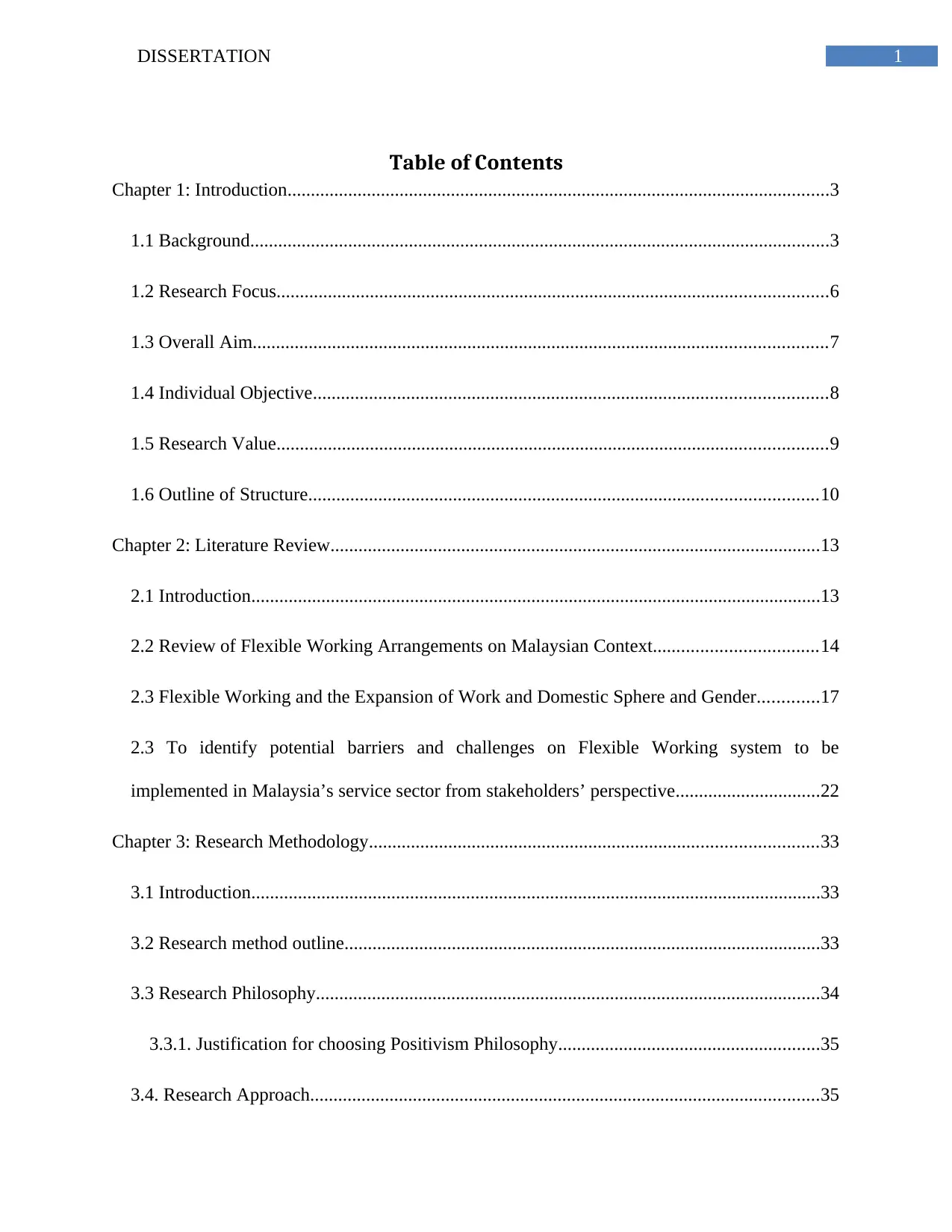
Table of Contents
Chapter 1: Introduction....................................................................................................................3
1.1 Background............................................................................................................................3
1.2 Research Focus......................................................................................................................6
1.3 Overall Aim...........................................................................................................................7
1.4 Individual Objective..............................................................................................................8
1.5 Research Value......................................................................................................................9
1.6 Outline of Structure.............................................................................................................10
Chapter 2: Literature Review.........................................................................................................13
2.1 Introduction..........................................................................................................................13
2.2 Review of Flexible Working Arrangements on Malaysian Context...................................14
2.3 Flexible Working and the Expansion of Work and Domestic Sphere and Gender.............17
2.3 To identify potential barriers and challenges on Flexible Working system to be
implemented in Malaysia’s service sector from stakeholders’ perspective...............................22
Chapter 3: Research Methodology................................................................................................33
3.1 Introduction..........................................................................................................................33
3.2 Research method outline......................................................................................................33
3.3 Research Philosophy............................................................................................................34
3.3.1. Justification for choosing Positivism Philosophy........................................................35
3.4. Research Approach.............................................................................................................35
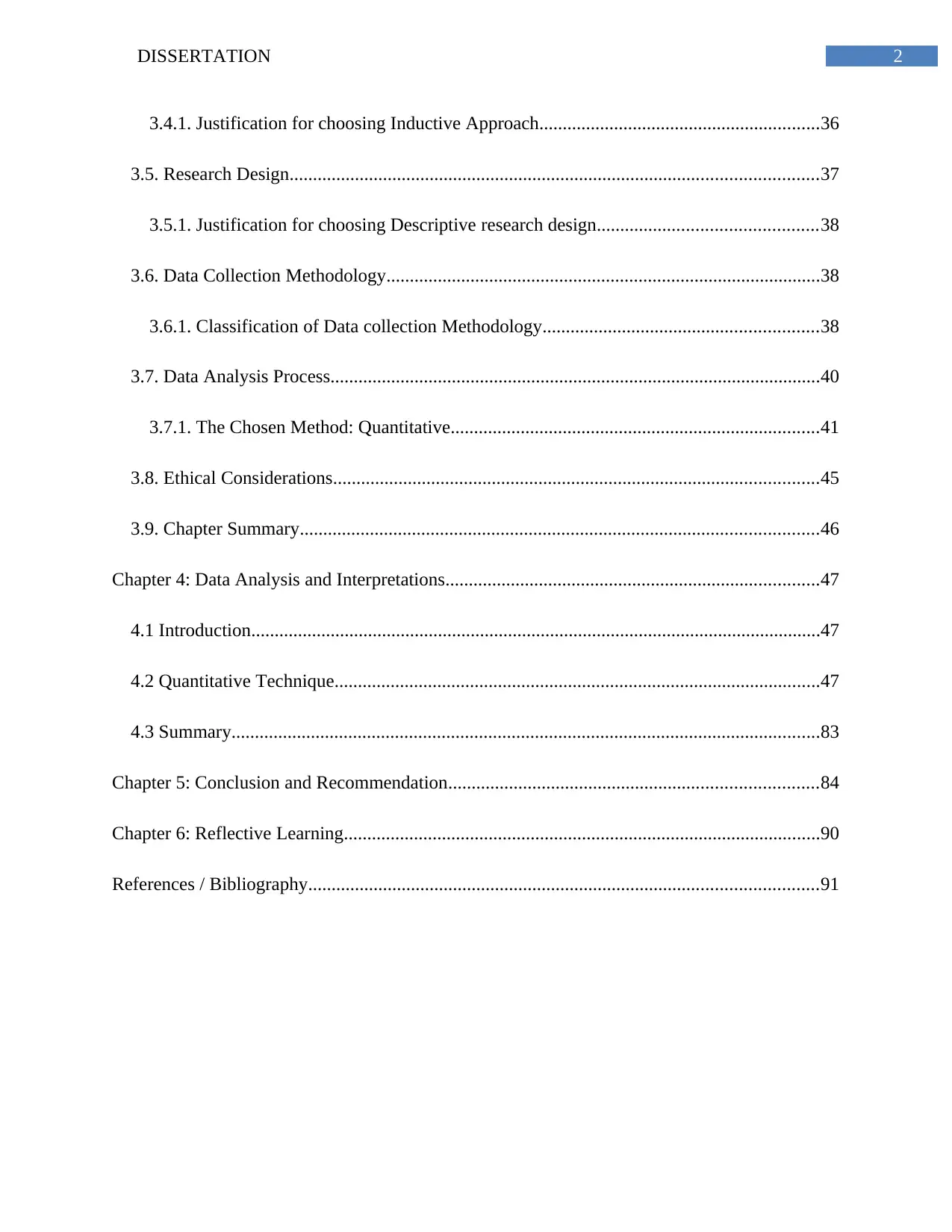
3.4.1. Justification for choosing Inductive Approach............................................................36
3.5. Research Design.................................................................................................................37
3.5.1. Justification for choosing Descriptive research design...............................................38
3.6. Data Collection Methodology.............................................................................................38
3.6.1. Classification of Data collection Methodology...........................................................38
3.7. Data Analysis Process.........................................................................................................40
3.7.1. The Chosen Method: Quantitative...............................................................................41
3.8. Ethical Considerations........................................................................................................45
3.9. Chapter Summary...............................................................................................................46
Chapter 4: Data Analysis and Interpretations................................................................................47
4.1 Introduction..........................................................................................................................47
4.2 Quantitative Technique........................................................................................................47
4.3 Summary..............................................................................................................................83
Chapter 5: Conclusion and Recommendation...............................................................................84
Chapter 6: Reflective Learning......................................................................................................90
References / Bibliography.............................................................................................................91
⊘ This is a preview!⊘
Do you want full access?
Subscribe today to unlock all pages.

Trusted by 1+ million students worldwide

Chapter 1: Introduction
1.1 Background
The working environment of the 21st century has evolved from one that is traditional
with rigid and fixed working hours, to one that addresses work-life balance. It is no secret, that
organizations today are increasingly facing severe skill shortages and challenges in employee
retention, which has necessitated the need to adopt a new approach that incorporates a culture of
trust in the form of offering flexibility to employees in the workplace (Office of the Focal Point
for Women, United Nations, 2010). Also, the evolution in demographics, cultural, economic and
legal environments have also brought about impacts on various human resource management
aspects, including employee recruitment and retention (Golden, 2008) (Vaiman, Scullion, &
Collings, 2012). The answer to this is the emergence of Flexible Working systems (FWS), or
known also as Flexible Working Arrangements (FWA) (Acas, 2015). Despite the fact that
monetary rewards such as salary, allowances and annual bonuses are still of paramount
importance to the employee, there has been a shift in emphasis towards non-monetary benefits,
where flexible working has been observed to be used as a tool to manage employee turnovers
(Smith, Oczkowski, & Smith, 2011) (Yamamoto, 2011). Scholars have argued that monetary
rewards alone are not sustainable drivers for job commitment and motivations, due to the social
value shifts among the younger generation (Arvanitis, 2005) (Gholipour, Bod, Zebtabi,
Pirannejad, & Kozekanan, 2010). Due to this reason, leading conglomerates around the world
such as Nestle and Vodafone (Bruhn, 2010) have implemented flexible working extensively
within their organisations in order to compete for the best talent.
As Malaysia strives hard to become a developed nation, it had slowly embraced
industrialization in the decades since gaining independence in 1957, when agriculture was still
Paraphrase This Document
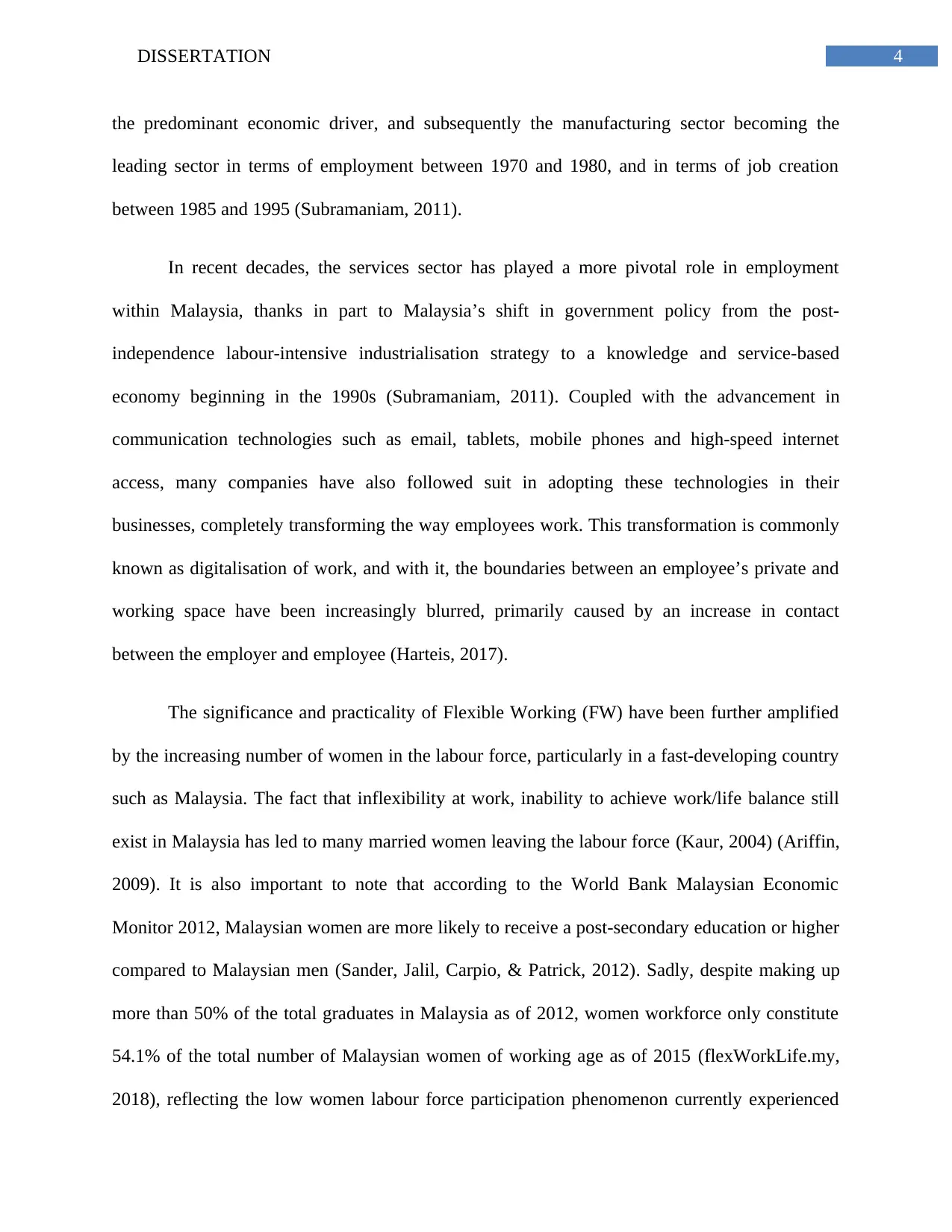
the predominant economic driver, and subsequently the manufacturing sector becoming the
leading sector in terms of employment between 1970 and 1980, and in terms of job creation
between 1985 and 1995 (Subramaniam, 2011).
In recent decades, the services sector has played a more pivotal role in employment
within Malaysia, thanks in part to Malaysia’s shift in government policy from the post-
independence labour-intensive industrialisation strategy to a knowledge and service-based
economy beginning in the 1990s (Subramaniam, 2011). Coupled with the advancement in
communication technologies such as email, tablets, mobile phones and high-speed internet
access, many companies have also followed suit in adopting these technologies in their
businesses, completely transforming the way employees work. This transformation is commonly
known as digitalisation of work, and with it, the boundaries between an employee’s private and
working space have been increasingly blurred, primarily caused by an increase in contact
between the employer and employee (Harteis, 2017).
The significance and practicality of Flexible Working (FW) have been further amplified
by the increasing number of women in the labour force, particularly in a fast-developing country
such as Malaysia. The fact that inflexibility at work, inability to achieve work/life balance still
exist in Malaysia has led to many married women leaving the labour force (Kaur, 2004) (Ariffin,
2009). It is also important to note that according to the World Bank Malaysian Economic
Monitor 2012, Malaysian women are more likely to receive a post-secondary education or higher
compared to Malaysian men (Sander, Jalil, Carpio, & Patrick, 2012). Sadly, despite making up
more than 50% of the total graduates in Malaysia as of 2012, women workforce only constitute
54.1% of the total number of Malaysian women of working age as of 2015 (flexWorkLife.my,
2018), reflecting the low women labour force participation phenomenon currently experienced
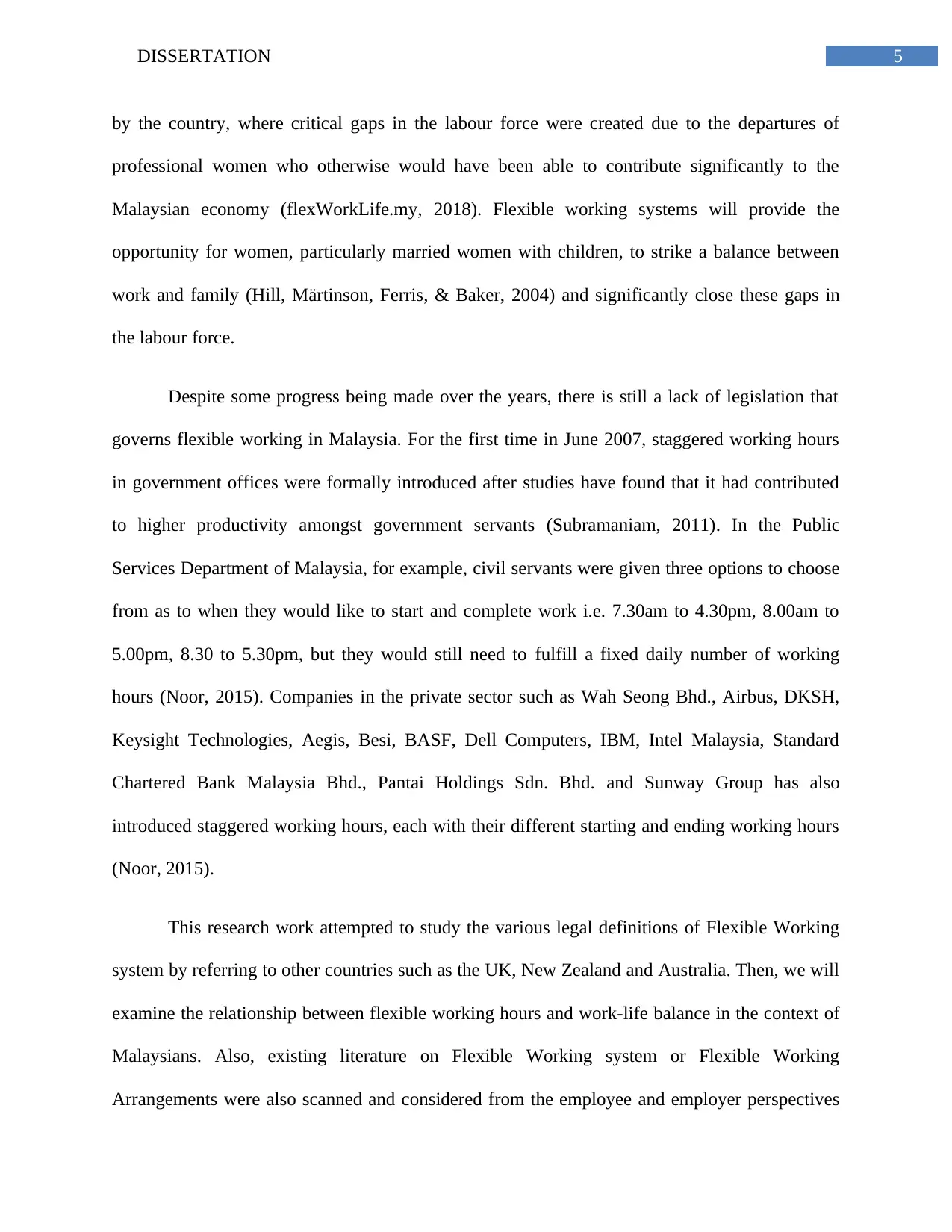
by the country, where critical gaps in the labour force were created due to the departures of
professional women who otherwise would have been able to contribute significantly to the
Malaysian economy (flexWorkLife.my, 2018). Flexible working systems will provide the
opportunity for women, particularly married women with children, to strike a balance between
work and family (Hill, Märtinson, Ferris, & Baker, 2004) and significantly close these gaps in
the labour force.
Despite some progress being made over the years, there is still a lack of legislation that
governs flexible working in Malaysia. For the first time in June 2007, staggered working hours
in government offices were formally introduced after studies have found that it had contributed
to higher productivity amongst government servants (Subramaniam, 2011). In the Public
Services Department of Malaysia, for example, civil servants were given three options to choose
from as to when they would like to start and complete work i.e. 7.30am to 4.30pm, 8.00am to
5.00pm, 8.30 to 5.30pm, but they would still need to fulfill a fixed daily number of working
hours (Noor, 2015). Companies in the private sector such as Wah Seong Bhd., Airbus, DKSH,
Keysight Technologies, Aegis, Besi, BASF, Dell Computers, IBM, Intel Malaysia, Standard
Chartered Bank Malaysia Bhd., Pantai Holdings Sdn. Bhd. and Sunway Group has also
introduced staggered working hours, each with their different starting and ending working hours
(Noor, 2015).
This research work attempted to study the various legal definitions of Flexible Working
system by referring to other countries such as the UK, New Zealand and Australia. Then, we will
examine the relationship between flexible working hours and work-life balance in the context of
Malaysians. Also, existing literature on Flexible Working system or Flexible Working
Arrangements were also scanned and considered from the employee and employer perspectives
⊘ This is a preview!⊘
Do you want full access?
Subscribe today to unlock all pages.

Trusted by 1+ million students worldwide
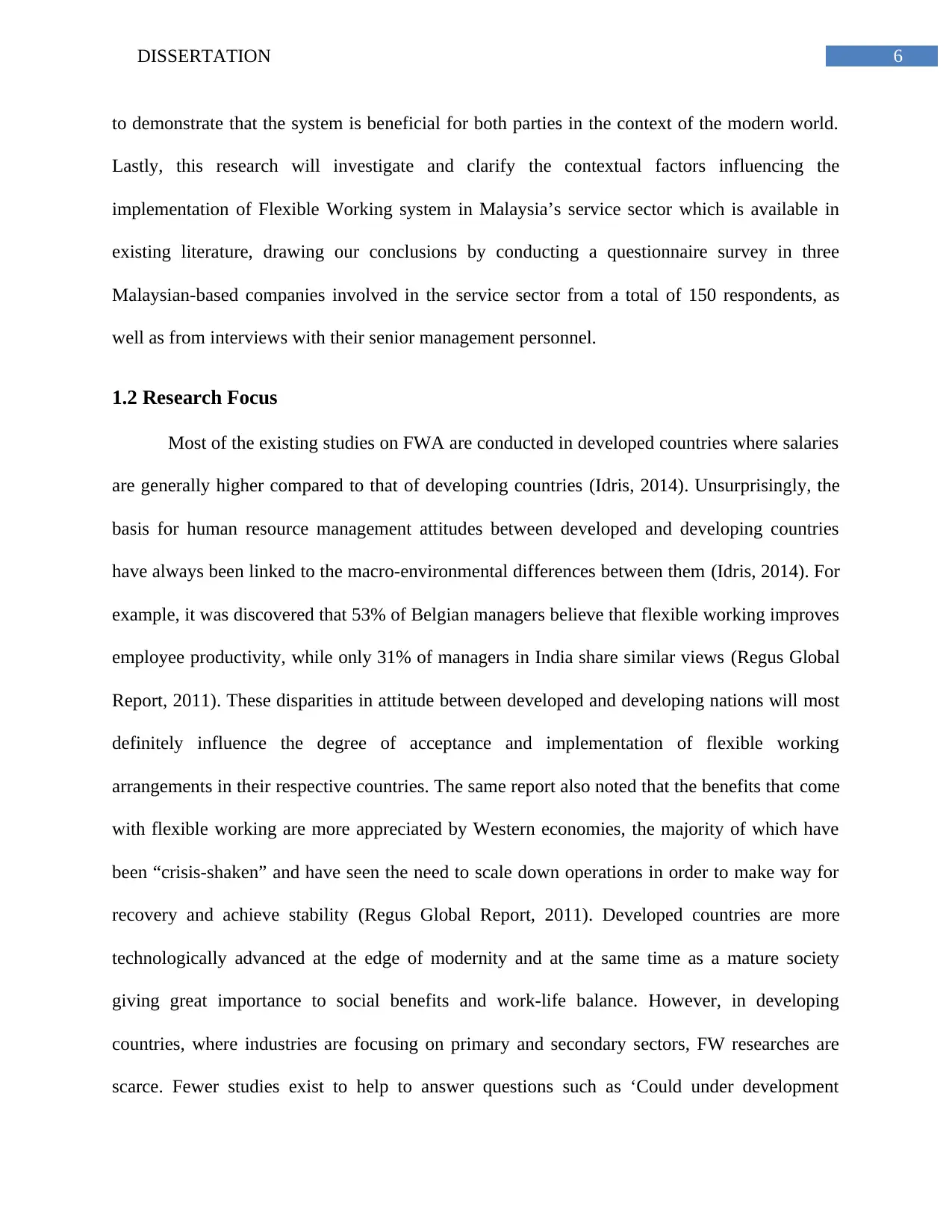
to demonstrate that the system is beneficial for both parties in the context of the modern world.
Lastly, this research will investigate and clarify the contextual factors influencing the
implementation of Flexible Working system in Malaysia’s service sector which is available in
existing literature, drawing our conclusions by conducting a questionnaire survey in three
Malaysian-based companies involved in the service sector from a total of 150 respondents, as
well as from interviews with their senior management personnel.
1.2 Research Focus
Most of the existing studies on FWA are conducted in developed countries where salaries
are generally higher compared to that of developing countries (Idris, 2014). Unsurprisingly, the
basis for human resource management attitudes between developed and developing countries
have always been linked to the macro-environmental differences between them (Idris, 2014). For
example, it was discovered that 53% of Belgian managers believe that flexible working improves
employee productivity, while only 31% of managers in India share similar views (Regus Global
Report, 2011). These disparities in attitude between developed and developing nations will most
definitely influence the degree of acceptance and implementation of flexible working
arrangements in their respective countries. The same report also noted that the benefits that come
with flexible working are more appreciated by Western economies, the majority of which have
been “crisis-shaken” and have seen the need to scale down operations in order to make way for
recovery and achieve stability (Regus Global Report, 2011). Developed countries are more
technologically advanced at the edge of modernity and at the same time as a mature society
giving great importance to social benefits and work-life balance. However, in developing
countries, where industries are focusing on primary and secondary sectors, FW researches are
scarce. Fewer studies exist to help to answer questions such as ‘Could under development
Paraphrase This Document
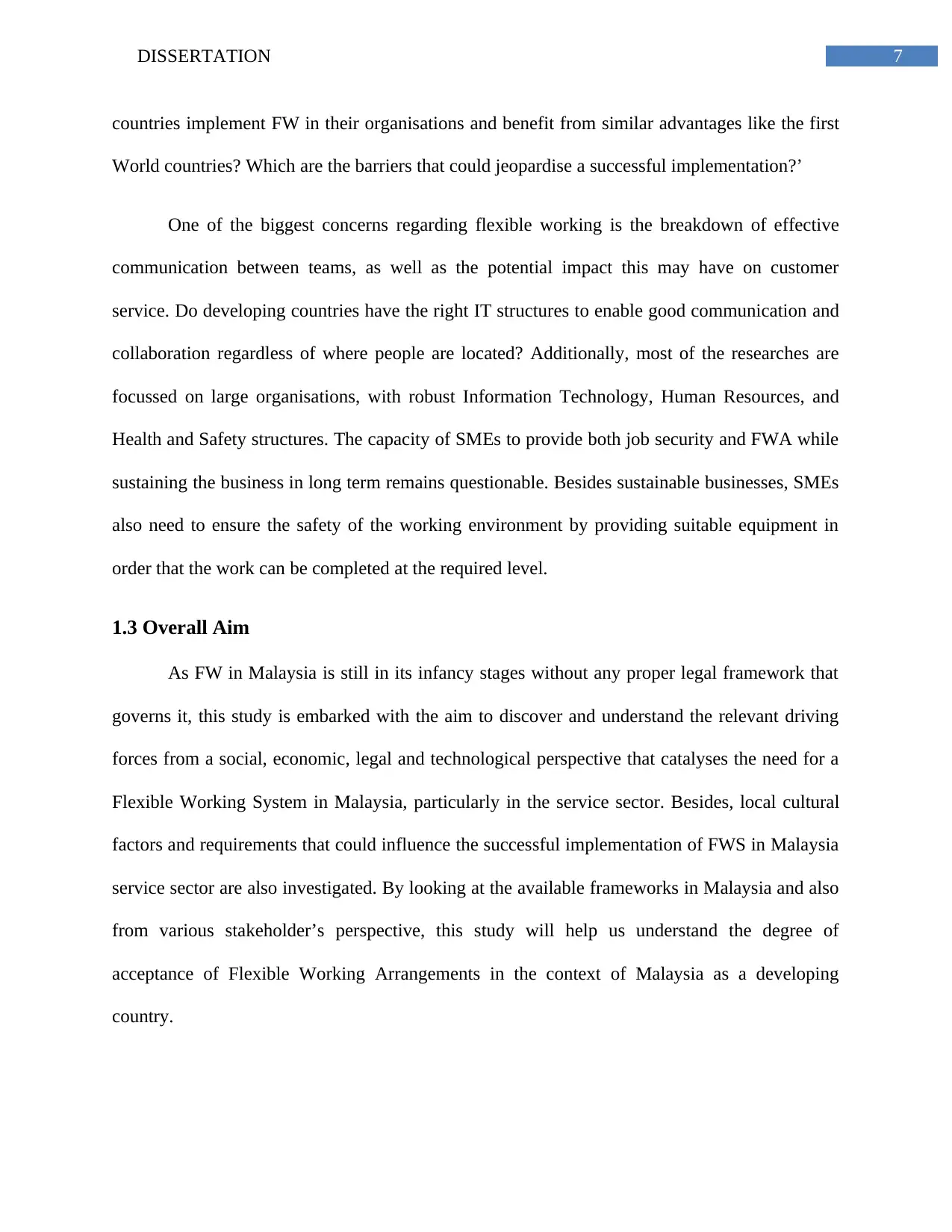
countries implement FW in their organisations and benefit from similar advantages like the first
World countries? Which are the barriers that could jeopardise a successful implementation?’
One of the biggest concerns regarding flexible working is the breakdown of effective
communication between teams, as well as the potential impact this may have on customer
service. Do developing countries have the right IT structures to enable good communication and
collaboration regardless of where people are located? Additionally, most of the researches are
focussed on large organisations, with robust Information Technology, Human Resources, and
Health and Safety structures. The capacity of SMEs to provide both job security and FWA while
sustaining the business in long term remains questionable. Besides sustainable businesses, SMEs
also need to ensure the safety of the working environment by providing suitable equipment in
order that the work can be completed at the required level.
1.3 Overall Aim
As FW in Malaysia is still in its infancy stages without any proper legal framework that
governs it, this study is embarked with the aim to discover and understand the relevant driving
forces from a social, economic, legal and technological perspective that catalyses the need for a
Flexible Working System in Malaysia, particularly in the service sector. Besides, local cultural
factors and requirements that could influence the successful implementation of FWS in Malaysia
service sector are also investigated. By looking at the available frameworks in Malaysia and also
from various stakeholder’s perspective, this study will help us understand the degree of
acceptance of Flexible Working Arrangements in the context of Malaysia as a developing
country.
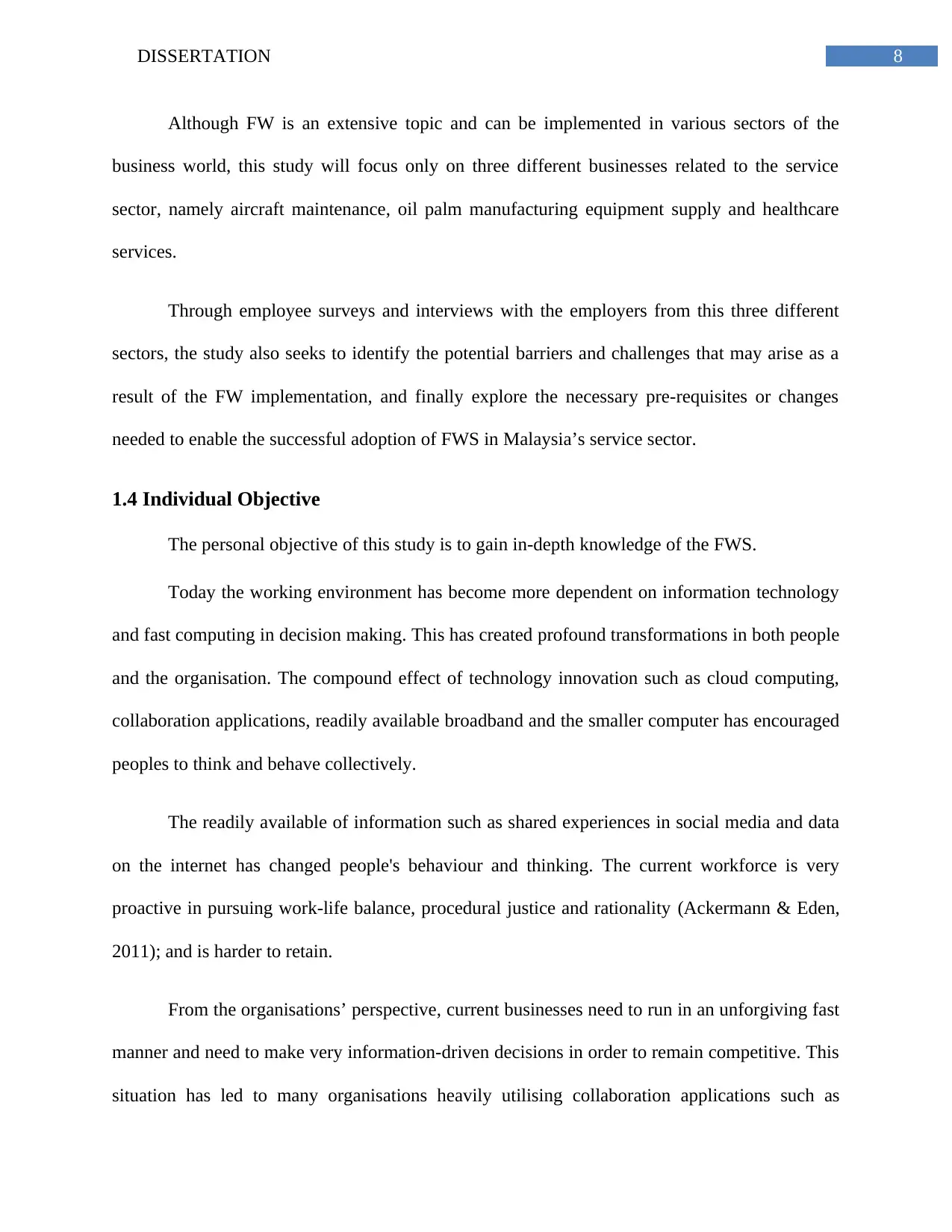
Although FW is an extensive topic and can be implemented in various sectors of the
business world, this study will focus only on three different businesses related to the service
sector, namely aircraft maintenance, oil palm manufacturing equipment supply and healthcare
services.
Through employee surveys and interviews with the employers from this three different
sectors, the study also seeks to identify the potential barriers and challenges that may arise as a
result of the FW implementation, and finally explore the necessary pre-requisites or changes
needed to enable the successful adoption of FWS in Malaysia’s service sector.
1.4 Individual Objective
The personal objective of this study is to gain in-depth knowledge of the FWS.
Today the working environment has become more dependent on information technology
and fast computing in decision making. This has created profound transformations in both people
and the organisation. The compound effect of technology innovation such as cloud computing,
collaboration applications, readily available broadband and the smaller computer has encouraged
peoples to think and behave collectively.
The readily available of information such as shared experiences in social media and data
on the internet has changed people's behaviour and thinking. The current workforce is very
proactive in pursuing work-life balance, procedural justice and rationality (Ackermann & Eden,
2011); and is harder to retain.
From the organisations’ perspective, current businesses need to run in an unforgiving fast
manner and need to make very information-driven decisions in order to remain competitive. This
situation has led to many organisations heavily utilising collaboration applications such as
⊘ This is a preview!⊘
Do you want full access?
Subscribe today to unlock all pages.

Trusted by 1+ million students worldwide
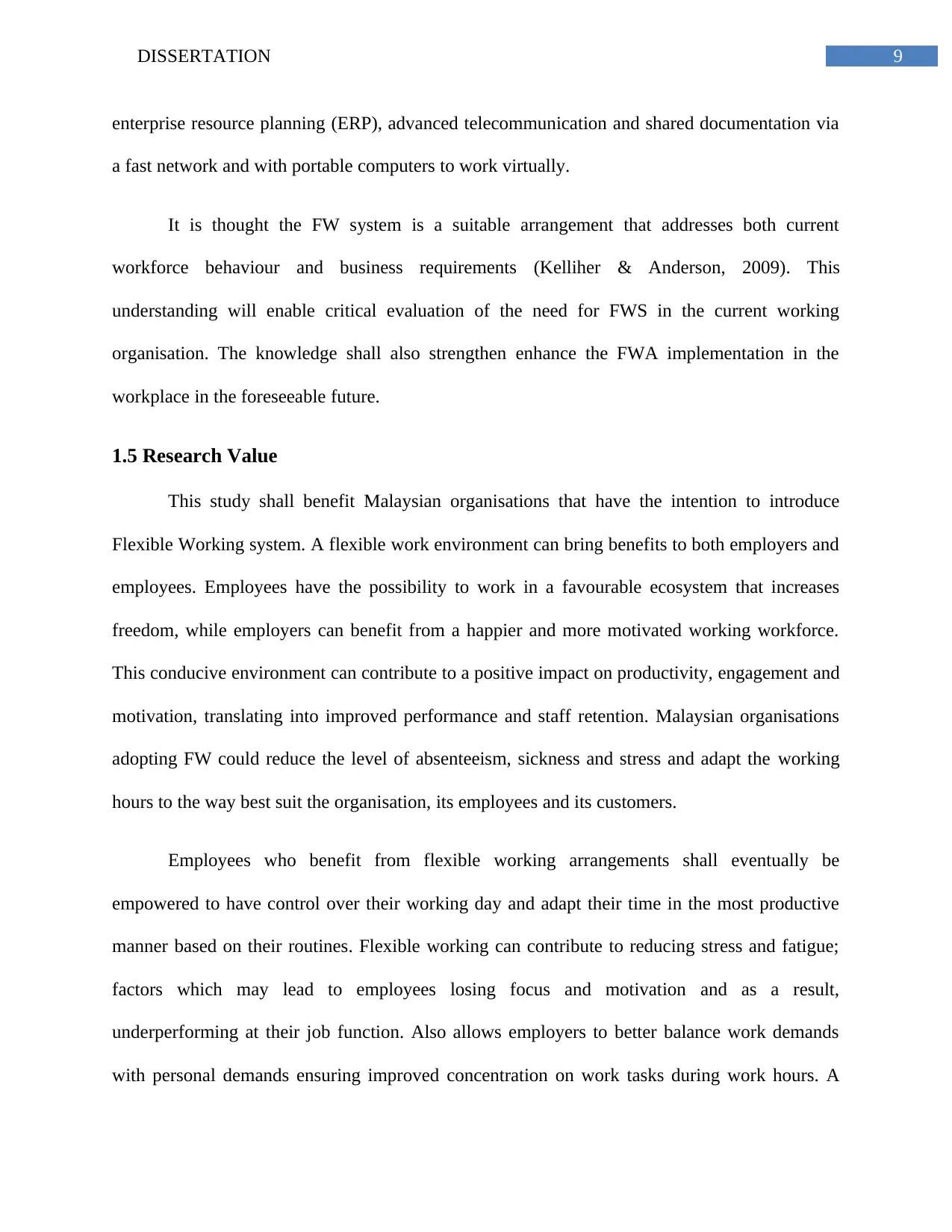
enterprise resource planning (ERP), advanced telecommunication and shared documentation via
a fast network and with portable computers to work virtually.
It is thought the FW system is a suitable arrangement that addresses both current
workforce behaviour and business requirements (Kelliher & Anderson, 2009). This
understanding will enable critical evaluation of the need for FWS in the current working
organisation. The knowledge shall also strengthen enhance the FWA implementation in the
workplace in the foreseeable future.
1.5 Research Value
This study shall benefit Malaysian organisations that have the intention to introduce
Flexible Working system. A flexible work environment can bring benefits to both employers and
employees. Employees have the possibility to work in a favourable ecosystem that increases
freedom, while employers can benefit from a happier and more motivated working workforce.
This conducive environment can contribute to a positive impact on productivity, engagement and
motivation, translating into improved performance and staff retention. Malaysian organisations
adopting FW could reduce the level of absenteeism, sickness and stress and adapt the working
hours to the way best suit the organisation, its employees and its customers.
Employees who benefit from flexible working arrangements shall eventually be
empowered to have control over their working day and adapt their time in the most productive
manner based on their routines. Flexible working can contribute to reducing stress and fatigue;
factors which may lead to employees losing focus and motivation and as a result,
underperforming at their job function. Also allows employers to better balance work demands
with personal demands ensuring improved concentration on work tasks during work hours. A
Paraphrase This Document
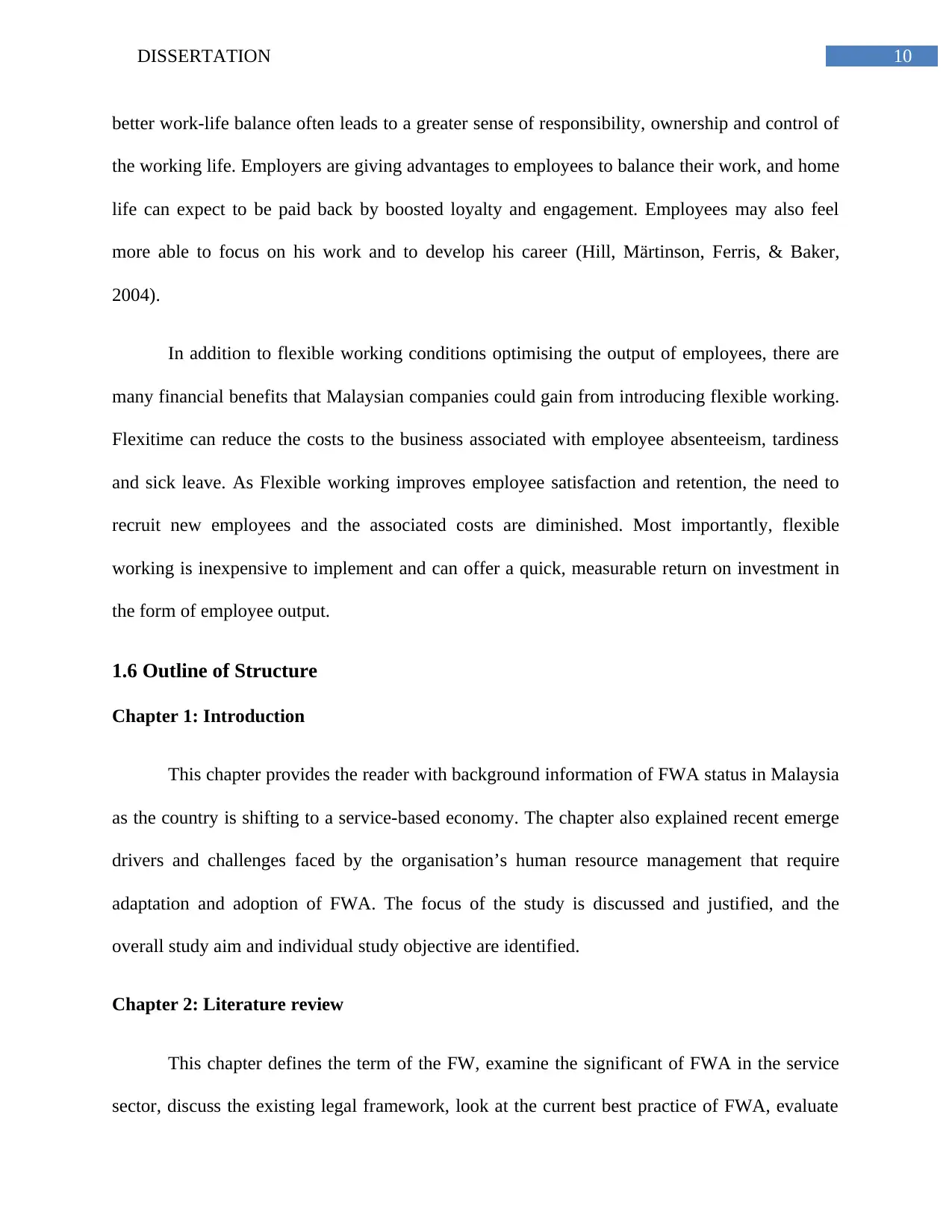
better work-life balance often leads to a greater sense of responsibility, ownership and control of
the working life. Employers are giving advantages to employees to balance their work, and home
life can expect to be paid back by boosted loyalty and engagement. Employees may also feel
more able to focus on his work and to develop his career (Hill, Märtinson, Ferris, & Baker,
2004).
In addition to flexible working conditions optimising the output of employees, there are
many financial benefits that Malaysian companies could gain from introducing flexible working.
Flexitime can reduce the costs to the business associated with employee absenteeism, tardiness
and sick leave. As Flexible working improves employee satisfaction and retention, the need to
recruit new employees and the associated costs are diminished. Most importantly, flexible
working is inexpensive to implement and can offer a quick, measurable return on investment in
the form of employee output.
1.6 Outline of Structure
Chapter 1: Introduction
This chapter provides the reader with background information of FWA status in Malaysia
as the country is shifting to a service-based economy. The chapter also explained recent emerge
drivers and challenges faced by the organisation’s human resource management that require
adaptation and adoption of FWA. The focus of the study is discussed and justified, and the
overall study aim and individual study objective are identified.
Chapter 2: Literature review
This chapter defines the term of the FW, examine the significant of FWA in the service
sector, discuss the existing legal framework, look at the current best practice of FWA, evaluate

FWA recommendation and models, explorer potential barrier and challenges of FWA, and
explorer changes needed to facilitate FWA in Malaysia.
Chapter 3: Research Methodology
This chapter discusses and rationalised the research strategy, data collection methodology
(focused on the structured questionnaire) and interview questionnaires to be used in the study
data collection. Information on surveyed industries is provided. The framework for analysis and
limitation of the study will also be discussed.
Chapter 4: Data Analysis and Interpretations
This chapter report on the result obtains from the research and the analysis of the finding
concerning the research objective. The result from the empirical finding is being discussed
followed by the interview finding. The empirical and interview finding not only will be
compared and contrast, but it will also be compared and contrast with literature review.
Chapter 5: Conclusion and recommendations
This chapter examines on overall aim of the objectives of the study. The summaries of
the finding on FW are being related to FWA and implementation in Malaysia service sector. The
conclusion from this study work is being derived and linked to the study objective. The
recommendation is being made based on this conclusion. The limitation of this work is also
highlighted. The issue of managing FW implementation in Malaysia is also addressed. The
importance of this study also been clarified.
Chapter 6: Reflective Learning
⊘ This is a preview!⊘
Do you want full access?
Subscribe today to unlock all pages.

Trusted by 1+ million students worldwide
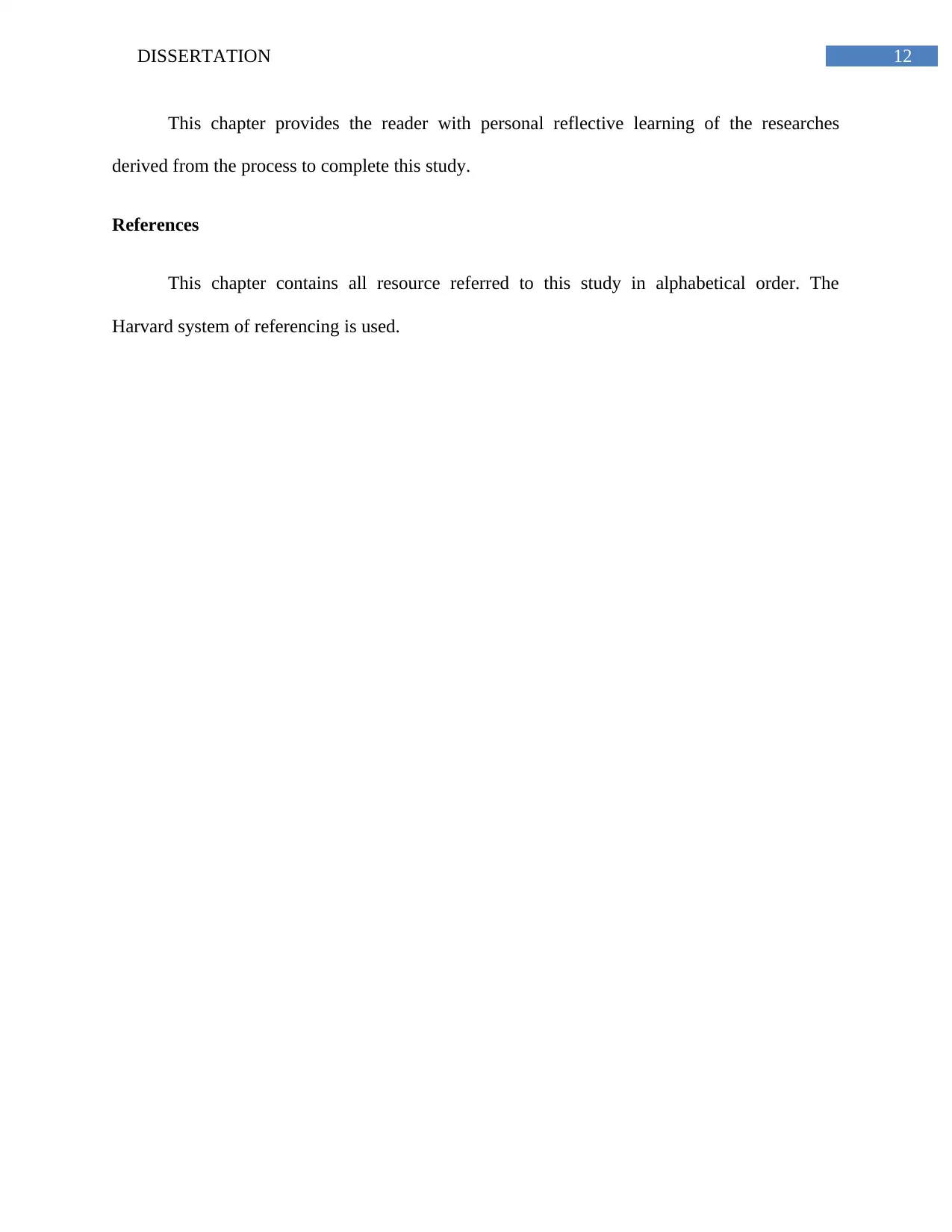
This chapter provides the reader with personal reflective learning of the researches
derived from the process to complete this study.
References
This chapter contains all resource referred to this study in alphabetical order. The
Harvard system of referencing is used.
Paraphrase This Document

Chapter 2: Literature Review
2.1 Introduction
Structural changes that happened in Malaysia has helped the country transform the
economy mainly from an agriculturally based into industrialization, accompanied by the increase
in the employment of women. This helped in resulting two predominant trends that includes
increase in dual earner families and offers opportunities to a number of women employees to
surpass their male counterparts (Harteis, 2017). However, it is observed that women face
difficulty in managing both the conditions that is the work and family in tandem. Thus, the
number of female employees is less than 48 percent in the recent years. In order to overcome
these issues several economist and policy makers have offered the concept of flexible timing that
will act as a major catalyst in the labor market. It is observed that organization tends to show
more emphasis towards the need of employees and recognizes their role as an important aspect
related to the work. It is essential for the workers to have proper recruitment policies that will
help in facilitating the work life balance. As stated by several authors it can be concluded that
Flexible Working System turns out to be beneficial for both employees and organization. This
also needs to be valued enough by the elderly parents. As per the recent studies it can be stated
that part time work has a great influence on managing the responsibility of the women
employees (Harteis, 2017). These concepts are considered to be one of the family friendly
approach and allows the employees to contribute towards the work and home. Thus, flexible
timing will help in enhancing the working condition that is offered to the young mothers and will
help in managing both the child and time needed for providing an efficient way of working.

2.2 Review of Flexible Working Arrangements on Malaysian Context
According to the Ninth Malaysian Plan (9MP) effective measures were taken in order to
provide an environment that will ensure more effective way of appreciating omen participation
in national development. Women were trained with necessary skills that help in developing
proper competitive advantage and will able to meet the challenges that are faced by the economy
of the country. However, it is observed that women’s labor market has increased by 30 per cent
in 1970 in Malaysia (Kvande 2017). On the other hand by the year 2011 the ratio has increased
by 49 per cent in Malaysia. As per the survey United Nations Economic and Social Commission
for Asia and the Pacific (UNESCAP) Malaysia is amongst the country in which women are still
under represented in the labor market. The impact of under utilizations of women has influenced
several families and their society in economic sense. The society norms include proper following
the religious traditions. The Malaysian government has implemented several endeavors to
encourage the participation of female workers and will help in the development of
socioeconomic of the country because it was found that the number of women labor was
comparatively low in Malaysia then compared to other countries . According to Husin et al.
(2017), there is a need to have a proper integration between work and non-work responsibilities
so that proper involvement of women can be obtained in the labor market. With the help of
effective labor market policies job opportunity will increase in the market. The Malaysian
government has implemented proper policies that will ensure necessary provision that will
support the facilities towards the women and will ensure proper entry in the labor market.
Irrespective of the policies and efforts made by government it is observed that the presence of
women has never increased. As per the works of (Subramaniam, Overton and Maniam 2015), the
policies include flexible time, extending maternity leave and extending paternity leave. These
⊘ This is a preview!⊘
Do you want full access?
Subscribe today to unlock all pages.

Trusted by 1+ million students worldwide
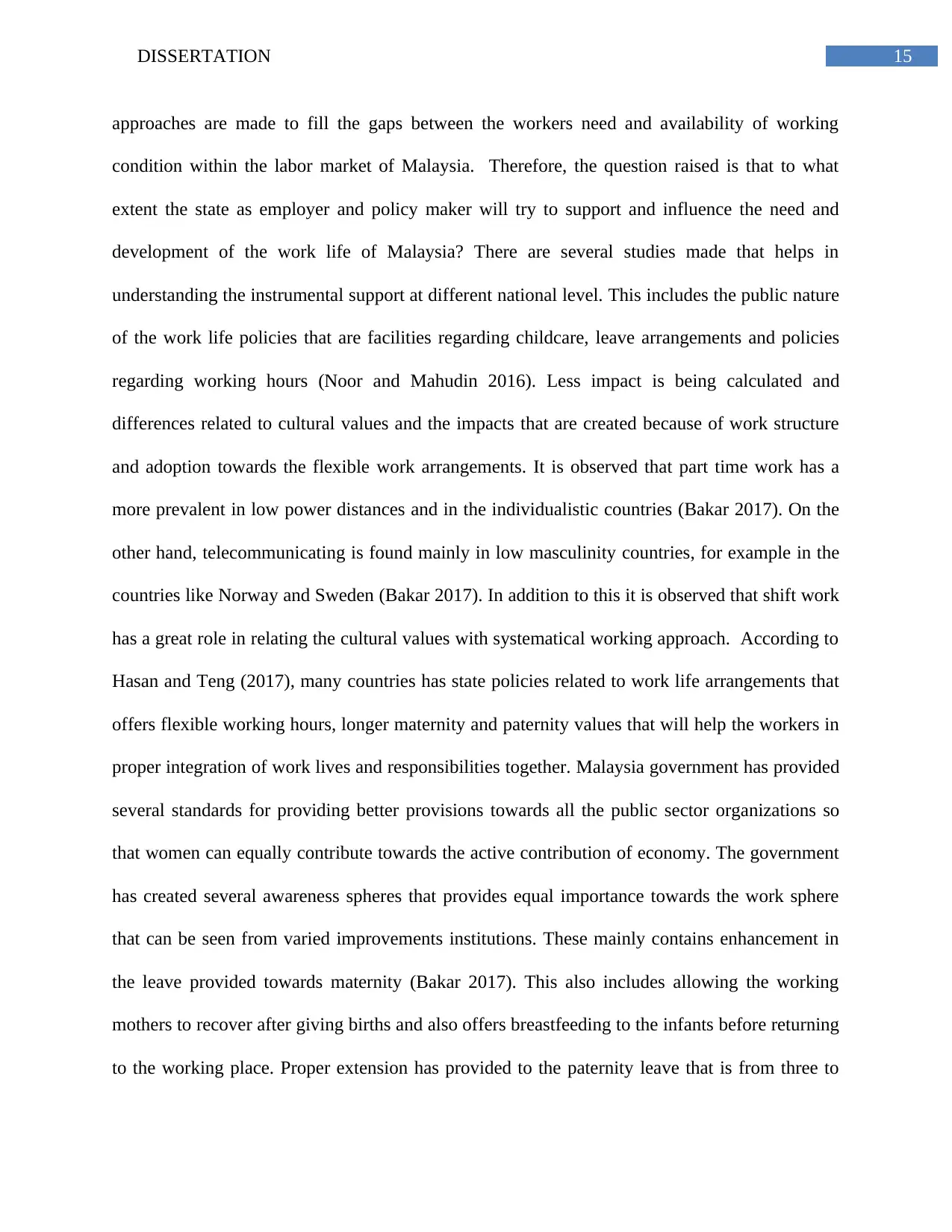
approaches are made to fill the gaps between the workers need and availability of working
condition within the labor market of Malaysia. Therefore, the question raised is that to what
extent the state as employer and policy maker will try to support and influence the need and
development of the work life of Malaysia? There are several studies made that helps in
understanding the instrumental support at different national level. This includes the public nature
of the work life policies that are facilities regarding childcare, leave arrangements and policies
regarding working hours (Noor and Mahudin 2016). Less impact is being calculated and
differences related to cultural values and the impacts that are created because of work structure
and adoption towards the flexible work arrangements. It is observed that part time work has a
more prevalent in low power distances and in the individualistic countries (Bakar 2017). On the
other hand, telecommunicating is found mainly in low masculinity countries, for example in the
countries like Norway and Sweden (Bakar 2017). In addition to this it is observed that shift work
has a great role in relating the cultural values with systematical working approach. According to
Hasan and Teng (2017), many countries has state policies related to work life arrangements that
offers flexible working hours, longer maternity and paternity values that will help the workers in
proper integration of work lives and responsibilities together. Malaysia government has provided
several standards for providing better provisions towards all the public sector organizations so
that women can equally contribute towards the active contribution of economy. The government
has created several awareness spheres that provides equal importance towards the work sphere
that can be seen from varied improvements institutions. These mainly contains enhancement in
the leave provided towards maternity (Bakar 2017). This also includes allowing the working
mothers to recover after giving births and also offers breastfeeding to the infants before returning
to the working place. Proper extension has provided to the paternity leave that is from three to
Paraphrase This Document
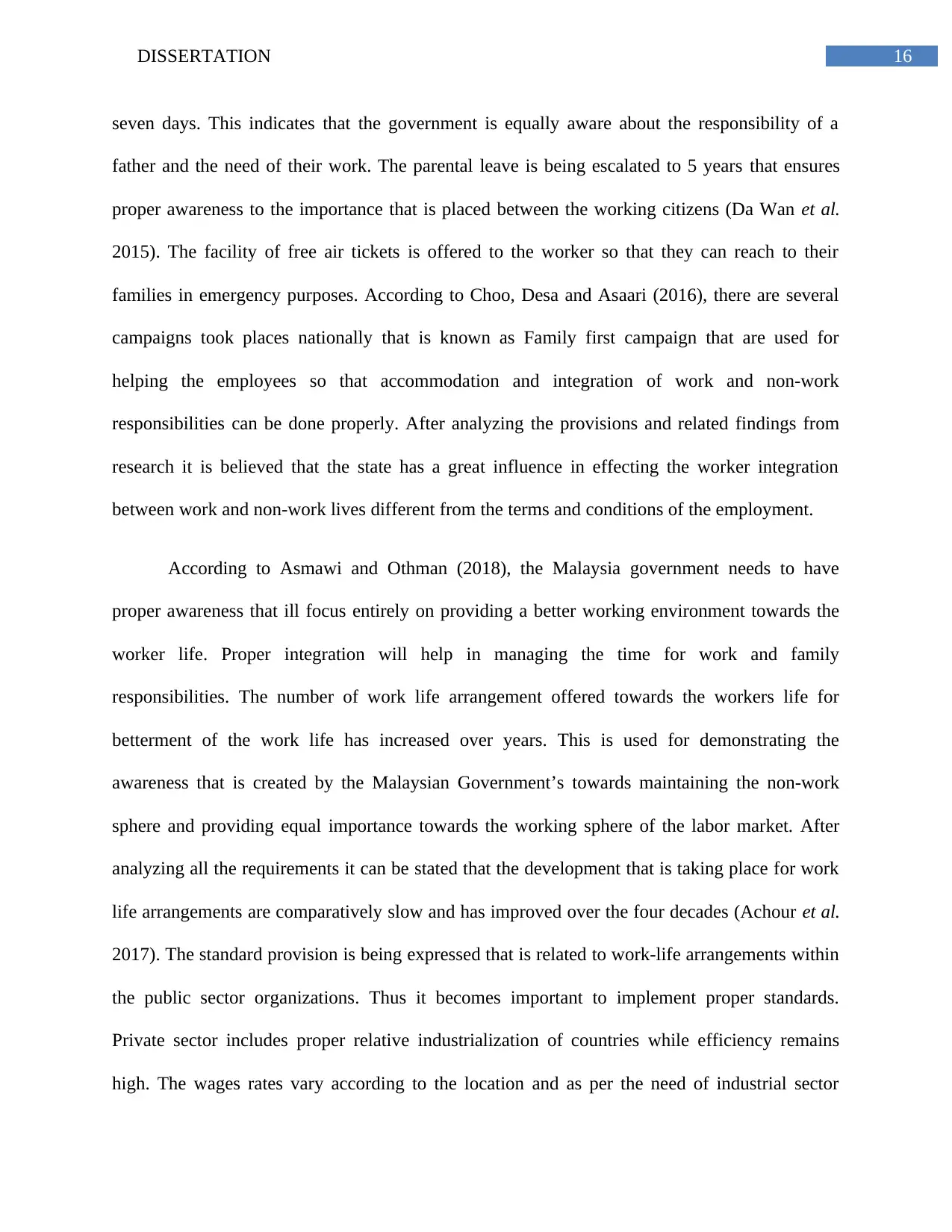
seven days. This indicates that the government is equally aware about the responsibility of a
father and the need of their work. The parental leave is being escalated to 5 years that ensures
proper awareness to the importance that is placed between the working citizens (Da Wan et al.
2015). The facility of free air tickets is offered to the worker so that they can reach to their
families in emergency purposes. According to Choo, Desa and Asaari (2016), there are several
campaigns took places nationally that is known as Family first campaign that are used for
helping the employees so that accommodation and integration of work and non-work
responsibilities can be done properly. After analyzing the provisions and related findings from
research it is believed that the state has a great influence in effecting the worker integration
between work and non-work lives different from the terms and conditions of the employment.
According to Asmawi and Othman (2018), the Malaysia government needs to have
proper awareness that ill focus entirely on providing a better working environment towards the
worker life. Proper integration will help in managing the time for work and family
responsibilities. The number of work life arrangement offered towards the workers life for
betterment of the work life has increased over years. This is used for demonstrating the
awareness that is created by the Malaysian Government’s towards maintaining the non-work
sphere and providing equal importance towards the working sphere of the labor market. After
analyzing all the requirements it can be stated that the development that is taking place for work
life arrangements are comparatively slow and has improved over the four decades (Achour et al.
2017). The standard provision is being expressed that is related to work-life arrangements within
the public sector organizations. Thus it becomes important to implement proper standards.
Private sector includes proper relative industrialization of countries while efficiency remains
high. The wages rates vary according to the location and as per the need of industrial sector

(Subramaniam and Mohd Saleh 2016). The supplementary benefits are included in this that
offers bonus, free and subsidized transport, free uniform and benefits related to performance.
Proper salary rates and fringe benefits are offered for managing the executive level personnel and
also varies widely based on the policy followed in industry and employment. Apart from this
most of the companies provides salaries and some addition fringe benefits. This includes
personal accident, proper life insurance coverage and free medical treatment, annual bonus,
retirement benefits and enhanced contributions to the Employees’ Provident Fund.
2.3 Flexible Working and the Expansion of Work and Domestic Sphere and Gender
Over the years it is being observed that the flexible working has increased the proper
control over the work place (Da Wan et al. 2015). Apart from this it is observed that there is a
huge demand of flexibility within the workplace mainly for the younger generation (Noor and
Mohd 2015). After analyzing the reports it is observed that maximum number of milennials
wants the opportunity to work from home and wants the flexi-time. This is important to ensure
that working women’s need to adapt themselves as per their demand. After analyzing the
previous working conditions it is observed that flexible working time helps the mothers to
maintain their working hours and also helps in maintaining the relationship with the family
members (Noor and Mohd 2015). This ability increases a level of satisfaction between the
working women and ensures proper balance between the work and the home. Thus it can be
stated that enhancement in flexible working hours will help in promoting gender equality in the
society. However it becomes very difficult to change the view of the society regarding the job
roles. It is observed that the working hours for men becomes flexible are often rewarded with
increments (Noor and Mahudin 2016). On the other it is observed that women faces major
problems while managing both the working conditions (Achour et al. 2017). Thus it becomes
⊘ This is a preview!⊘
Do you want full access?
Subscribe today to unlock all pages.

Trusted by 1+ million students worldwide
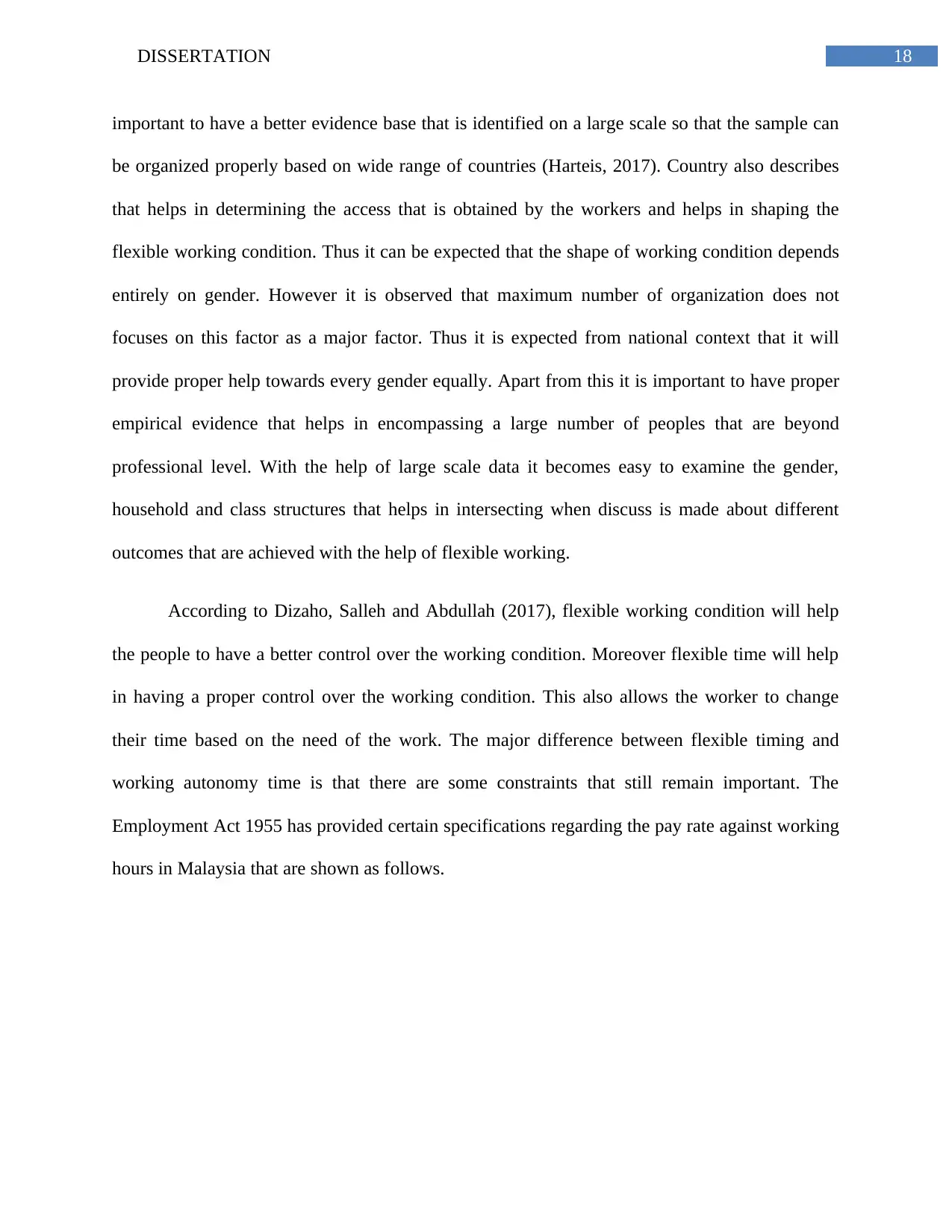
important to have a better evidence base that is identified on a large scale so that the sample can
be organized properly based on wide range of countries (Harteis, 2017). Country also describes
that helps in determining the access that is obtained by the workers and helps in shaping the
flexible working condition. Thus it can be expected that the shape of working condition depends
entirely on gender. However it is observed that maximum number of organization does not
focuses on this factor as a major factor. Thus it is expected from national context that it will
provide proper help towards every gender equally. Apart from this it is important to have proper
empirical evidence that helps in encompassing a large number of peoples that are beyond
professional level. With the help of large scale data it becomes easy to examine the gender,
household and class structures that helps in intersecting when discuss is made about different
outcomes that are achieved with the help of flexible working.
According to Dizaho, Salleh and Abdullah (2017), flexible working condition will help
the people to have a better control over the working condition. Moreover flexible time will help
in having a proper control over the working condition. This also allows the worker to change
their time based on the need of the work. The major difference between flexible timing and
working autonomy time is that there are some constraints that still remain important. The
Employment Act 1955 has provided certain specifications regarding the pay rate against working
hours in Malaysia that are shown as follows.
Paraphrase This Document
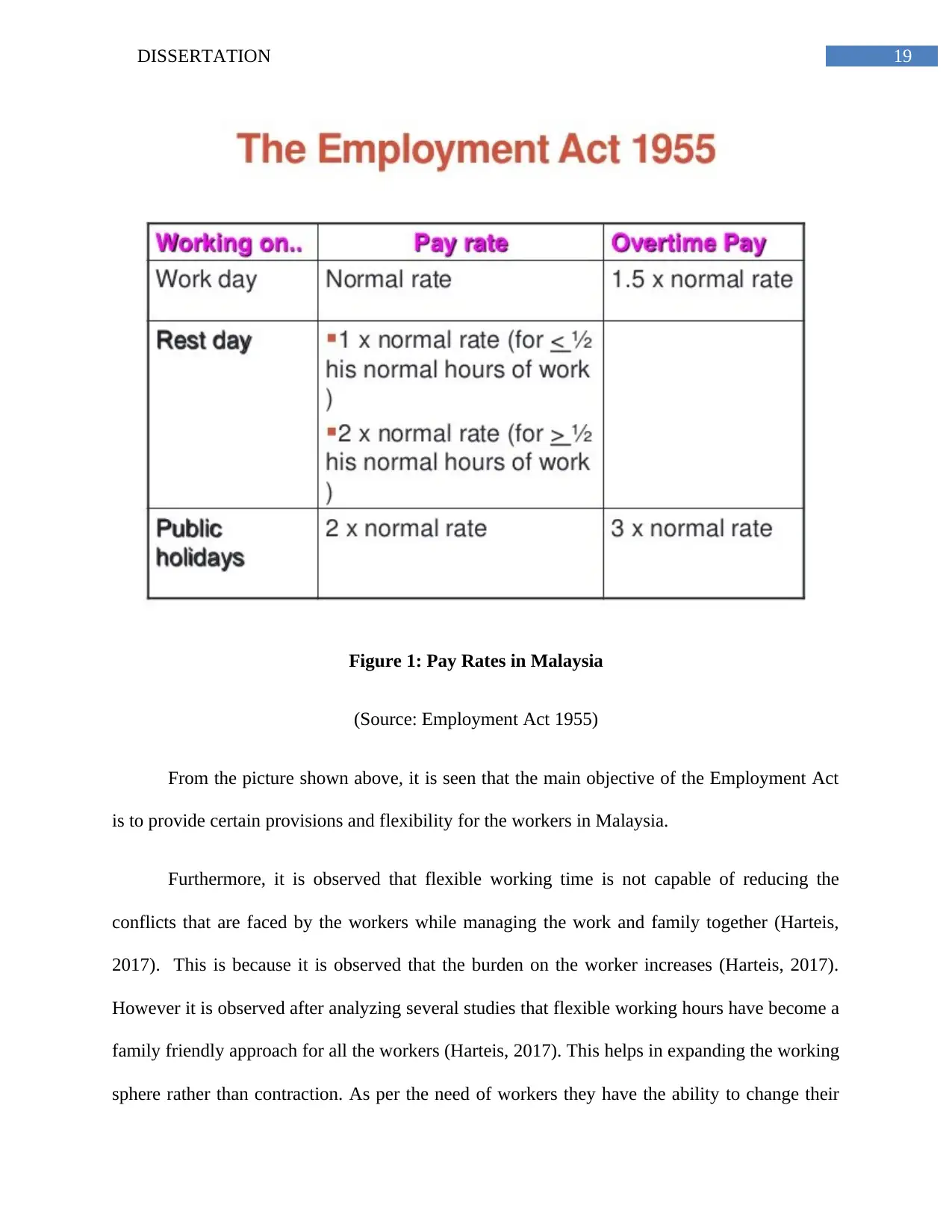
Figure 1: Pay Rates in Malaysia
(Source: Employment Act 1955)
From the picture shown above, it is seen that the main objective of the Employment Act
is to provide certain provisions and flexibility for the workers in Malaysia.
Furthermore, it is observed that flexible working time is not capable of reducing the
conflicts that are faced by the workers while managing the work and family together (Harteis,
2017). This is because it is observed that the burden on the worker increases (Harteis, 2017).
However it is observed after analyzing several studies that flexible working hours have become a
family friendly approach for all the workers (Harteis, 2017). This helps in expanding the working
sphere rather than contraction. As per the need of workers they have the ability to change their

working hours (Abdullah et al. 2018). The main problems are faced by the working women’s
that is regarding managing their responsibility that helps in blurring of boundaries and allows the
workers to work harder and efficiently.
However it is also seen that the flexible working hours are used by women for the
purpose of care giving. The workers with flexible timing are observed to have a better expansion
of housework. According to the author Clawson and Gerstel (2014) flexible working allows the
employees to fulfill each role effectively. These are mainly beneficial for middle class worker
and helps them to fulfill the social normative roles that are described within the society. This
concept helps in understanding the concept of flexible working that are offered to the men and
women. After analyzing the features it is observed that when flexible working hours and the
facility of work from home is offered to women, there are high chances that they might manage
both household and work together. This helps in shaping the working nature that is offered with
the use of flexible working. The traits of having flexible work time are mainly helpful for
mothers. They get the opportunity of having flexibility towards the working environment. But
after surveying the working condition based on US it is observed that women’s are less offered
with the flexible time (Wong, Bandar and Saili 2017). On the other hand it is observed that the
fathers are offered with a progressive badge of merit. This badge helps them in gaining flexible
working arrangements. Thus it can be stated that flexible working arrangements have the
capability to prevent more benefits towards the female employees rather than on male
employees. Several kinds of discrimination are observed at different type of workplaces.
Based on a study published by AIA Vitality (2017), some statistics have been found
regarding the working Malaysian people as presented in the following diagram.
⊘ This is a preview!⊘
Do you want full access?
Subscribe today to unlock all pages.

Trusted by 1+ million students worldwide
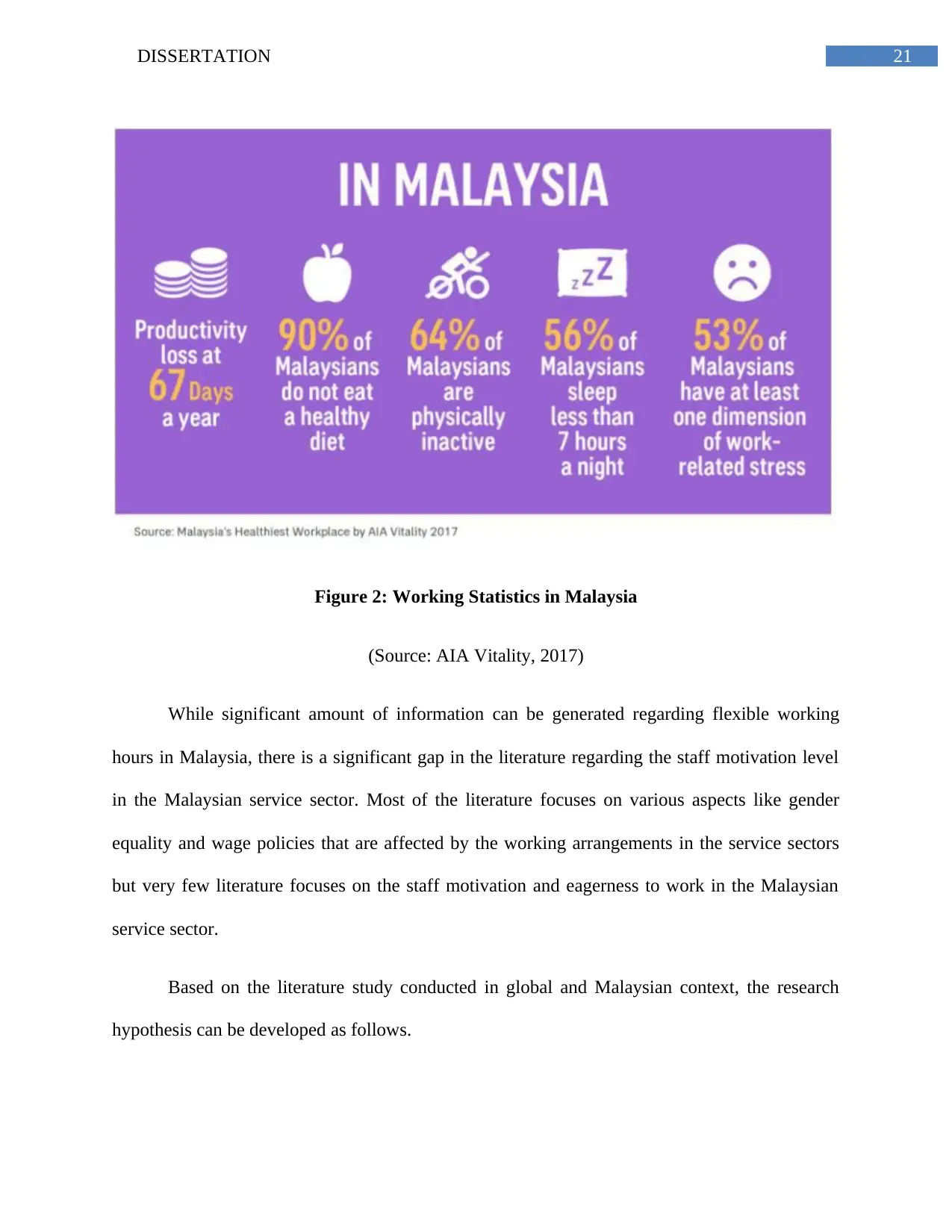
Figure 2: Working Statistics in Malaysia
(Source: AIA Vitality, 2017)
While significant amount of information can be generated regarding flexible working
hours in Malaysia, there is a significant gap in the literature regarding the staff motivation level
in the Malaysian service sector. Most of the literature focuses on various aspects like gender
equality and wage policies that are affected by the working arrangements in the service sectors
but very few literature focuses on the staff motivation and eagerness to work in the Malaysian
service sector.
Based on the literature study conducted in global and Malaysian context, the research
hypothesis can be developed as follows.
Paraphrase This Document
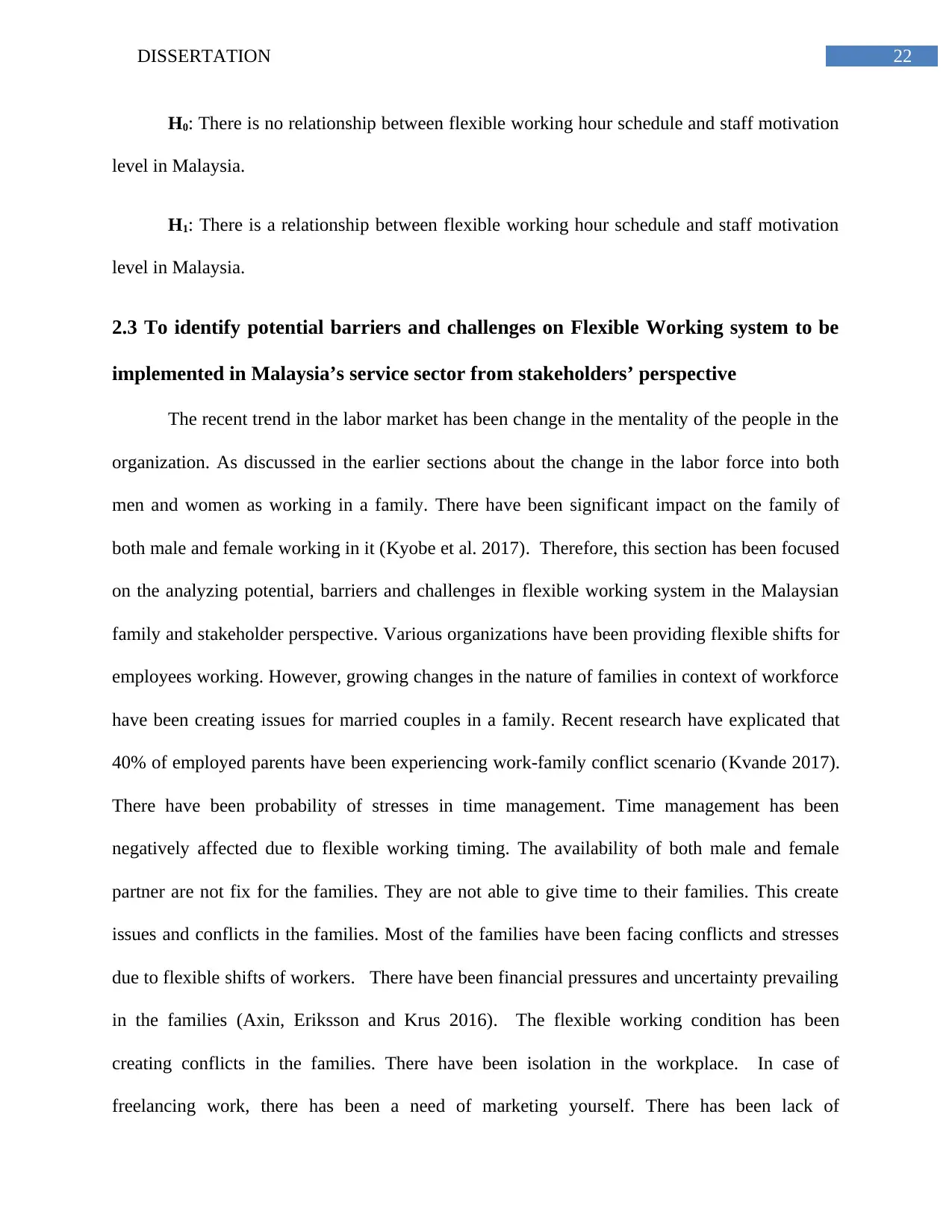
H0: There is no relationship between flexible working hour schedule and staff motivation
level in Malaysia.
H1: There is a relationship between flexible working hour schedule and staff motivation
level in Malaysia.
2.3 To identify potential barriers and challenges on Flexible Working system to be
implemented in Malaysia’s service sector from stakeholders’ perspective
The recent trend in the labor market has been change in the mentality of the people in the
organization. As discussed in the earlier sections about the change in the labor force into both
men and women as working in a family. There have been significant impact on the family of
both male and female working in it (Kyobe et al. 2017). Therefore, this section has been focused
on the analyzing potential, barriers and challenges in flexible working system in the Malaysian
family and stakeholder perspective. Various organizations have been providing flexible shifts for
employees working. However, growing changes in the nature of families in context of workforce
have been creating issues for married couples in a family. Recent research have explicated that
40% of employed parents have been experiencing work-family conflict scenario (Kvande 2017).
There have been probability of stresses in time management. Time management has been
negatively affected due to flexible working timing. The availability of both male and female
partner are not fix for the families. They are not able to give time to their families. This create
issues and conflicts in the families. Most of the families have been facing conflicts and stresses
due to flexible shifts of workers. There have been financial pressures and uncertainty prevailing
in the families (Axin, Eriksson and Krus 2016). The flexible working condition has been
creating conflicts in the families. There have been isolation in the workplace. In case of
freelancing work, there has been a need of marketing yourself. There has been lack of
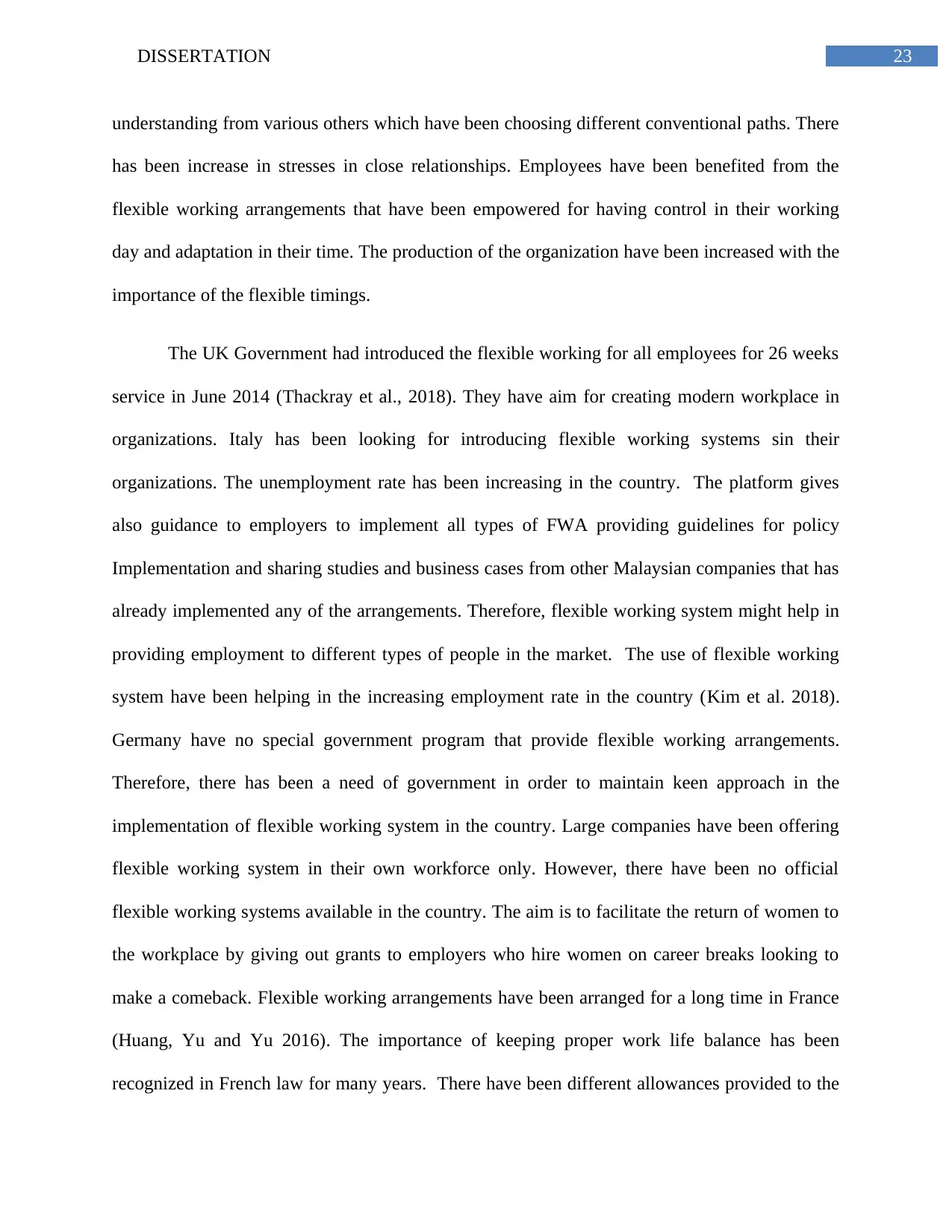
understanding from various others which have been choosing different conventional paths. There
has been increase in stresses in close relationships. Employees have been benefited from the
flexible working arrangements that have been empowered for having control in their working
day and adaptation in their time. The production of the organization have been increased with the
importance of the flexible timings.
The UK Government had introduced the flexible working for all employees for 26 weeks
service in June 2014 (Thackray et al., 2018). They have aim for creating modern workplace in
organizations. Italy has been looking for introducing flexible working systems sin their
organizations. The unemployment rate has been increasing in the country. The platform gives
also guidance to employers to implement all types of FWA providing guidelines for policy
Implementation and sharing studies and business cases from other Malaysian companies that has
already implemented any of the arrangements. Therefore, flexible working system might help in
providing employment to different types of people in the market. The use of flexible working
system have been helping in the increasing employment rate in the country (Kim et al. 2018).
Germany have no special government program that provide flexible working arrangements.
Therefore, there has been a need of government in order to maintain keen approach in the
implementation of flexible working system in the country. Large companies have been offering
flexible working system in their own workforce only. However, there have been no official
flexible working systems available in the country. The aim is to facilitate the return of women to
the workplace by giving out grants to employers who hire women on career breaks looking to
make a comeback. Flexible working arrangements have been arranged for a long time in France
(Huang, Yu and Yu 2016). The importance of keeping proper work life balance has been
recognized in French law for many years. There have been different allowances provided to the
⊘ This is a preview!⊘
Do you want full access?
Subscribe today to unlock all pages.

Trusted by 1+ million students worldwide
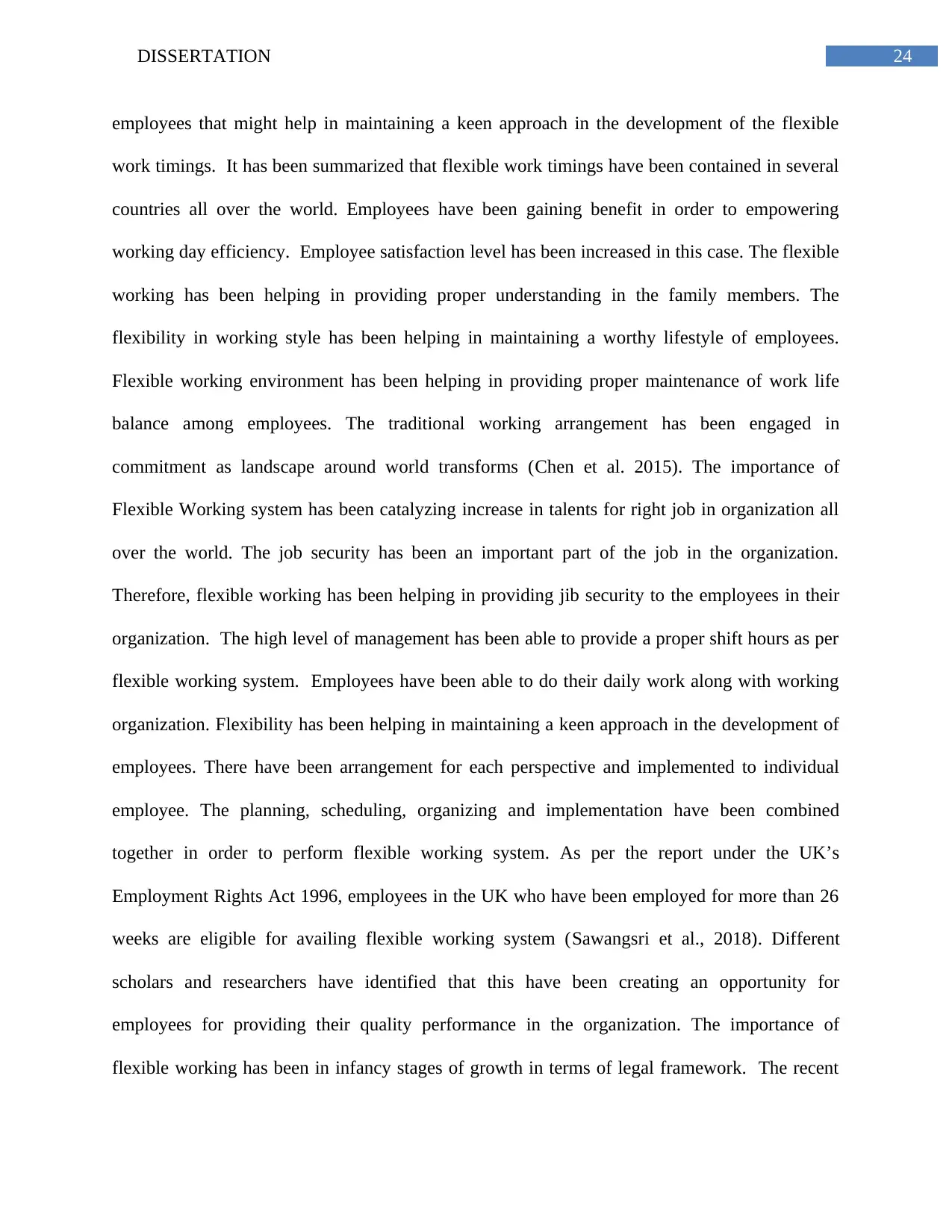
employees that might help in maintaining a keen approach in the development of the flexible
work timings. It has been summarized that flexible work timings have been contained in several
countries all over the world. Employees have been gaining benefit in order to empowering
working day efficiency. Employee satisfaction level has been increased in this case. The flexible
working has been helping in providing proper understanding in the family members. The
flexibility in working style has been helping in maintaining a worthy lifestyle of employees.
Flexible working environment has been helping in providing proper maintenance of work life
balance among employees. The traditional working arrangement has been engaged in
commitment as landscape around world transforms (Chen et al. 2015). The importance of
Flexible Working system has been catalyzing increase in talents for right job in organization all
over the world. The job security has been an important part of the job in the organization.
Therefore, flexible working has been helping in providing jib security to the employees in their
organization. The high level of management has been able to provide a proper shift hours as per
flexible working system. Employees have been able to do their daily work along with working
organization. Flexibility has been helping in maintaining a keen approach in the development of
employees. There have been arrangement for each perspective and implemented to individual
employee. The planning, scheduling, organizing and implementation have been combined
together in order to perform flexible working system. As per the report under the UK’s
Employment Rights Act 1996, employees in the UK who have been employed for more than 26
weeks are eligible for availing flexible working system (Sawangsri et al., 2018). Different
scholars and researchers have identified that this have been creating an opportunity for
employees for providing their quality performance in the organization. The importance of
flexible working has been in infancy stages of growth in terms of legal framework. The recent
Paraphrase This Document
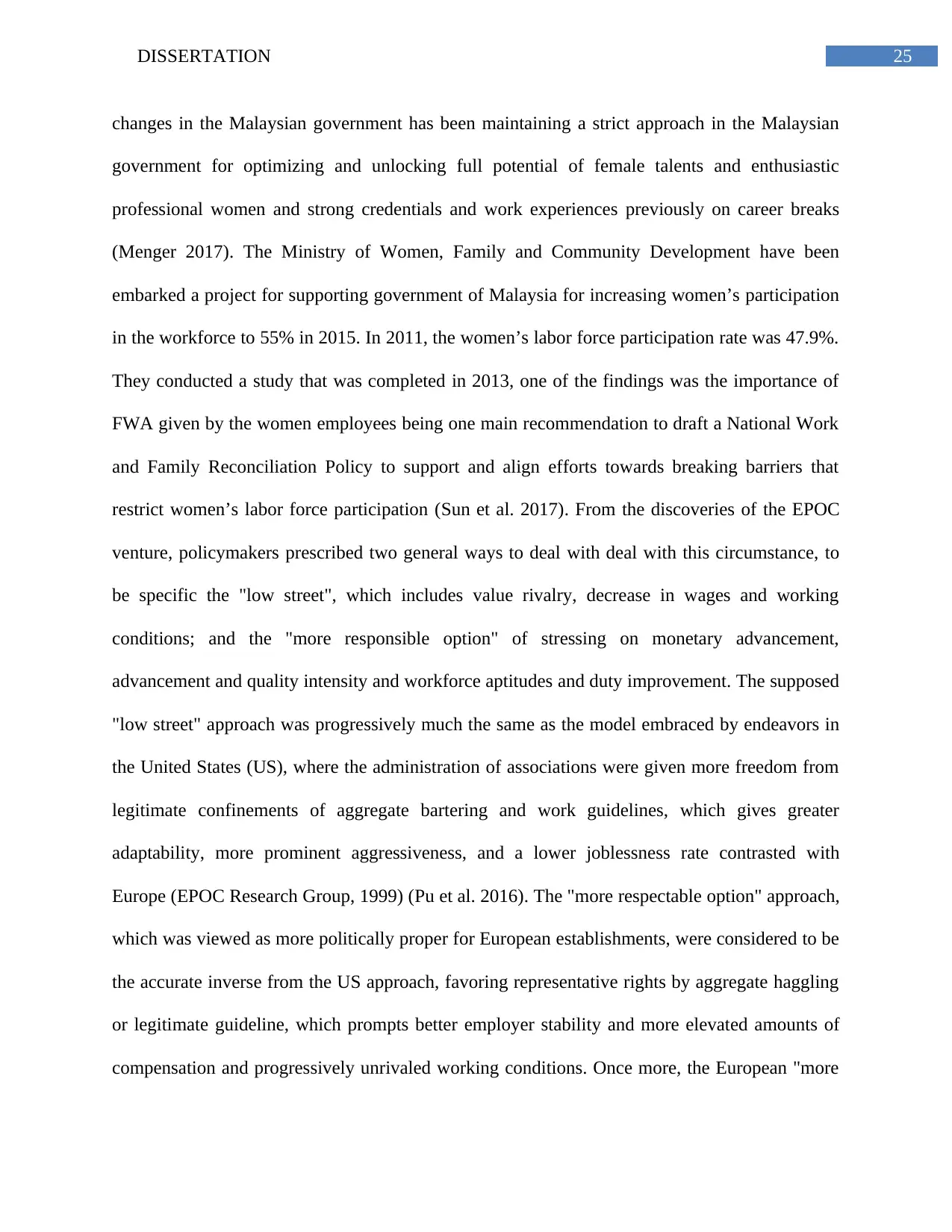
changes in the Malaysian government has been maintaining a strict approach in the Malaysian
government for optimizing and unlocking full potential of female talents and enthusiastic
professional women and strong credentials and work experiences previously on career breaks
(Menger 2017). The Ministry of Women, Family and Community Development have been
embarked a project for supporting government of Malaysia for increasing women’s participation
in the workforce to 55% in 2015. In 2011, the women’s labor force participation rate was 47.9%.
They conducted a study that was completed in 2013, one of the findings was the importance of
FWA given by the women employees being one main recommendation to draft a National Work
and Family Reconciliation Policy to support and align efforts towards breaking barriers that
restrict women’s labor force participation (Sun et al. 2017). From the discoveries of the EPOC
venture, policymakers prescribed two general ways to deal with deal with this circumstance, to
be specific the "low street", which includes value rivalry, decrease in wages and working
conditions; and the "more responsible option" of stressing on monetary advancement,
advancement and quality intensity and workforce aptitudes and duty improvement. The supposed
"low street" approach was progressively much the same as the model embraced by endeavors in
the United States (US), where the administration of associations were given more freedom from
legitimate confinements of aggregate bartering and work guidelines, which gives greater
adaptability, more prominent aggressiveness, and a lower joblessness rate contrasted with
Europe (EPOC Research Group, 1999) (Pu et al. 2016). The "more respectable option" approach,
which was viewed as more politically proper for European establishments, were considered to be
the accurate inverse from the US approach, favoring representative rights by aggregate haggling
or legitimate guideline, which prompts better employer stability and more elevated amounts of
compensation and progressively unrivaled working conditions. Once more, the European "more
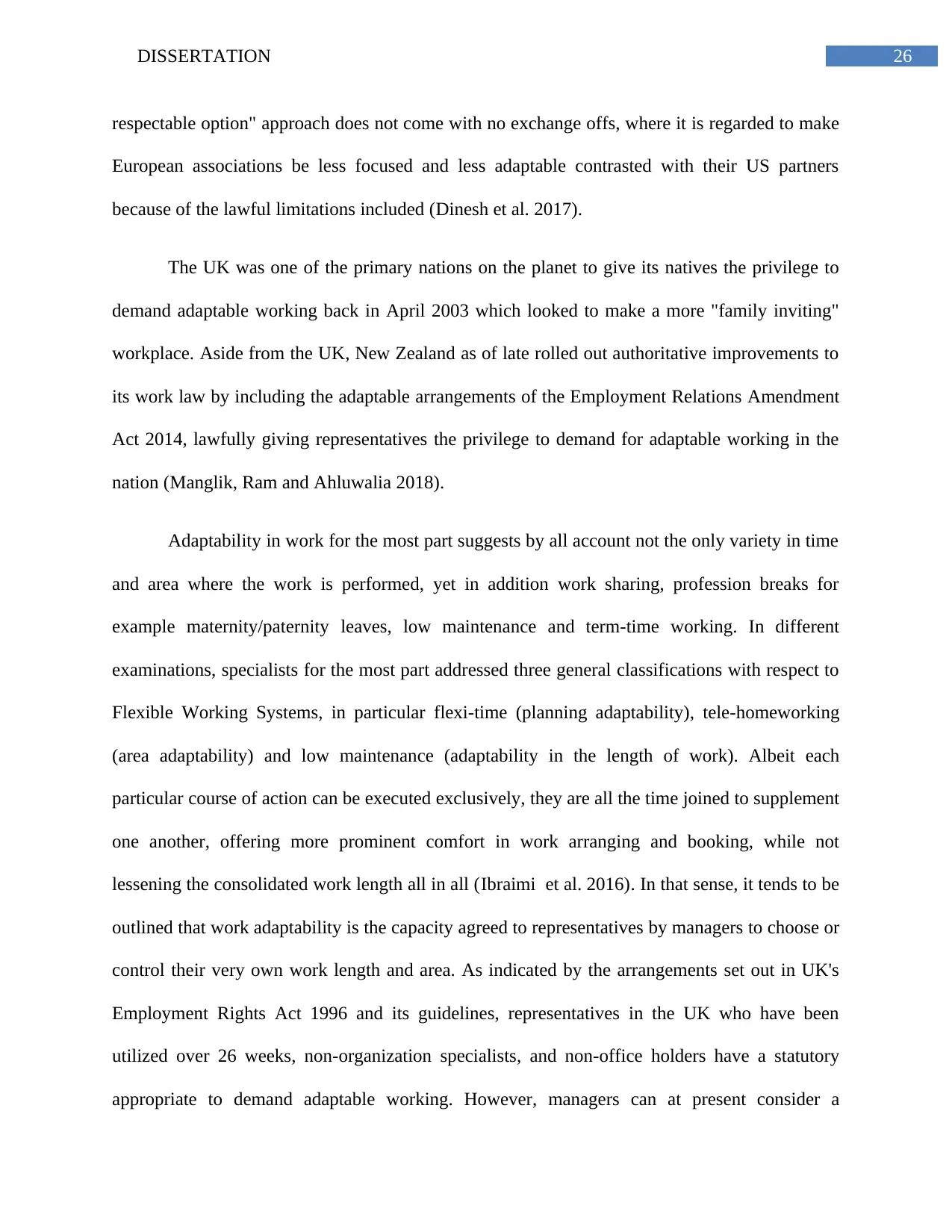
respectable option" approach does not come with no exchange offs, where it is regarded to make
European associations be less focused and less adaptable contrasted with their US partners
because of the lawful limitations included (Dinesh et al. 2017).
The UK was one of the primary nations on the planet to give its natives the privilege to
demand adaptable working back in April 2003 which looked to make a more "family inviting"
workplace. Aside from the UK, New Zealand as of late rolled out authoritative improvements to
its work law by including the adaptable arrangements of the Employment Relations Amendment
Act 2014, lawfully giving representatives the privilege to demand for adaptable working in the
nation (Manglik, Ram and Ahluwalia 2018).
Adaptability in work for the most part suggests by all account not the only variety in time
and area where the work is performed, yet in addition work sharing, profession breaks for
example maternity/paternity leaves, low maintenance and term-time working. In different
examinations, specialists for the most part addressed three general classifications with respect to
Flexible Working Systems, in particular flexi-time (planning adaptability), tele-homeworking
(area adaptability) and low maintenance (adaptability in the length of work). Albeit each
particular course of action can be executed exclusively, they are all the time joined to supplement
one another, offering more prominent comfort in work arranging and booking, while not
lessening the consolidated work length all in all (Ibraimi et al. 2016). In that sense, it tends to be
outlined that work adaptability is the capacity agreed to representatives by managers to choose or
control their very own work length and area. As indicated by the arrangements set out in UK's
Employment Rights Act 1996 and its guidelines, representatives in the UK who have been
utilized over 26 weeks, non-organization specialists, and non-office holders have a statutory
appropriate to demand adaptable working. However, managers can at present consider a
⊘ This is a preview!⊘
Do you want full access?
Subscribe today to unlock all pages.

Trusted by 1+ million students worldwide
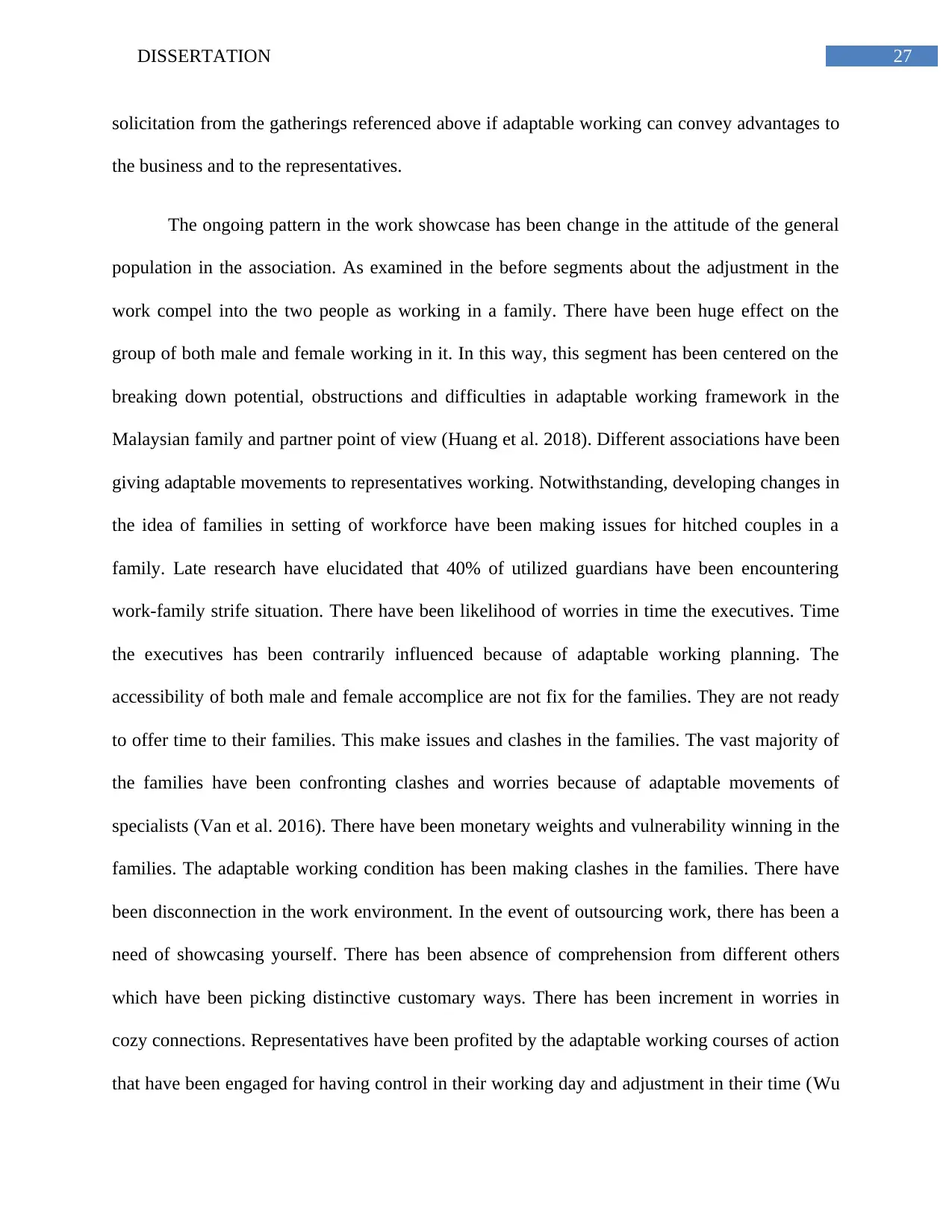
solicitation from the gatherings referenced above if adaptable working can convey advantages to
the business and to the representatives.
The ongoing pattern in the work showcase has been change in the attitude of the general
population in the association. As examined in the before segments about the adjustment in the
work compel into the two people as working in a family. There have been huge effect on the
group of both male and female working in it. In this way, this segment has been centered on the
breaking down potential, obstructions and difficulties in adaptable working framework in the
Malaysian family and partner point of view (Huang et al. 2018). Different associations have been
giving adaptable movements to representatives working. Notwithstanding, developing changes in
the idea of families in setting of workforce have been making issues for hitched couples in a
family. Late research have elucidated that 40% of utilized guardians have been encountering
work-family strife situation. There have been likelihood of worries in time the executives. Time
the executives has been contrarily influenced because of adaptable working planning. The
accessibility of both male and female accomplice are not fix for the families. They are not ready
to offer time to their families. This make issues and clashes in the families. The vast majority of
the families have been confronting clashes and worries because of adaptable movements of
specialists (Van et al. 2016). There have been monetary weights and vulnerability winning in the
families. The adaptable working condition has been making clashes in the families. There have
been disconnection in the work environment. In the event of outsourcing work, there has been a
need of showcasing yourself. There has been absence of comprehension from different others
which have been picking distinctive customary ways. There has been increment in worries in
cozy connections. Representatives have been profited by the adaptable working courses of action
that have been engaged for having control in their working day and adjustment in their time (Wu
Paraphrase This Document
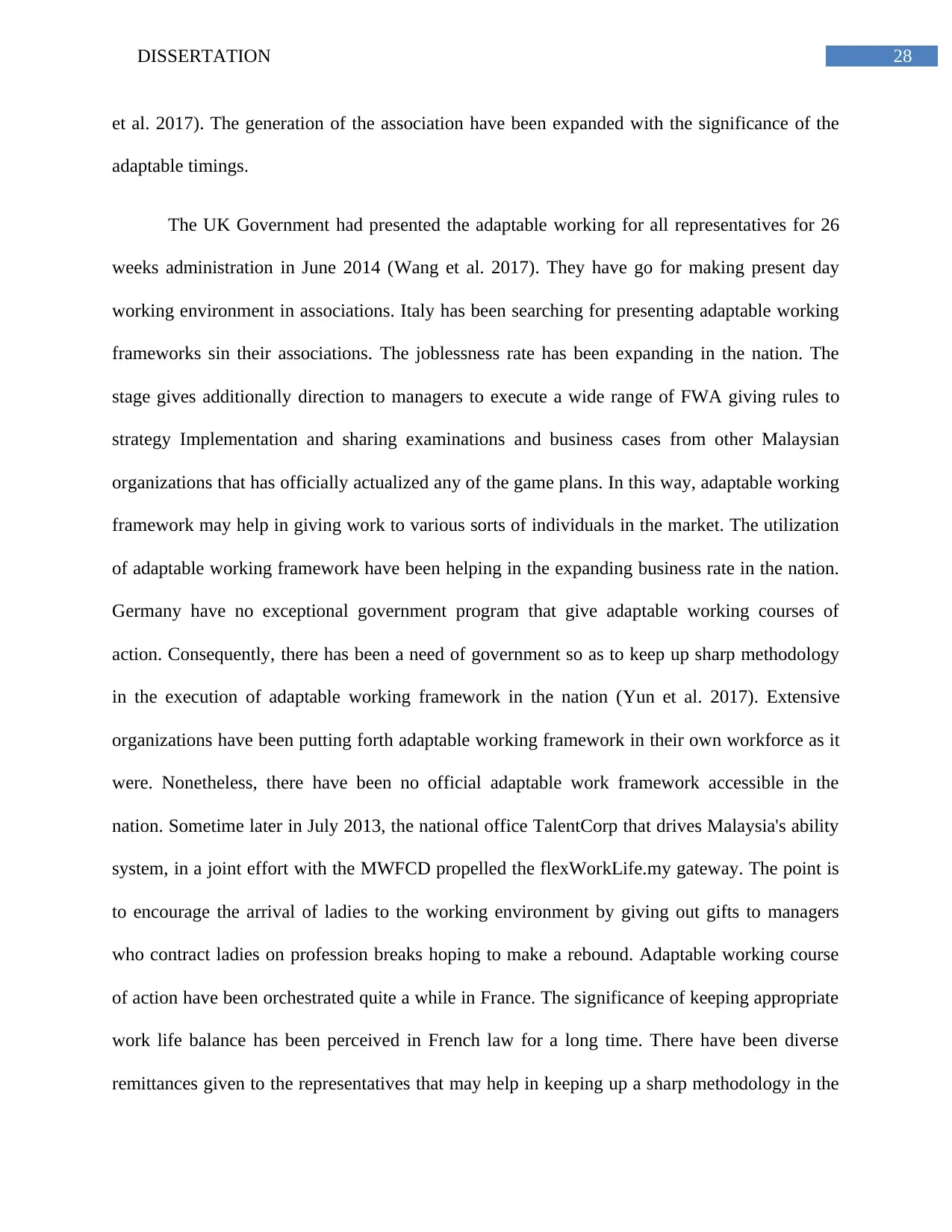
et al. 2017). The generation of the association have been expanded with the significance of the
adaptable timings.
The UK Government had presented the adaptable working for all representatives for 26
weeks administration in June 2014 (Wang et al. 2017). They have go for making present day
working environment in associations. Italy has been searching for presenting adaptable working
frameworks sin their associations. The joblessness rate has been expanding in the nation. The
stage gives additionally direction to managers to execute a wide range of FWA giving rules to
strategy Implementation and sharing examinations and business cases from other Malaysian
organizations that has officially actualized any of the game plans. In this way, adaptable working
framework may help in giving work to various sorts of individuals in the market. The utilization
of adaptable working framework have been helping in the expanding business rate in the nation.
Germany have no exceptional government program that give adaptable working courses of
action. Consequently, there has been a need of government so as to keep up sharp methodology
in the execution of adaptable working framework in the nation (Yun et al. 2017). Extensive
organizations have been putting forth adaptable working framework in their own workforce as it
were. Nonetheless, there have been no official adaptable work framework accessible in the
nation. Sometime later in July 2013, the national office TalentCorp that drives Malaysia's ability
system, in a joint effort with the MWFCD propelled the flexWorkLife.my gateway. The point is
to encourage the arrival of ladies to the working environment by giving out gifts to managers
who contract ladies on profession breaks hoping to make a rebound. Adaptable working course
of action have been orchestrated quite a while in France. The significance of keeping appropriate
work life balance has been perceived in French law for a long time. There have been diverse
remittances given to the representatives that may help in keeping up a sharp methodology in the
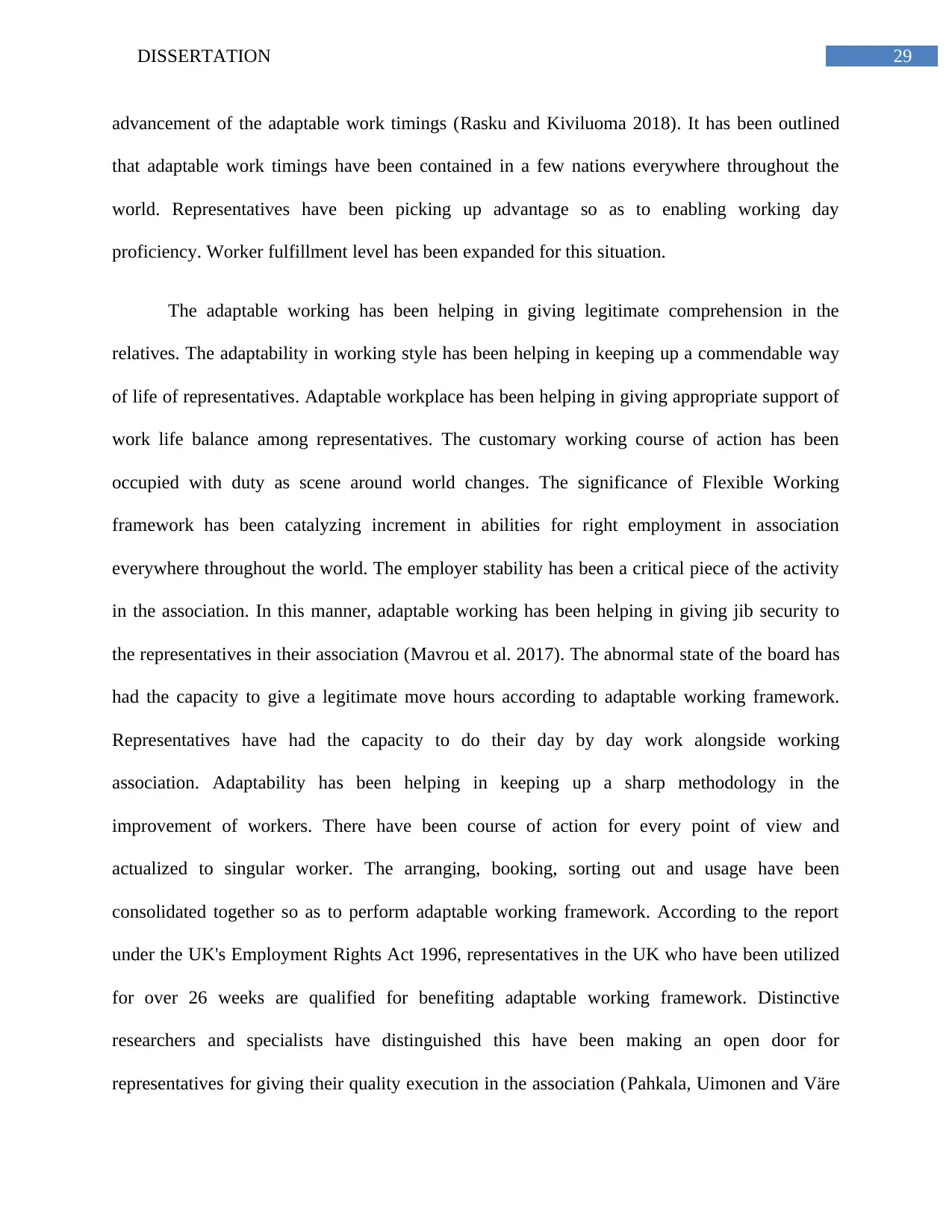
advancement of the adaptable work timings (Rasku and Kiviluoma 2018). It has been outlined
that adaptable work timings have been contained in a few nations everywhere throughout the
world. Representatives have been picking up advantage so as to enabling working day
proficiency. Worker fulfillment level has been expanded for this situation.
The adaptable working has been helping in giving legitimate comprehension in the
relatives. The adaptability in working style has been helping in keeping up a commendable way
of life of representatives. Adaptable workplace has been helping in giving appropriate support of
work life balance among representatives. The customary working course of action has been
occupied with duty as scene around world changes. The significance of Flexible Working
framework has been catalyzing increment in abilities for right employment in association
everywhere throughout the world. The employer stability has been a critical piece of the activity
in the association. In this manner, adaptable working has been helping in giving jib security to
the representatives in their association (Mavrou et al. 2017). The abnormal state of the board has
had the capacity to give a legitimate move hours according to adaptable working framework.
Representatives have had the capacity to do their day by day work alongside working
association. Adaptability has been helping in keeping up a sharp methodology in the
improvement of workers. There have been course of action for every point of view and
actualized to singular worker. The arranging, booking, sorting out and usage have been
consolidated together so as to perform adaptable working framework. According to the report
under the UK's Employment Rights Act 1996, representatives in the UK who have been utilized
for over 26 weeks are qualified for benefiting adaptable working framework. Distinctive
researchers and specialists have distinguished this have been making an open door for
representatives for giving their quality execution in the association (Pahkala, Uimonen and Väre
⊘ This is a preview!⊘
Do you want full access?
Subscribe today to unlock all pages.

Trusted by 1+ million students worldwide
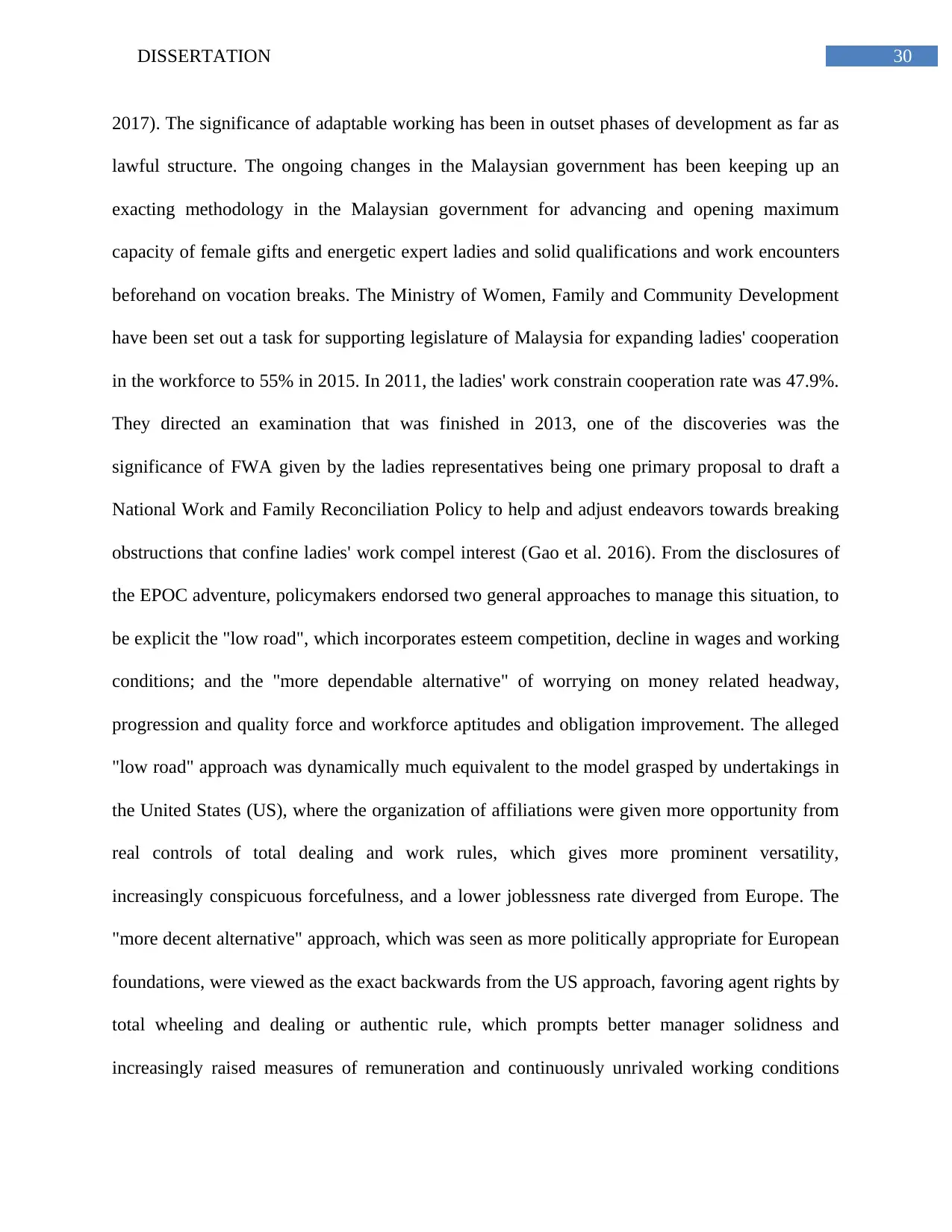
2017). The significance of adaptable working has been in outset phases of development as far as
lawful structure. The ongoing changes in the Malaysian government has been keeping up an
exacting methodology in the Malaysian government for advancing and opening maximum
capacity of female gifts and energetic expert ladies and solid qualifications and work encounters
beforehand on vocation breaks. The Ministry of Women, Family and Community Development
have been set out a task for supporting legislature of Malaysia for expanding ladies' cooperation
in the workforce to 55% in 2015. In 2011, the ladies' work constrain cooperation rate was 47.9%.
They directed an examination that was finished in 2013, one of the discoveries was the
significance of FWA given by the ladies representatives being one primary proposal to draft a
National Work and Family Reconciliation Policy to help and adjust endeavors towards breaking
obstructions that confine ladies' work compel interest (Gao et al. 2016). From the disclosures of
the EPOC adventure, policymakers endorsed two general approaches to manage this situation, to
be explicit the "low road", which incorporates esteem competition, decline in wages and working
conditions; and the "more dependable alternative" of worrying on money related headway,
progression and quality force and workforce aptitudes and obligation improvement. The alleged
"low road" approach was dynamically much equivalent to the model grasped by undertakings in
the United States (US), where the organization of affiliations were given more opportunity from
real controls of total dealing and work rules, which gives more prominent versatility,
increasingly conspicuous forcefulness, and a lower joblessness rate diverged from Europe. The
"more decent alternative" approach, which was seen as more politically appropriate for European
foundations, were viewed as the exact backwards from the US approach, favoring agent rights by
total wheeling and dealing or authentic rule, which prompts better manager solidness and
increasingly raised measures of remuneration and continuously unrivaled working conditions
Paraphrase This Document
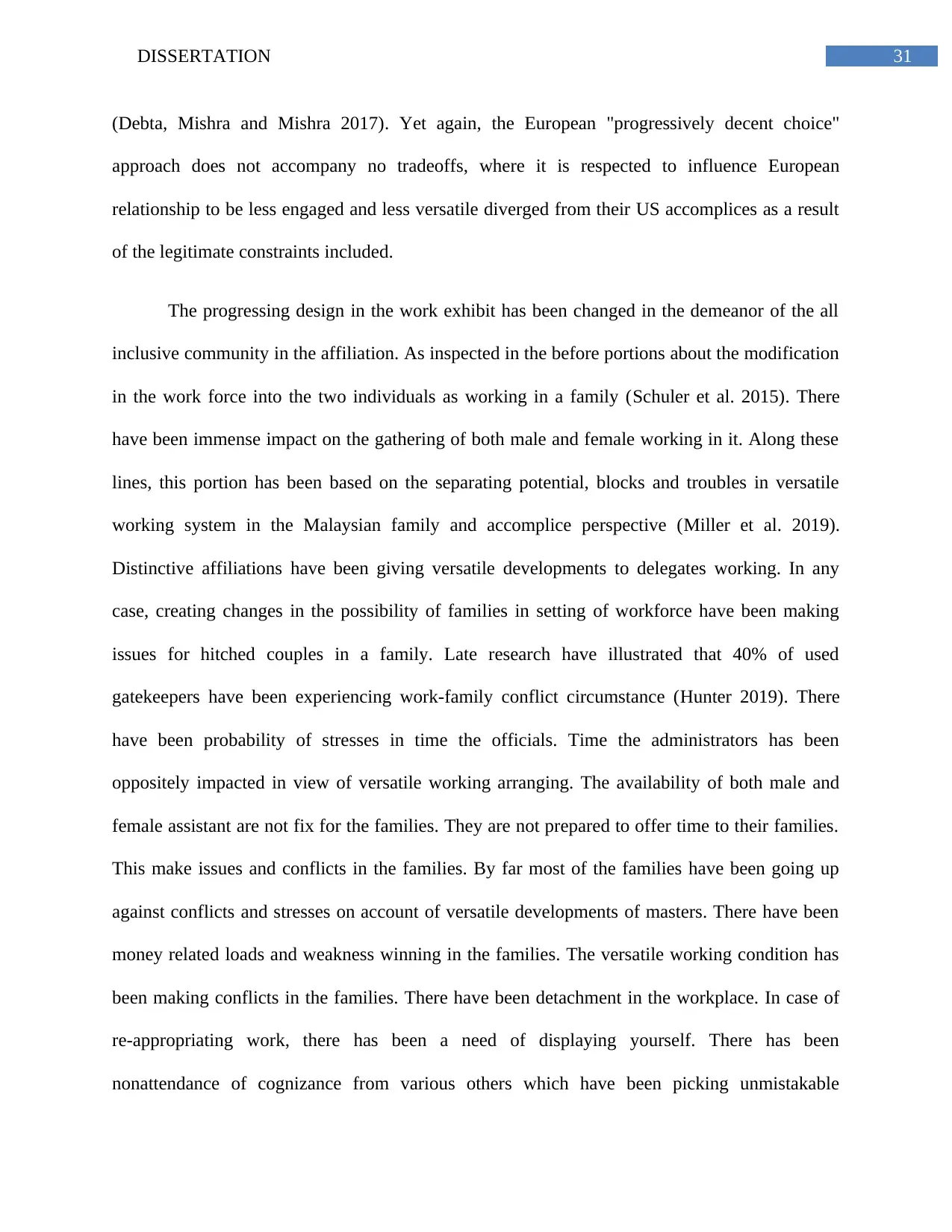
(Debta, Mishra and Mishra 2017). Yet again, the European "progressively decent choice"
approach does not accompany no tradeoffs, where it is respected to influence European
relationship to be less engaged and less versatile diverged from their US accomplices as a result
of the legitimate constraints included.
The progressing design in the work exhibit has been changed in the demeanor of the all
inclusive community in the affiliation. As inspected in the before portions about the modification
in the work force into the two individuals as working in a family (Schuler et al. 2015). There
have been immense impact on the gathering of both male and female working in it. Along these
lines, this portion has been based on the separating potential, blocks and troubles in versatile
working system in the Malaysian family and accomplice perspective (Miller et al. 2019).
Distinctive affiliations have been giving versatile developments to delegates working. In any
case, creating changes in the possibility of families in setting of workforce have been making
issues for hitched couples in a family. Late research have illustrated that 40% of used
gatekeepers have been experiencing work-family conflict circumstance (Hunter 2019). There
have been probability of stresses in time the officials. Time the administrators has been
oppositely impacted in view of versatile working arranging. The availability of both male and
female assistant are not fix for the families. They are not prepared to offer time to their families.
This make issues and conflicts in the families. By far most of the families have been going up
against conflicts and stresses on account of versatile developments of masters. There have been
money related loads and weakness winning in the families. The versatile working condition has
been making conflicts in the families. There have been detachment in the workplace. In case of
re-appropriating work, there has been a need of displaying yourself. There has been
nonattendance of cognizance from various others which have been picking unmistakable
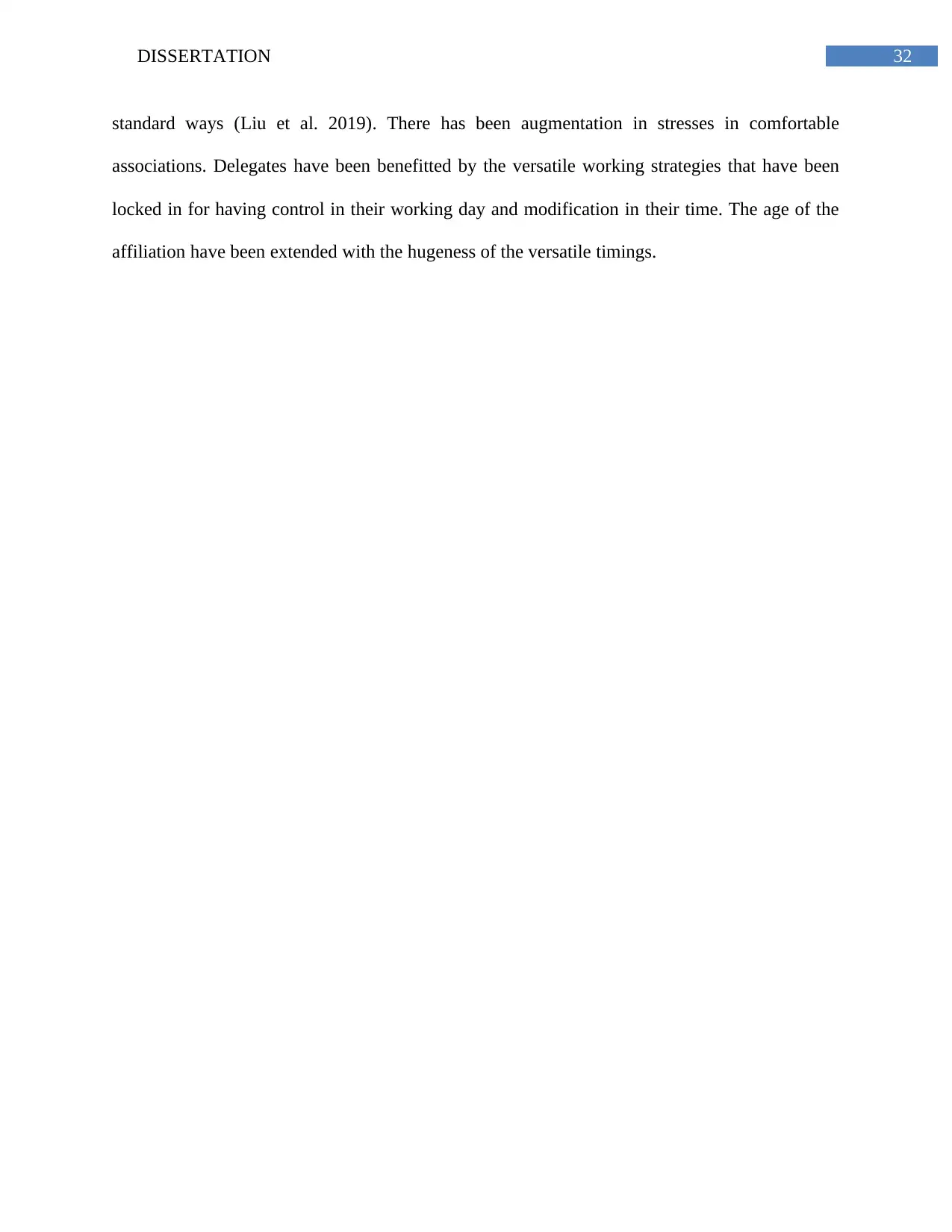
standard ways (Liu et al. 2019). There has been augmentation in stresses in comfortable
associations. Delegates have been benefitted by the versatile working strategies that have been
locked in for having control in their working day and modification in their time. The age of the
affiliation have been extended with the hugeness of the versatile timings.
⊘ This is a preview!⊘
Do you want full access?
Subscribe today to unlock all pages.

Trusted by 1+ million students worldwide
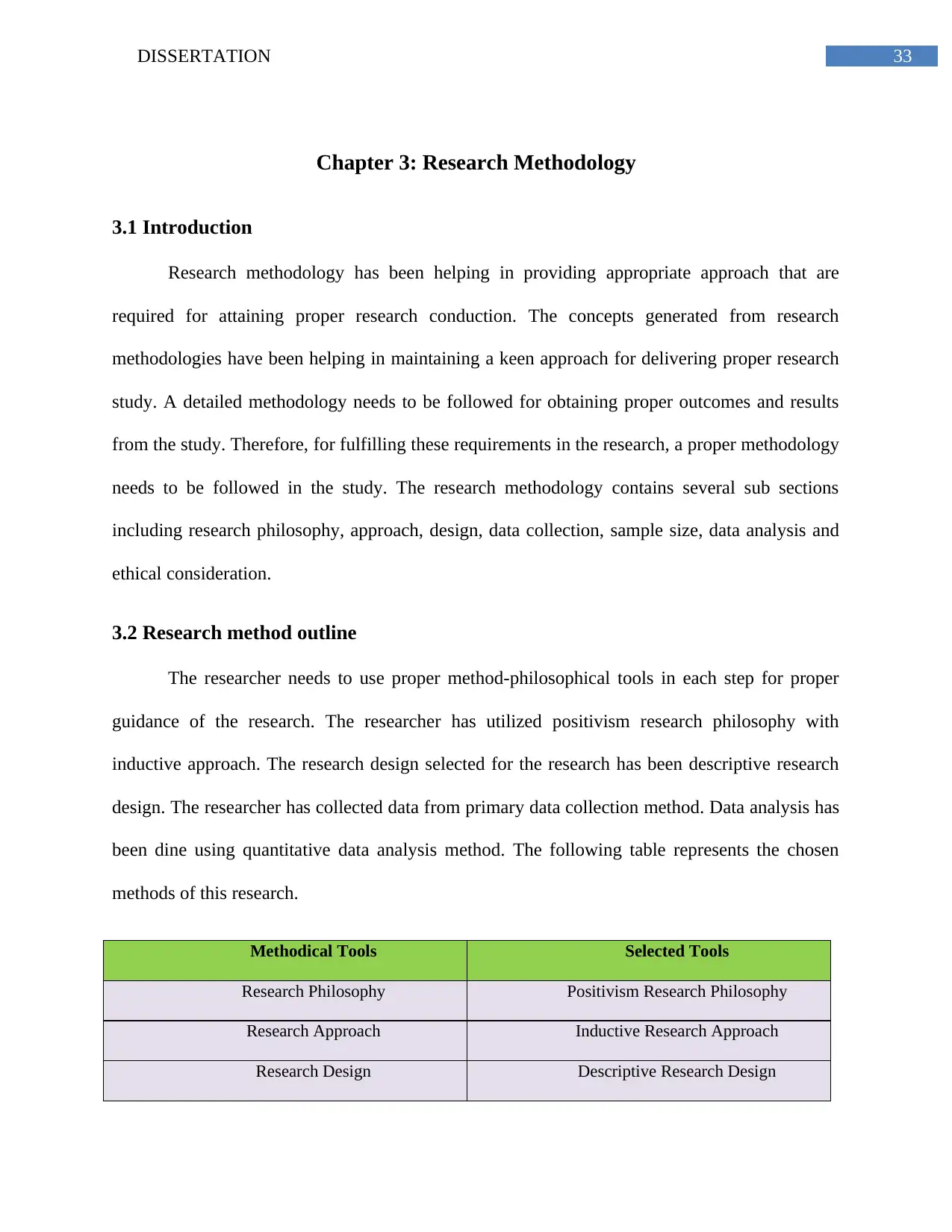
Chapter 3: Research Methodology
3.1 Introduction
Research methodology has been helping in providing appropriate approach that are
required for attaining proper research conduction. The concepts generated from research
methodologies have been helping in maintaining a keen approach for delivering proper research
study. A detailed methodology needs to be followed for obtaining proper outcomes and results
from the study. Therefore, for fulfilling these requirements in the research, a proper methodology
needs to be followed in the study. The research methodology contains several sub sections
including research philosophy, approach, design, data collection, sample size, data analysis and
ethical consideration.
3.2 Research method outline
The researcher needs to use proper method-philosophical tools in each step for proper
guidance of the research. The researcher has utilized positivism research philosophy with
inductive approach. The research design selected for the research has been descriptive research
design. The researcher has collected data from primary data collection method. Data analysis has
been dine using quantitative data analysis method. The following table represents the chosen
methods of this research.
Methodical Tools Selected Tools
Research Philosophy Positivism Research Philosophy
Research Approach Inductive Research Approach
Research Design Descriptive Research Design
Paraphrase This Document
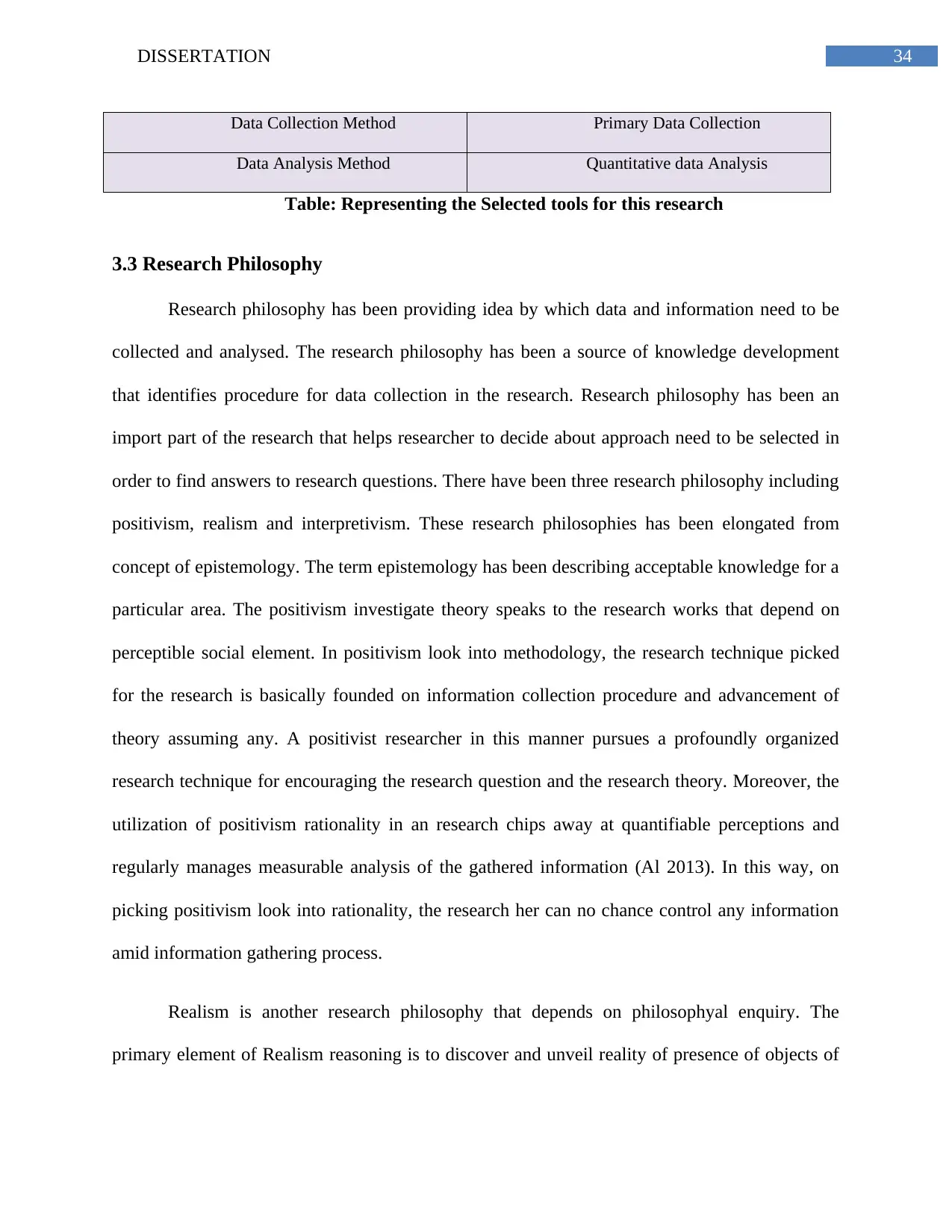
Data Collection Method Primary Data Collection
Data Analysis Method Quantitative data Analysis
Table: Representing the Selected tools for this research
3.3 Research Philosophy
Research philosophy has been providing idea by which data and information need to be
collected and analysed. The research philosophy has been a source of knowledge development
that identifies procedure for data collection in the research. Research philosophy has been an
import part of the research that helps researcher to decide about approach need to be selected in
order to find answers to research questions. There have been three research philosophy including
positivism, realism and interpretivism. These research philosophies has been elongated from
concept of epistemology. The term epistemology has been describing acceptable knowledge for a
particular area. The positivism investigate theory speaks to the research works that depend on
perceptible social element. In positivism look into methodology, the research technique picked
for the research is basically founded on information collection procedure and advancement of
theory assuming any. A positivist researcher in this manner pursues a profoundly organized
research technique for encouraging the research question and the research theory. Moreover, the
utilization of positivism rationality in an research chips away at quantifiable perceptions and
regularly manages measurable analysis of the gathered information (Al 2013). In this way, on
picking positivism look into rationality, the research her can no chance control any information
amid information gathering process.
Realism is another research philosophy that depends on philosophyal enquiry. The
primary element of Realism reasoning is to discover and unveil reality of presence of objects of
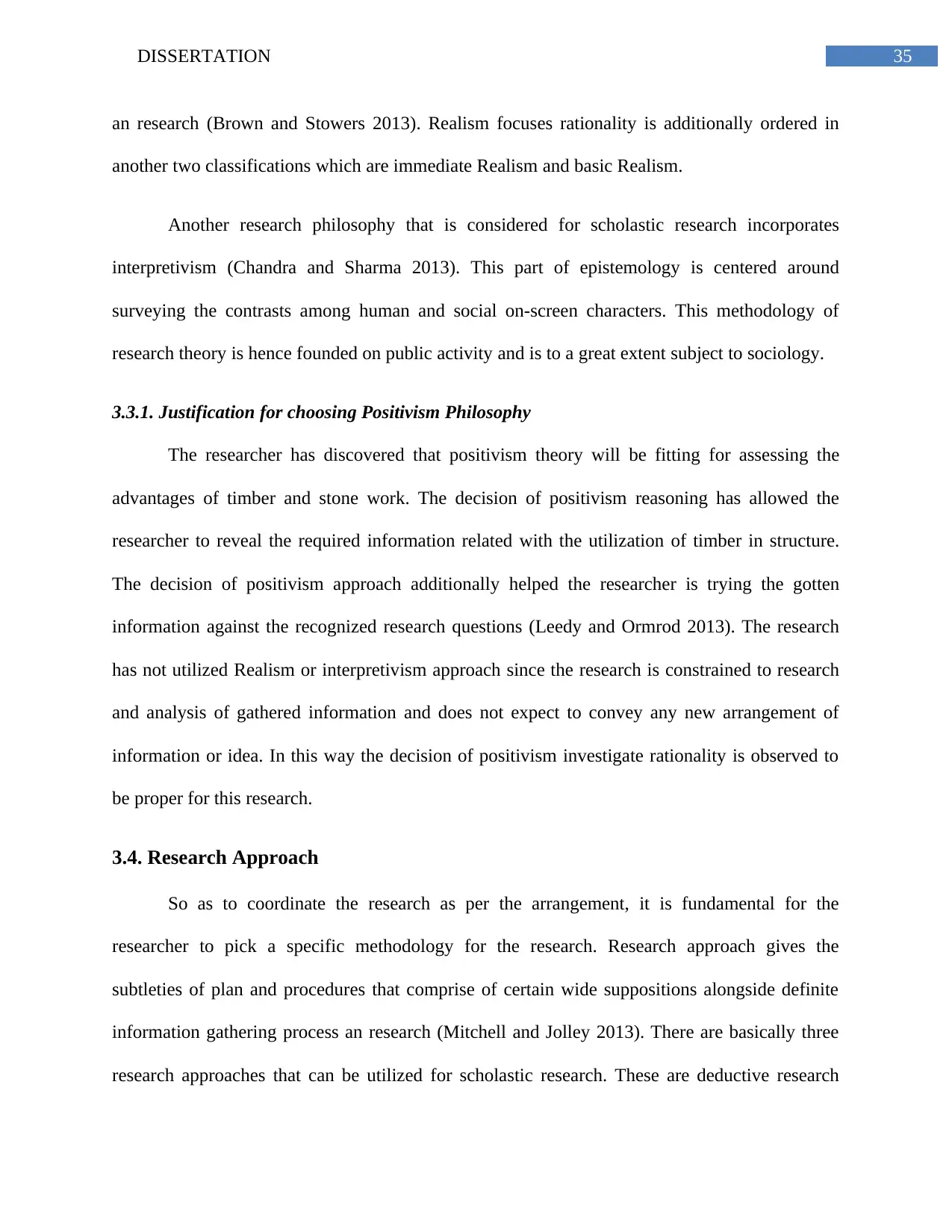
an research (Brown and Stowers 2013). Realism focuses rationality is additionally ordered in
another two classifications which are immediate Realism and basic Realism.
Another research philosophy that is considered for scholastic research incorporates
interpretivism (Chandra and Sharma 2013). This part of epistemology is centered around
surveying the contrasts among human and social on-screen characters. This methodology of
research theory is hence founded on public activity and is to a great extent subject to sociology.
3.3.1. Justification for choosing Positivism Philosophy
The researcher has discovered that positivism theory will be fitting for assessing the
advantages of timber and stone work. The decision of positivism reasoning has allowed the
researcher to reveal the required information related with the utilization of timber in structure.
The decision of positivism approach additionally helped the researcher is trying the gotten
information against the recognized research questions (Leedy and Ormrod 2013). The research
has not utilized Realism or interpretivism approach since the research is constrained to research
and analysis of gathered information and does not expect to convey any new arrangement of
information or idea. In this way the decision of positivism investigate rationality is observed to
be proper for this research.
3.4. Research Approach
So as to coordinate the research as per the arrangement, it is fundamental for the
researcher to pick a specific methodology for the research. Research approach gives the
subtleties of plan and procedures that comprise of certain wide suppositions alongside definite
information gathering process an research (Mitchell and Jolley 2013). There are basically three
research approaches that can be utilized for scholastic research. These are deductive research
⊘ This is a preview!⊘
Do you want full access?
Subscribe today to unlock all pages.

Trusted by 1+ million students worldwide
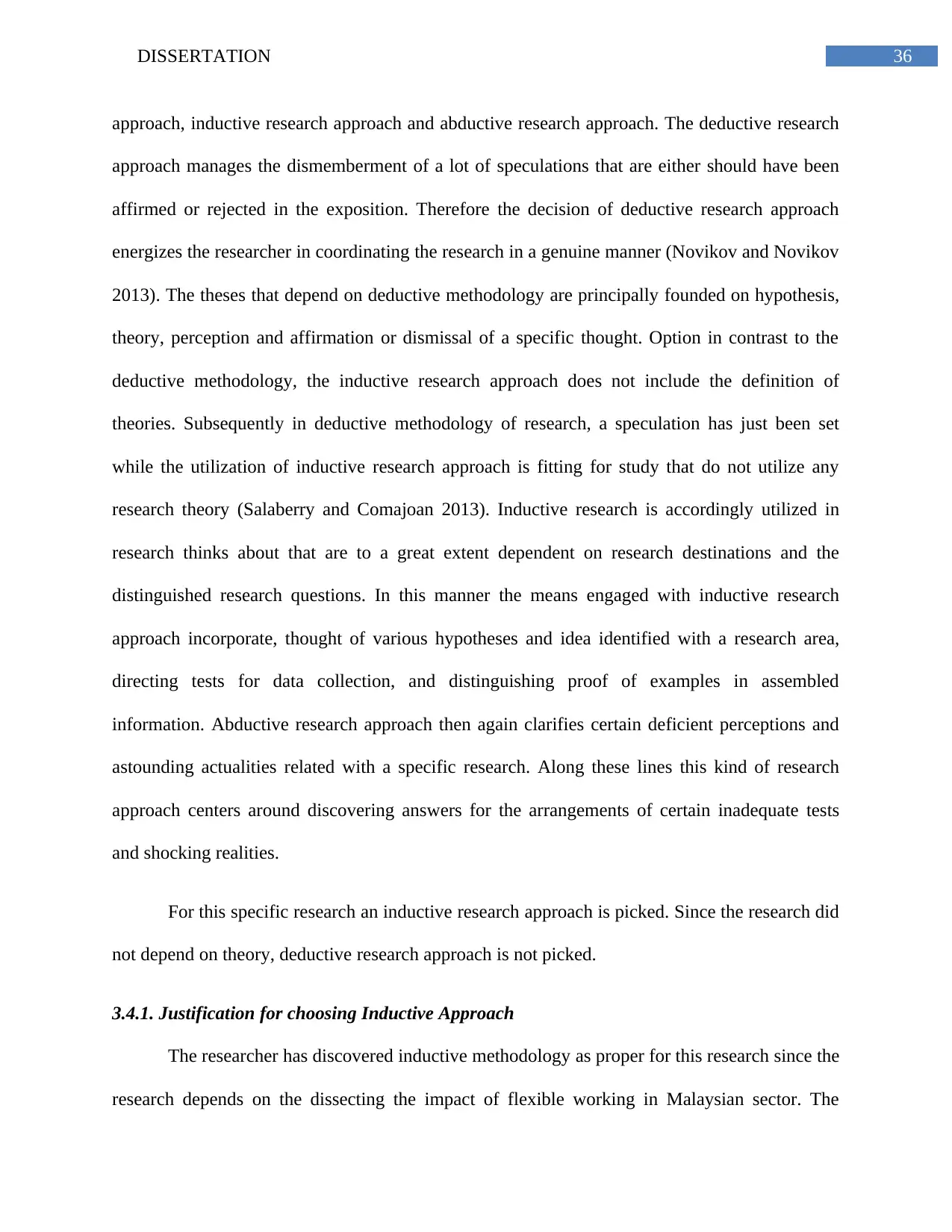
approach, inductive research approach and abductive research approach. The deductive research
approach manages the dismemberment of a lot of speculations that are either should have been
affirmed or rejected in the exposition. Therefore the decision of deductive research approach
energizes the researcher in coordinating the research in a genuine manner (Novikov and Novikov
2013). The theses that depend on deductive methodology are principally founded on hypothesis,
theory, perception and affirmation or dismissal of a specific thought. Option in contrast to the
deductive methodology, the inductive research approach does not include the definition of
theories. Subsequently in deductive methodology of research, a speculation has just been set
while the utilization of inductive research approach is fitting for study that do not utilize any
research theory (Salaberry and Comajoan 2013). Inductive research is accordingly utilized in
research thinks about that are to a great extent dependent on research destinations and the
distinguished research questions. In this manner the means engaged with inductive research
approach incorporate, thought of various hypotheses and idea identified with a research area,
directing tests for data collection, and distinguishing proof of examples in assembled
information. Abductive research approach then again clarifies certain deficient perceptions and
astounding actualities related with a specific research. Along these lines this kind of research
approach centers around discovering answers for the arrangements of certain inadequate tests
and shocking realities.
For this specific research an inductive research approach is picked. Since the research did
not depend on theory, deductive research approach is not picked.
3.4.1. Justification for choosing Inductive Approach
The researcher has discovered inductive methodology as proper for this research since the
research depends on the dissecting the impact of flexible working in Malaysian sector. The
Paraphrase This Document
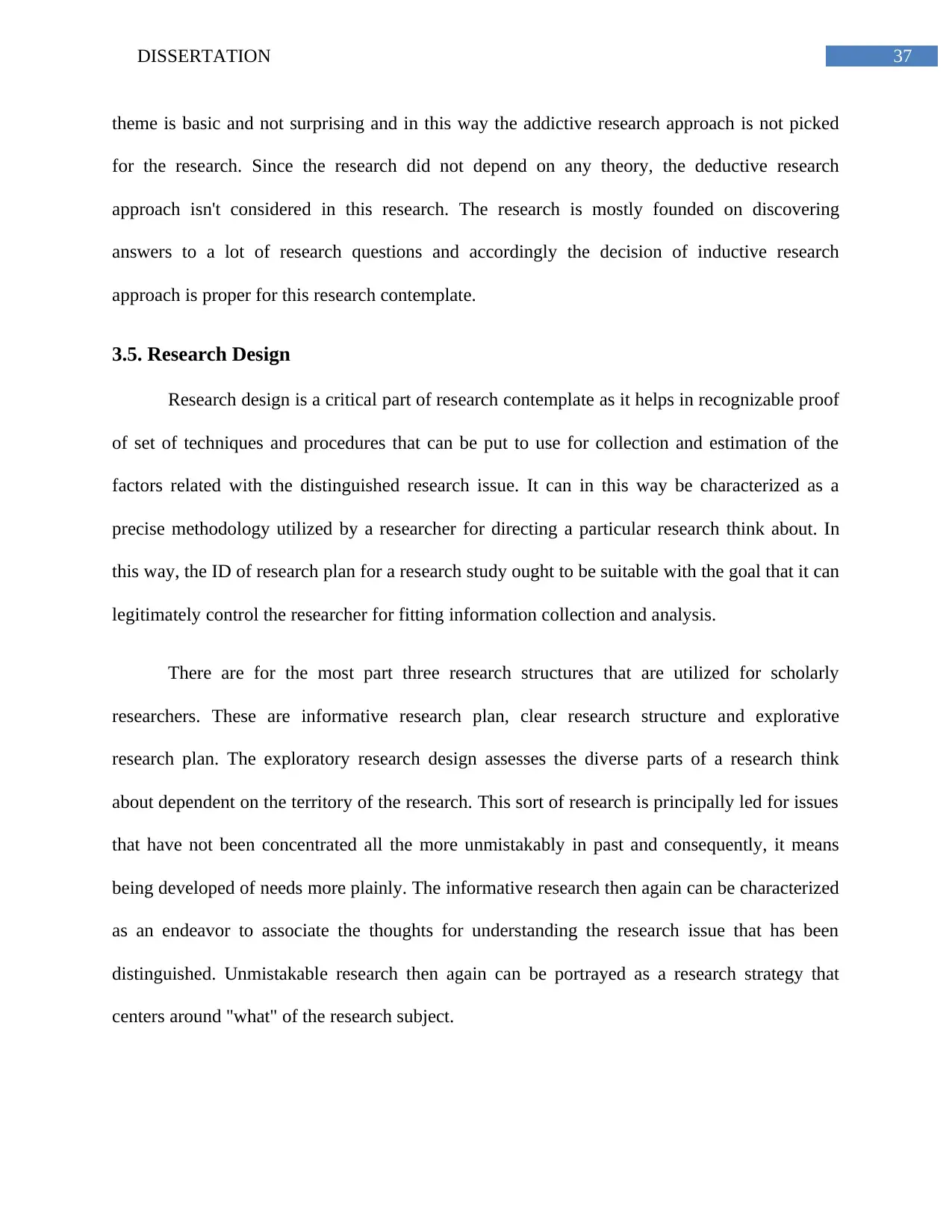
theme is basic and not surprising and in this way the addictive research approach is not picked
for the research. Since the research did not depend on any theory, the deductive research
approach isn't considered in this research. The research is mostly founded on discovering
answers to a lot of research questions and accordingly the decision of inductive research
approach is proper for this research contemplate.
3.5. Research Design
Research design is a critical part of research contemplate as it helps in recognizable proof
of set of techniques and procedures that can be put to use for collection and estimation of the
factors related with the distinguished research issue. It can in this way be characterized as a
precise methodology utilized by a researcher for directing a particular research think about. In
this way, the ID of research plan for a research study ought to be suitable with the goal that it can
legitimately control the researcher for fitting information collection and analysis.
There are for the most part three research structures that are utilized for scholarly
researchers. These are informative research plan, clear research structure and explorative
research plan. The exploratory research design assesses the diverse parts of a research think
about dependent on the territory of the research. This sort of research is principally led for issues
that have not been concentrated all the more unmistakably in past and consequently, it means
being developed of needs more plainly. The informative research then again can be characterized
as an endeavor to associate the thoughts for understanding the research issue that has been
distinguished. Unmistakable research then again can be portrayed as a research strategy that
centers around "what" of the research subject.
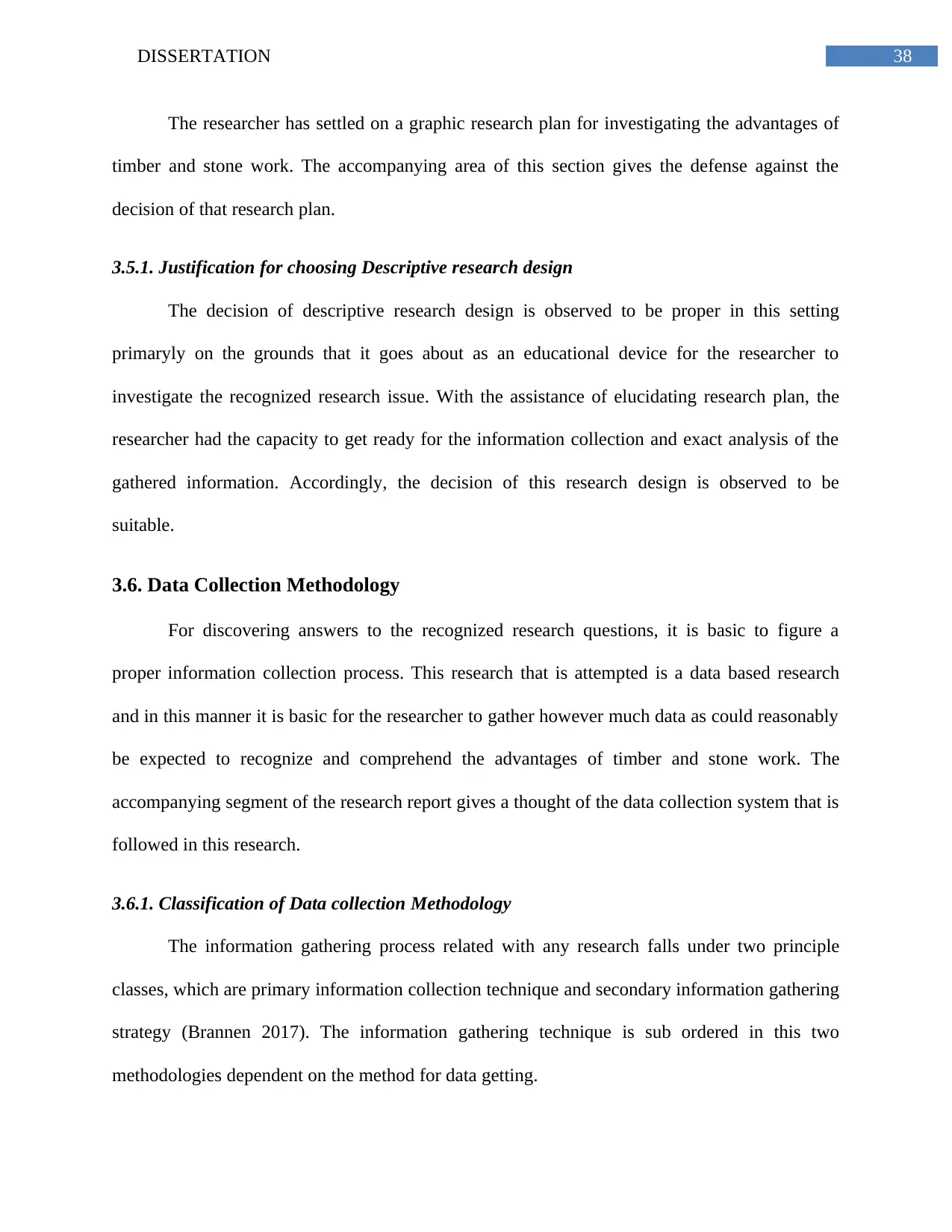
The researcher has settled on a graphic research plan for investigating the advantages of
timber and stone work. The accompanying area of this section gives the defense against the
decision of that research plan.
3.5.1. Justification for choosing Descriptive research design
The decision of descriptive research design is observed to be proper in this setting
primaryly on the grounds that it goes about as an educational device for the researcher to
investigate the recognized research issue. With the assistance of elucidating research plan, the
researcher had the capacity to get ready for the information collection and exact analysis of the
gathered information. Accordingly, the decision of this research design is observed to be
suitable.
3.6. Data Collection Methodology
For discovering answers to the recognized research questions, it is basic to figure a
proper information collection process. This research that is attempted is a data based research
and in this manner it is basic for the researcher to gather however much data as could reasonably
be expected to recognize and comprehend the advantages of timber and stone work. The
accompanying segment of the research report gives a thought of the data collection system that is
followed in this research.
3.6.1. Classification of Data collection Methodology
The information gathering process related with any research falls under two principle
classes, which are primary information collection technique and secondary information gathering
strategy (Brannen 2017). The information gathering technique is sub ordered in this two
methodologies dependent on the method for data getting.
⊘ This is a preview!⊘
Do you want full access?
Subscribe today to unlock all pages.

Trusted by 1+ million students worldwide

Primary Data Collection: Primary data collection alludes to the procedure of data
gathering from those sources that have a firsthand information about the research that is being
led (Bernard 2017). There are various methodologies that can be utilized for social occasion and
collection of primary information. These incorporate, holding meeting, perceptions and utilizing
poll to perform reviews. This wellsprings of data is alluded to as primary sources predominantly
in light of the fact that it tends to be effectively regulated. Meetings for primary information
gathering can be performed face to face or can be performed on telephonic way (Punch 2013).
The most broadly utilized methodology for primary information gathering incorporates
collection of information from reviews and meetings.
Secondary Data Collection: The secondary data collection process is a strategy for data
collection from the sources that have been recently distributed, for example, books, diaries and
research papers. Hence from the optional sources a great deal of data can be gathered (Brannen
2017). Nonetheless, the data that are acquired from the secondary sources are dependable yet
can't be expressed as unique. The optional information collection process regularly ends up good
for an researcher for the most part since it helps in gathering of immense measure of information
that are valid and genuine.
Frequently the researchers utilize both primary information and secondary information as
the information collection technique with a point of gathering of information from both primary
and optional sources. This kind of research strategy is called blended research technique.
Selected Data Collection Method
The information gathering strategy that is chosen for this research is primary data
collection process. The researcher has played out a meeting to gather information that would
Paraphrase This Document
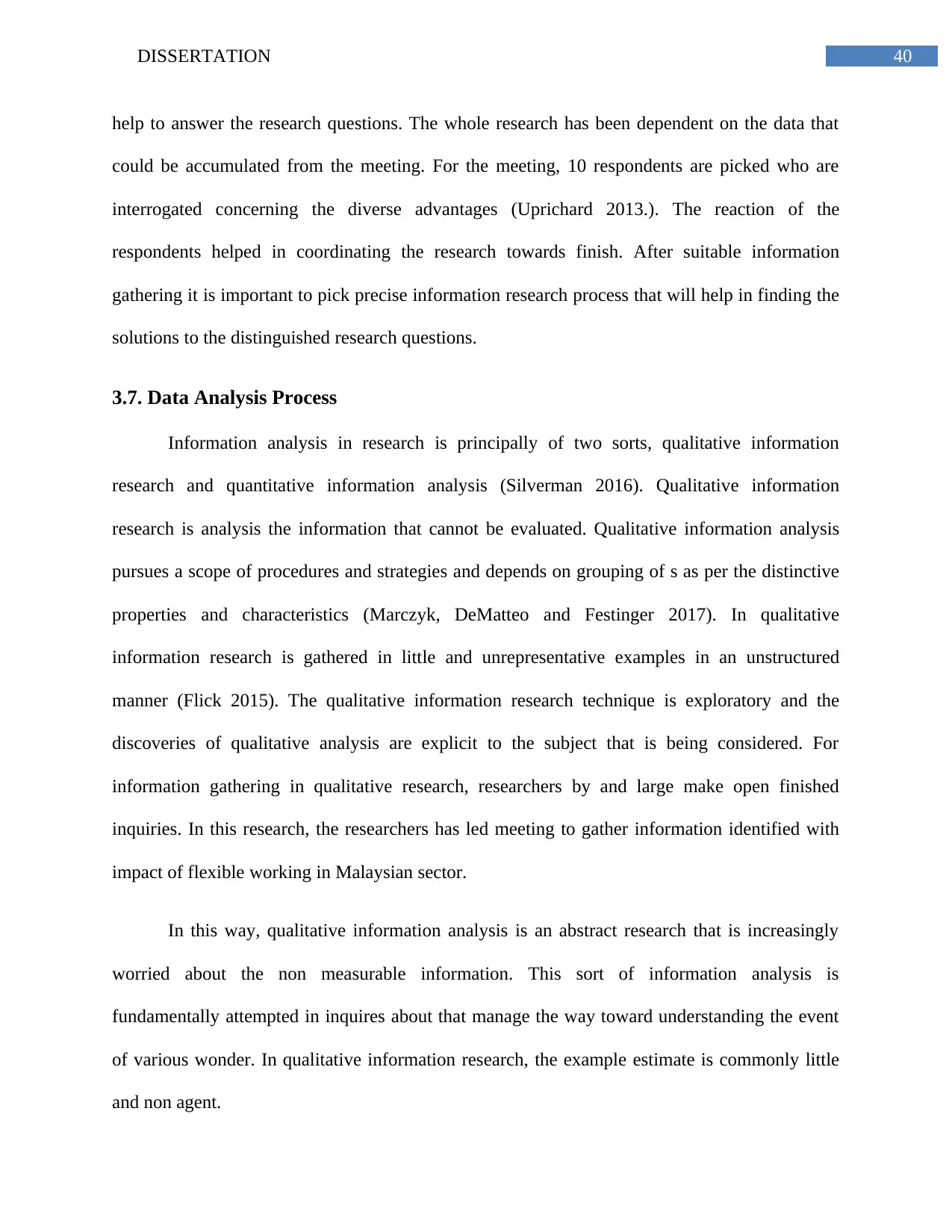
help to answer the research questions. The whole research has been dependent on the data that
could be accumulated from the meeting. For the meeting, 10 respondents are picked who are
interrogated concerning the diverse advantages (Uprichard 2013.). The reaction of the
respondents helped in coordinating the research towards finish. After suitable information
gathering it is important to pick precise information research process that will help in finding the
solutions to the distinguished research questions.
3.7. Data Analysis Process
Information analysis in research is principally of two sorts, qualitative information
research and quantitative information analysis (Silverman 2016). Qualitative information
research is analysis the information that cannot be evaluated. Qualitative information analysis
pursues a scope of procedures and strategies and depends on grouping of s as per the distinctive
properties and characteristics (Marczyk, DeMatteo and Festinger 2017). In qualitative
information research is gathered in little and unrepresentative examples in an unstructured
manner (Flick 2015). The qualitative information research technique is exploratory and the
discoveries of qualitative analysis are explicit to the subject that is being considered. For
information gathering in qualitative research, researchers by and large make open finished
inquiries. In this research, the researchers has led meeting to gather information identified with
impact of flexible working in Malaysian sector.
In this way, qualitative information analysis is an abstract research that is increasingly
worried about the non measurable information. This sort of information analysis is
fundamentally attempted in inquires about that manage the way toward understanding the event
of various wonder. In qualitative information research, the example estimate is commonly little
and non agent.
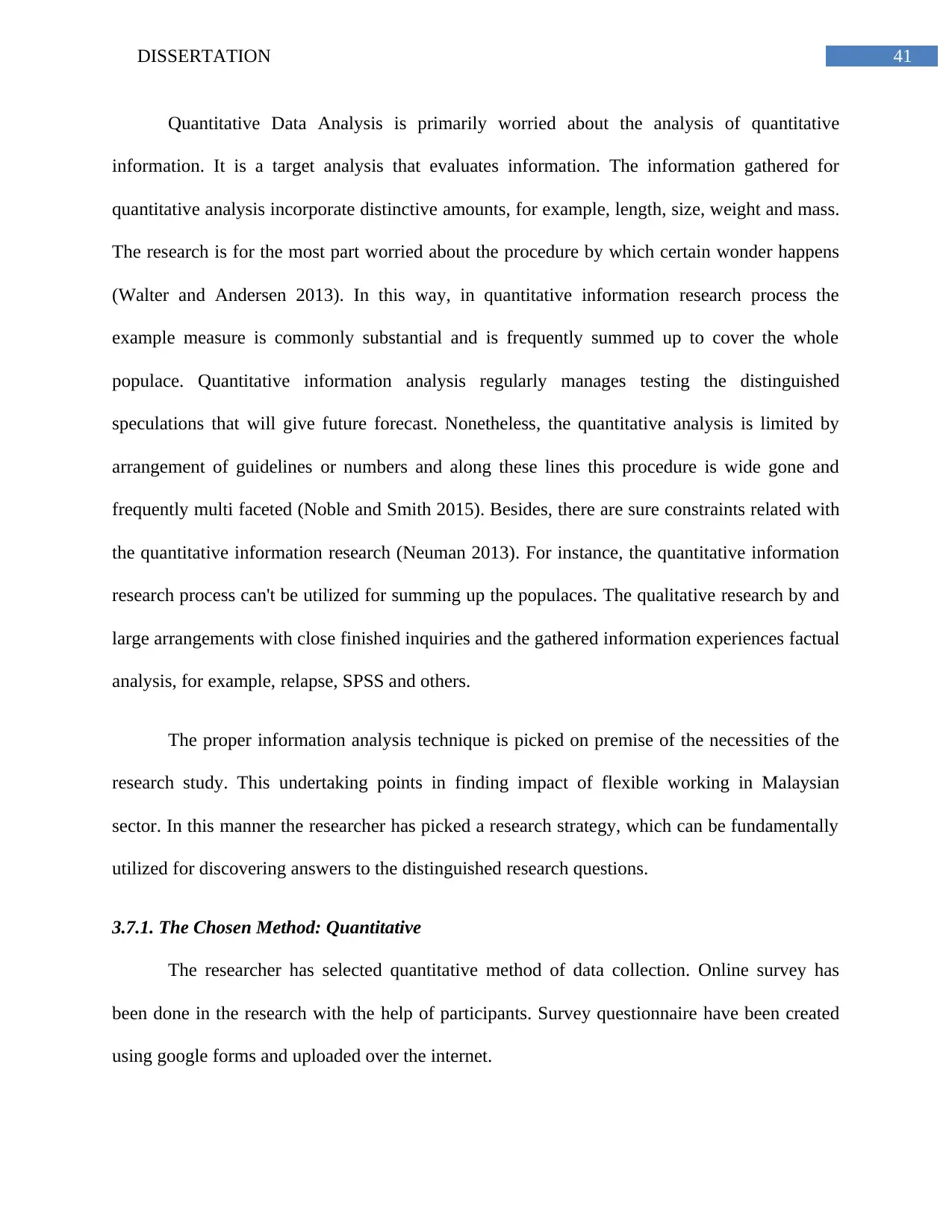
Quantitative Data Analysis is primarily worried about the analysis of quantitative
information. It is a target analysis that evaluates information. The information gathered for
quantitative analysis incorporate distinctive amounts, for example, length, size, weight and mass.
The research is for the most part worried about the procedure by which certain wonder happens
(Walter and Andersen 2013). In this way, in quantitative information research process the
example measure is commonly substantial and is frequently summed up to cover the whole
populace. Quantitative information analysis regularly manages testing the distinguished
speculations that will give future forecast. Nonetheless, the quantitative analysis is limited by
arrangement of guidelines or numbers and along these lines this procedure is wide gone and
frequently multi faceted (Noble and Smith 2015). Besides, there are sure constraints related with
the quantitative information research (Neuman 2013). For instance, the quantitative information
research process can't be utilized for summing up the populaces. The qualitative research by and
large arrangements with close finished inquiries and the gathered information experiences factual
analysis, for example, relapse, SPSS and others.
The proper information analysis technique is picked on premise of the necessities of the
research study. This undertaking points in finding impact of flexible working in Malaysian
sector. In this manner the researcher has picked a research strategy, which can be fundamentally
utilized for discovering answers to the distinguished research questions.
3.7.1. The Chosen Method: Quantitative
The researcher has selected quantitative method of data collection. Online survey has
been done in the research with the help of participants. Survey questionnaire have been created
using google forms and uploaded over the internet.
⊘ This is a preview!⊘
Do you want full access?
Subscribe today to unlock all pages.

Trusted by 1+ million students worldwide
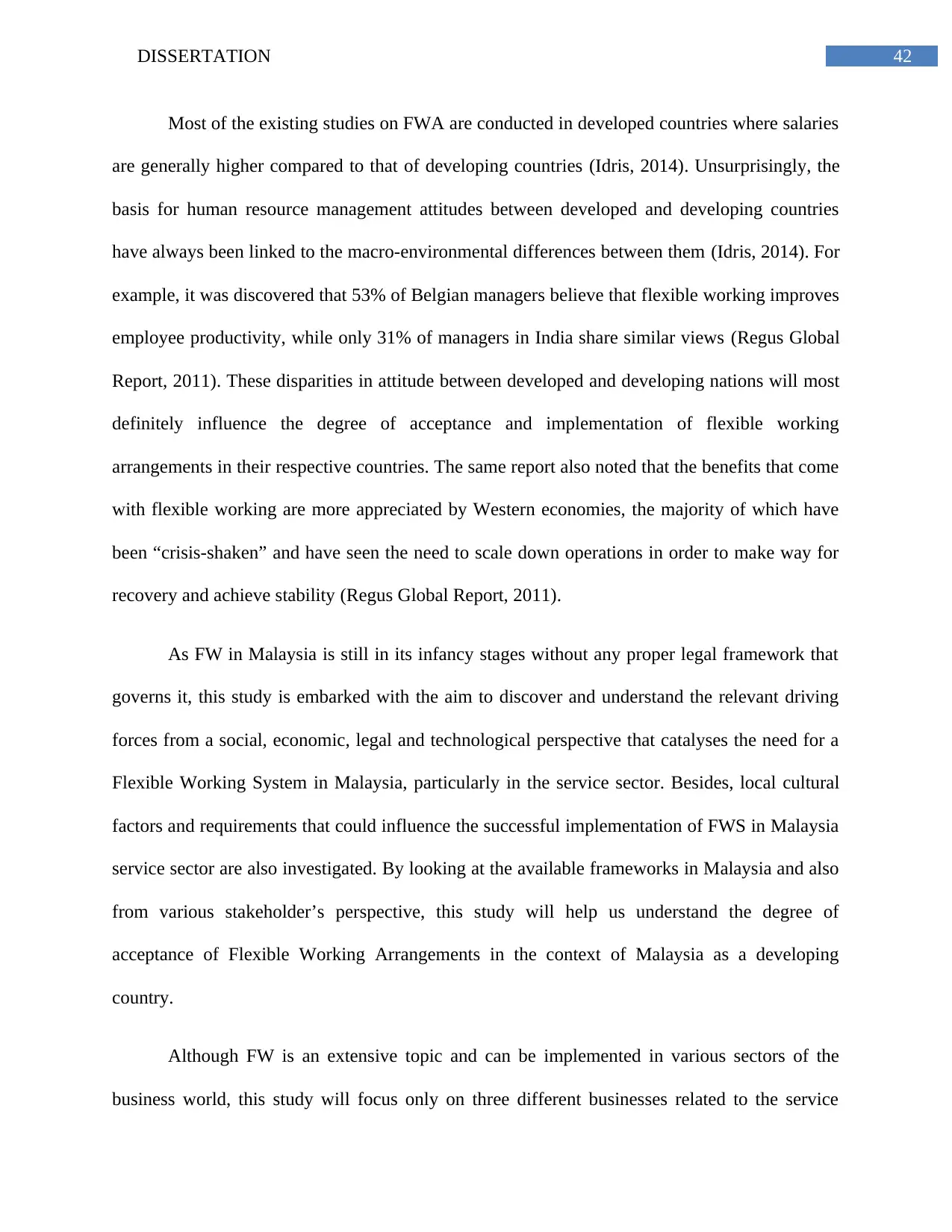
Most of the existing studies on FWA are conducted in developed countries where salaries
are generally higher compared to that of developing countries (Idris, 2014). Unsurprisingly, the
basis for human resource management attitudes between developed and developing countries
have always been linked to the macro-environmental differences between them (Idris, 2014). For
example, it was discovered that 53% of Belgian managers believe that flexible working improves
employee productivity, while only 31% of managers in India share similar views (Regus Global
Report, 2011). These disparities in attitude between developed and developing nations will most
definitely influence the degree of acceptance and implementation of flexible working
arrangements in their respective countries. The same report also noted that the benefits that come
with flexible working are more appreciated by Western economies, the majority of which have
been “crisis-shaken” and have seen the need to scale down operations in order to make way for
recovery and achieve stability (Regus Global Report, 2011).
As FW in Malaysia is still in its infancy stages without any proper legal framework that
governs it, this study is embarked with the aim to discover and understand the relevant driving
forces from a social, economic, legal and technological perspective that catalyses the need for a
Flexible Working System in Malaysia, particularly in the service sector. Besides, local cultural
factors and requirements that could influence the successful implementation of FWS in Malaysia
service sector are also investigated. By looking at the available frameworks in Malaysia and also
from various stakeholder’s perspective, this study will help us understand the degree of
acceptance of Flexible Working Arrangements in the context of Malaysia as a developing
country.
Although FW is an extensive topic and can be implemented in various sectors of the
business world, this study will focus only on three different businesses related to the service
Paraphrase This Document
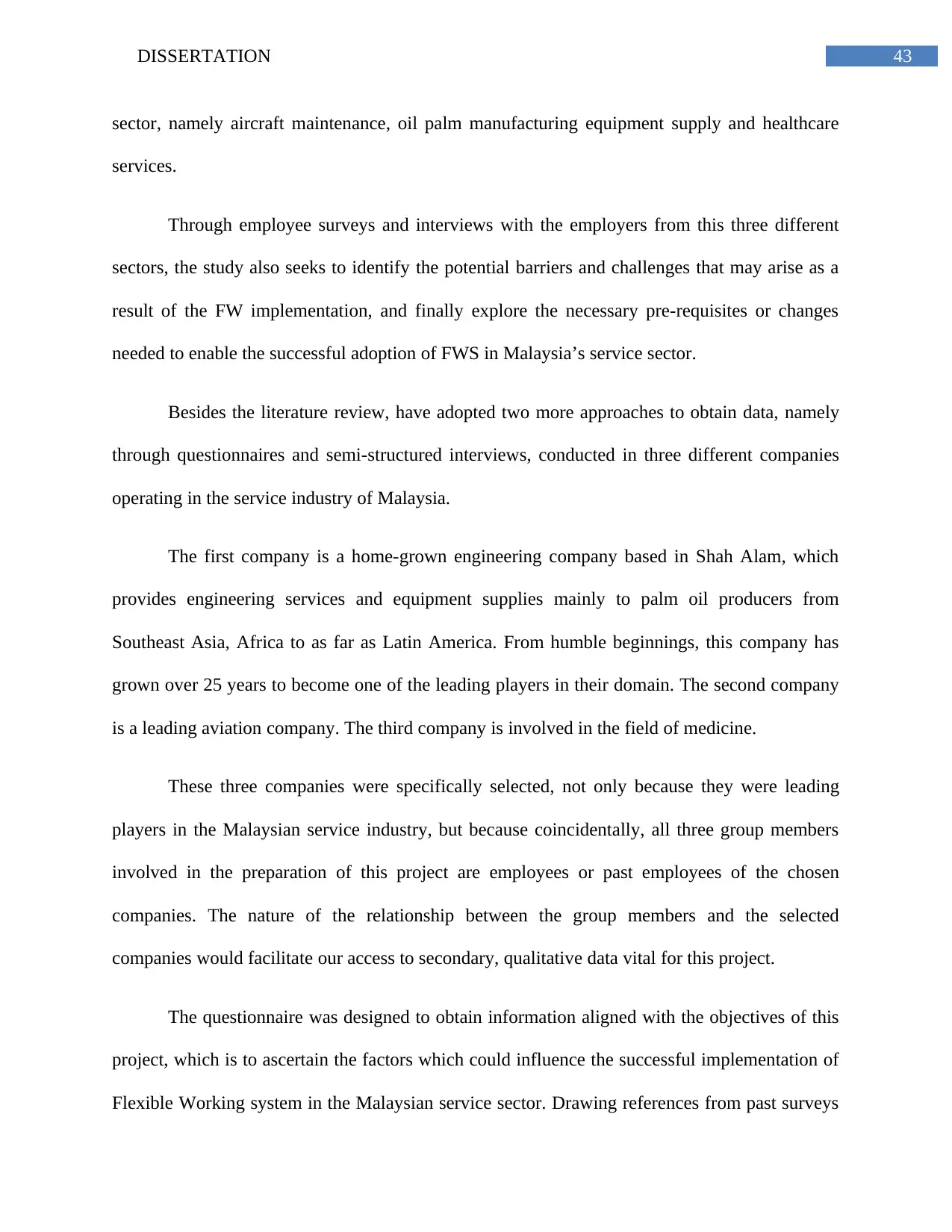
sector, namely aircraft maintenance, oil palm manufacturing equipment supply and healthcare
services.
Through employee surveys and interviews with the employers from this three different
sectors, the study also seeks to identify the potential barriers and challenges that may arise as a
result of the FW implementation, and finally explore the necessary pre-requisites or changes
needed to enable the successful adoption of FWS in Malaysia’s service sector.
Besides the literature review, have adopted two more approaches to obtain data, namely
through questionnaires and semi-structured interviews, conducted in three different companies
operating in the service industry of Malaysia.
The first company is a home-grown engineering company based in Shah Alam, which
provides engineering services and equipment supplies mainly to palm oil producers from
Southeast Asia, Africa to as far as Latin America. From humble beginnings, this company has
grown over 25 years to become one of the leading players in their domain. The second company
is a leading aviation company. The third company is involved in the field of medicine.
These three companies were specifically selected, not only because they were leading
players in the Malaysian service industry, but because coincidentally, all three group members
involved in the preparation of this project are employees or past employees of the chosen
companies. The nature of the relationship between the group members and the selected
companies would facilitate our access to secondary, qualitative data vital for this project.
The questionnaire was designed to obtain information aligned with the objectives of this
project, which is to ascertain the factors which could influence the successful implementation of
Flexible Working system in the Malaysian service sector. Drawing references from past surveys

conducted by the Australian Government on Flexible Working, the group decided to prepare the
survey questions and conduct the survey via an online survey platform provided by the university
known as Qualtrics (http://strathbusiness.qualtrics.com). This set of thirty six questions was
divided into five sections:
A little bit about yourself
This section contains four questions designed to obtain some personal information about the
respondent, namely age, gender, marital status, and number of dependents.
About the company that you currently work in
This section serves to understand the nature of business of the respondent’s company, how long
have they worked for that company, current positions, job band, type of employments and
income groups.
Uptake and perceptions of flexible work in the Malaysian service sector
To understand the various factors that influence the acceptance and perception of employees
towards Flexible Working, the closed questions for this section were designed to probe the
respondents’ awareness and understanding of Flexible Working in Malaysia, impacts of Flexible
Working towards performance and quality of life as a whole, as well as factors that would make
for its successful implementation in the company.
The group initially mooted the idea of having more open-ended questions, but in the end decided
on only closed questions which could yield data suitable for quantitative analysis by adopting the
5-point Likert scale (Strongly agree, Somewhat agree, Neither agree nor disagree, Somewhat
disagree, Strongly disagree) for degrees of agreement (Saunders, Lewis, & Thornhill, 2009), due
to concerns of the possibility of receiving random or irrelevant answers by respondents.
⊘ This is a preview!⊘
Do you want full access?
Subscribe today to unlock all pages.

Trusted by 1+ million students worldwide
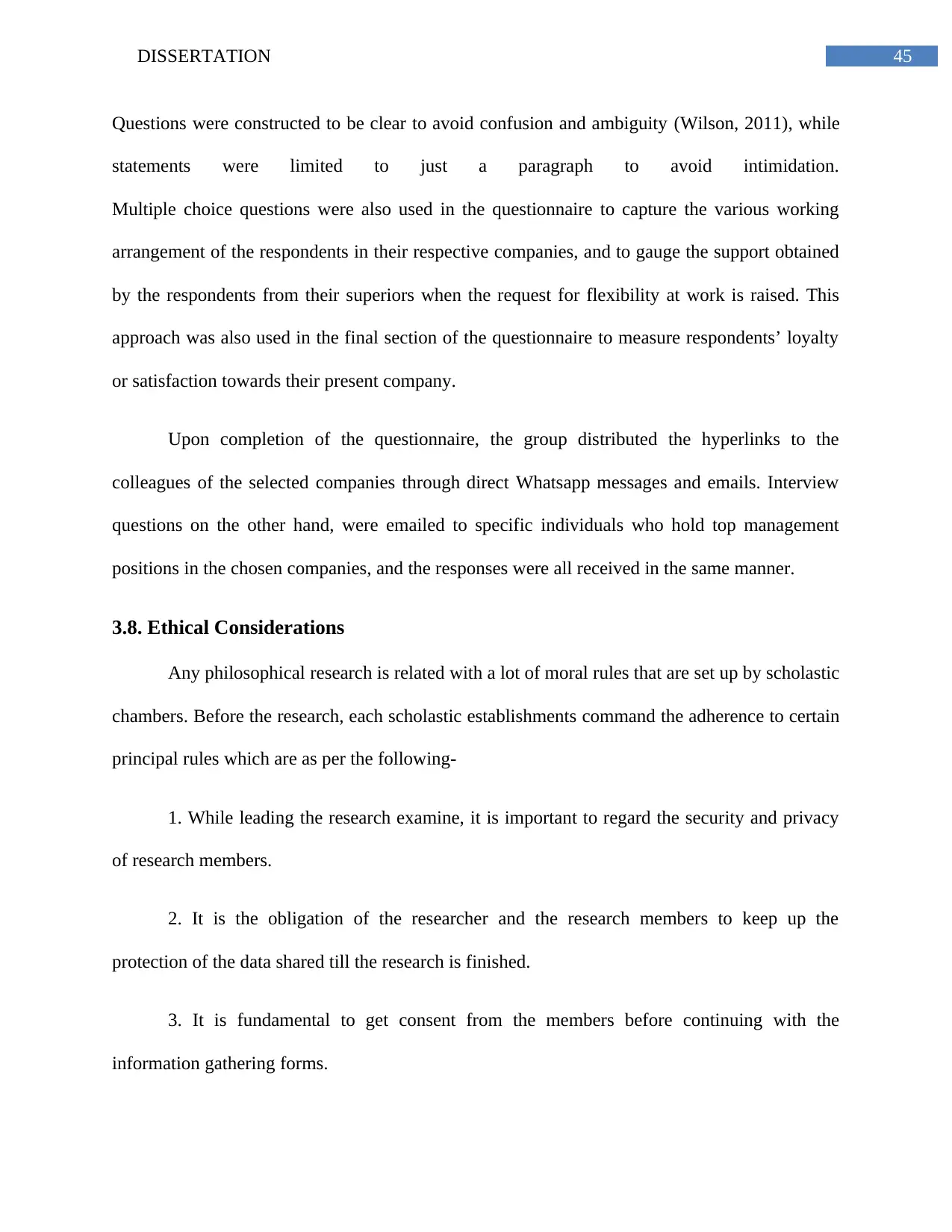
Questions were constructed to be clear to avoid confusion and ambiguity (Wilson, 2011), while
statements were limited to just a paragraph to avoid intimidation.
Multiple choice questions were also used in the questionnaire to capture the various working
arrangement of the respondents in their respective companies, and to gauge the support obtained
by the respondents from their superiors when the request for flexibility at work is raised. This
approach was also used in the final section of the questionnaire to measure respondents’ loyalty
or satisfaction towards their present company.
Upon completion of the questionnaire, the group distributed the hyperlinks to the
colleagues of the selected companies through direct Whatsapp messages and emails. Interview
questions on the other hand, were emailed to specific individuals who hold top management
positions in the chosen companies, and the responses were all received in the same manner.
3.8. Ethical Considerations
Any philosophical research is related with a lot of moral rules that are set up by scholastic
chambers. Before the research, each scholastic establishments command the adherence to certain
principal rules which are as per the following-
1. While leading the research examine, it is important to regard the security and privacy
of research members.
2. It is the obligation of the researcher and the research members to keep up the
protection of the data shared till the research is finished.
3. It is fundamental to get consent from the members before continuing with the
information gathering forms.
Paraphrase This Document
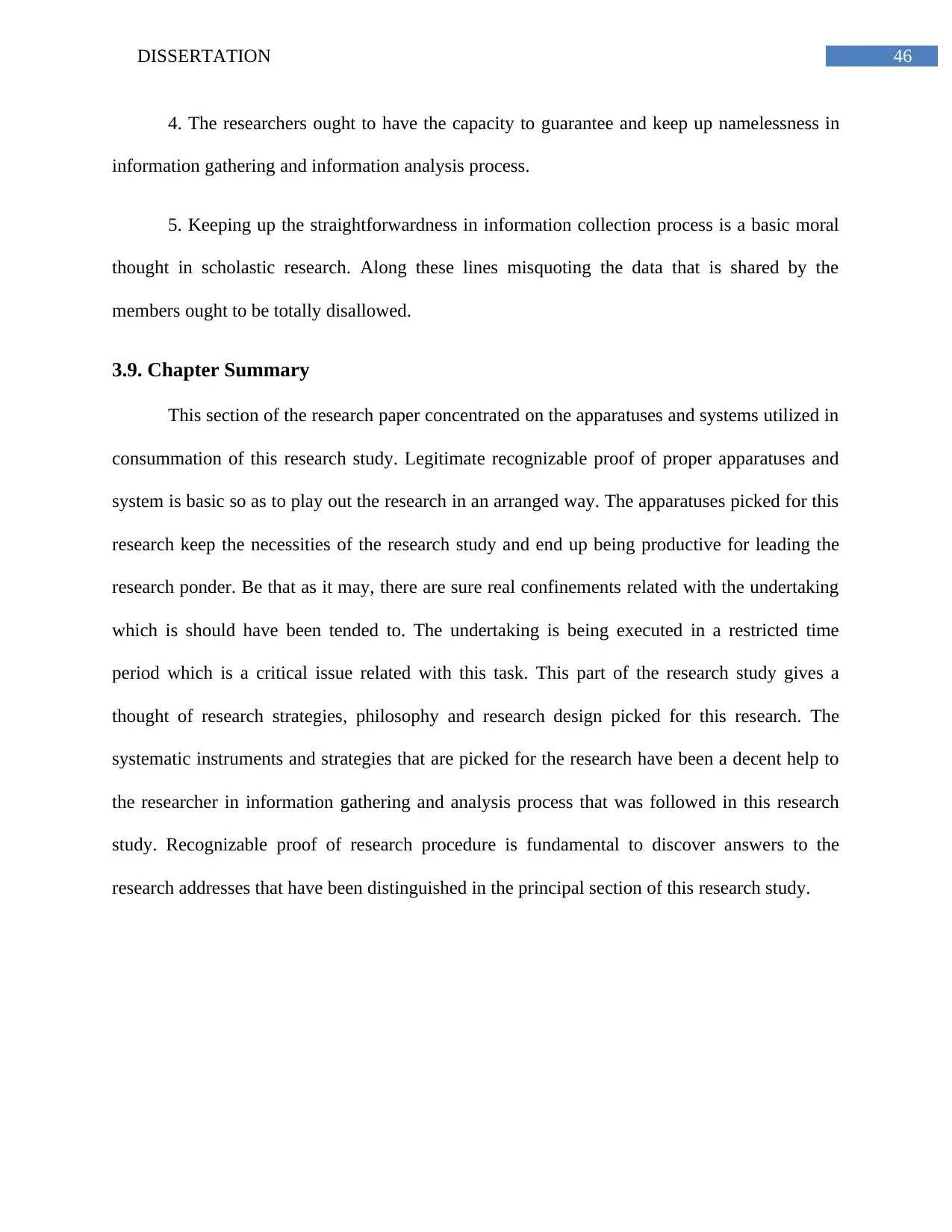
4. The researchers ought to have the capacity to guarantee and keep up namelessness in
information gathering and information analysis process.
5. Keeping up the straightforwardness in information collection process is a basic moral
thought in scholastic research. Along these lines misquoting the data that is shared by the
members ought to be totally disallowed.
3.9. Chapter Summary
This section of the research paper concentrated on the apparatuses and systems utilized in
consummation of this research study. Legitimate recognizable proof of proper apparatuses and
system is basic so as to play out the research in an arranged way. The apparatuses picked for this
research keep the necessities of the research study and end up being productive for leading the
research ponder. Be that as it may, there are sure real confinements related with the undertaking
which is should have been tended to. The undertaking is being executed in a restricted time
period which is a critical issue related with this task. This part of the research study gives a
thought of research strategies, philosophy and research design picked for this research. The
systematic instruments and strategies that are picked for the research have been a decent help to
the researcher in information gathering and analysis process that was followed in this research
study. Recognizable proof of research procedure is fundamental to discover answers to the
research addresses that have been distinguished in the principal section of this research study.
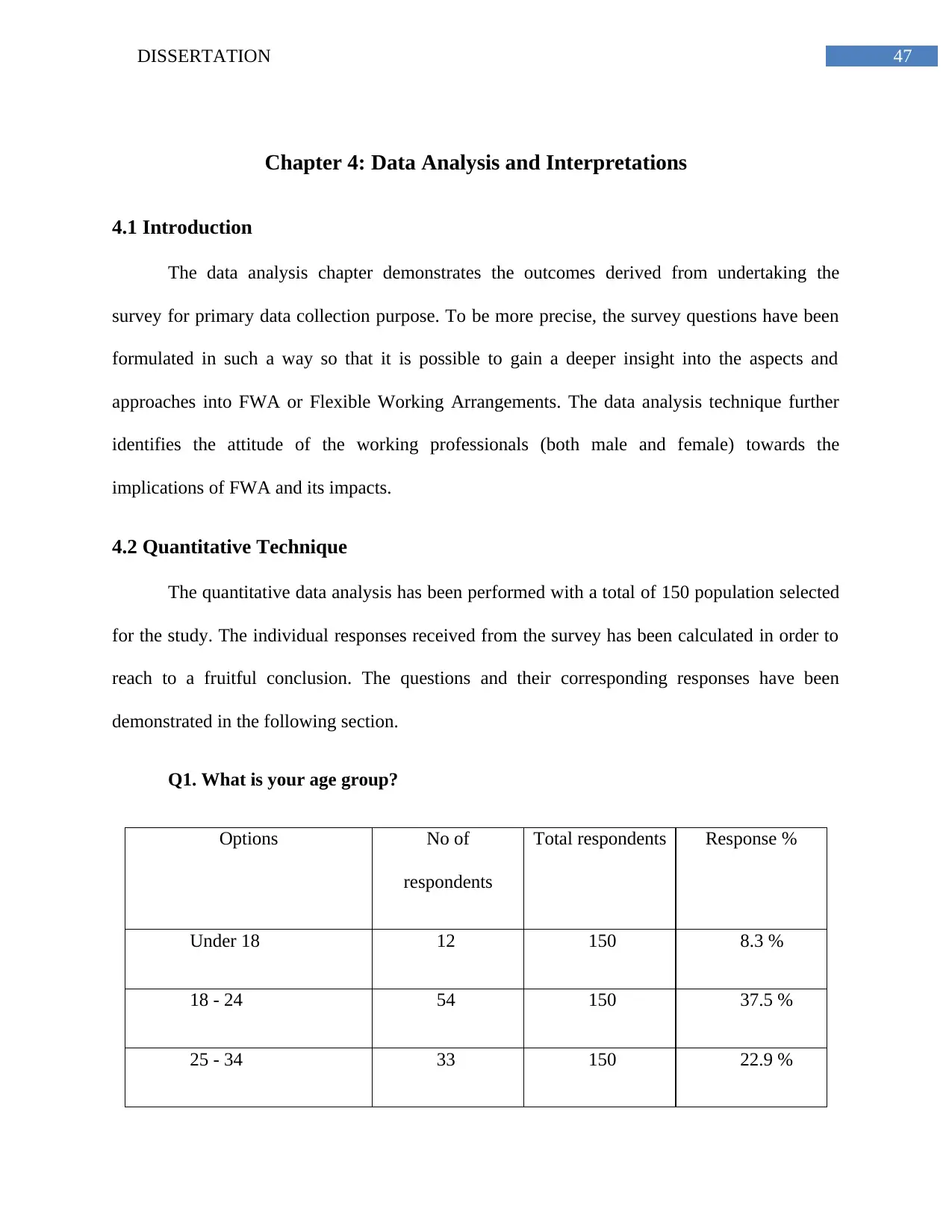
Chapter 4: Data Analysis and Interpretations
4.1 Introduction
The data analysis chapter demonstrates the outcomes derived from undertaking the
survey for primary data collection purpose. To be more precise, the survey questions have been
formulated in such a way so that it is possible to gain a deeper insight into the aspects and
approaches into FWA or Flexible Working Arrangements. The data analysis technique further
identifies the attitude of the working professionals (both male and female) towards the
implications of FWA and its impacts.
4.2 Quantitative Technique
The quantitative data analysis has been performed with a total of 150 population selected
for the study. The individual responses received from the survey has been calculated in order to
reach to a fruitful conclusion. The questions and their corresponding responses have been
demonstrated in the following section.
Q1. What is your age group?
Options No of
respondents
Total respondents Response %
Under 18 12 150 8.3 %
18 - 24 54 150 37.5 %
25 - 34 33 150 22.9 %
⊘ This is a preview!⊘
Do you want full access?
Subscribe today to unlock all pages.

Trusted by 1+ million students worldwide
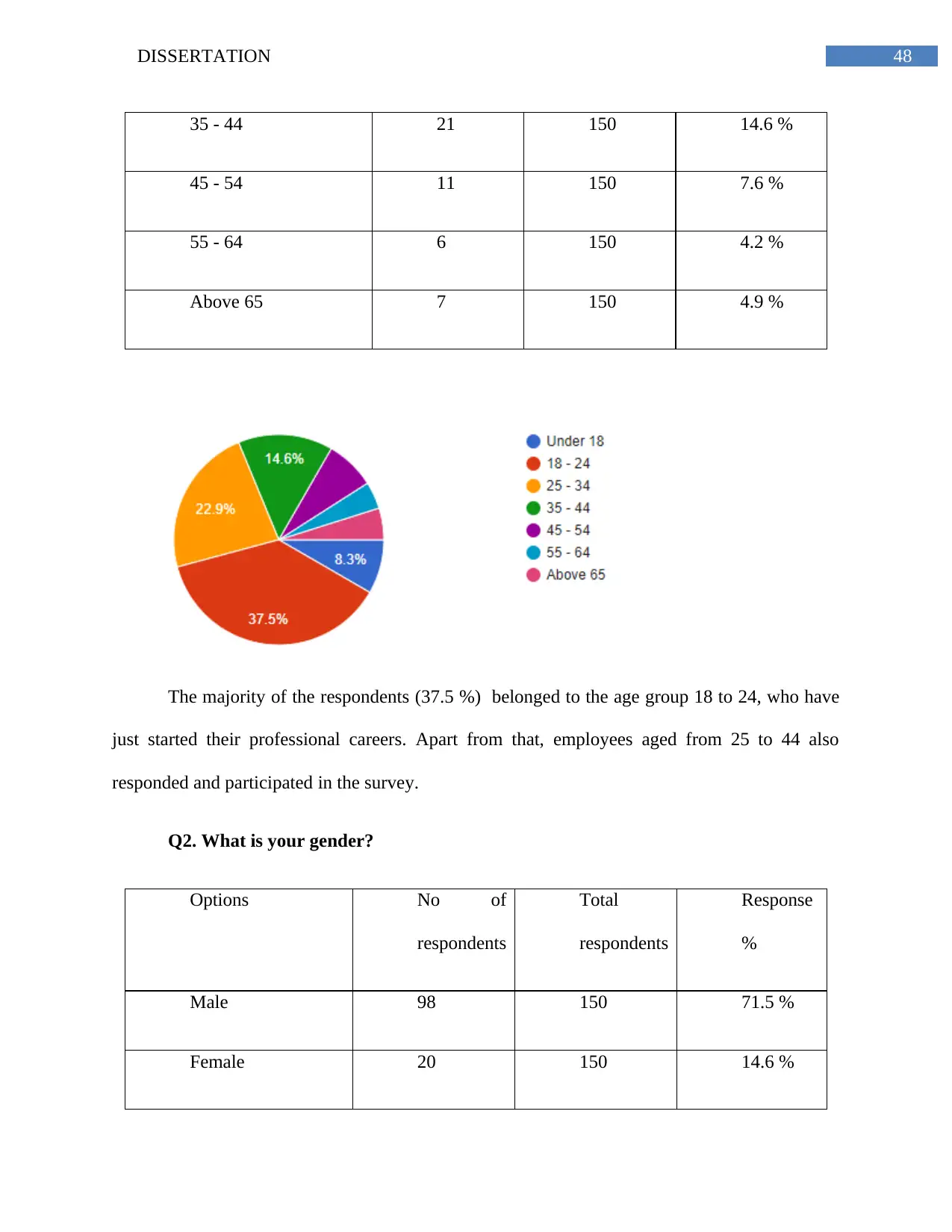
35 - 44 21 150 14.6 %
45 - 54 11 150 7.6 %
55 - 64 6 150 4.2 %
Above 65 7 150 4.9 %
The majority of the respondents (37.5 %) belonged to the age group 18 to 24, who have
just started their professional careers. Apart from that, employees aged from 25 to 44 also
responded and participated in the survey.
Q2. What is your gender?
Options No of
respondents
Total
respondents
Response
%
Male 98 150 71.5 %
Female 20 150 14.6 %
Paraphrase This Document
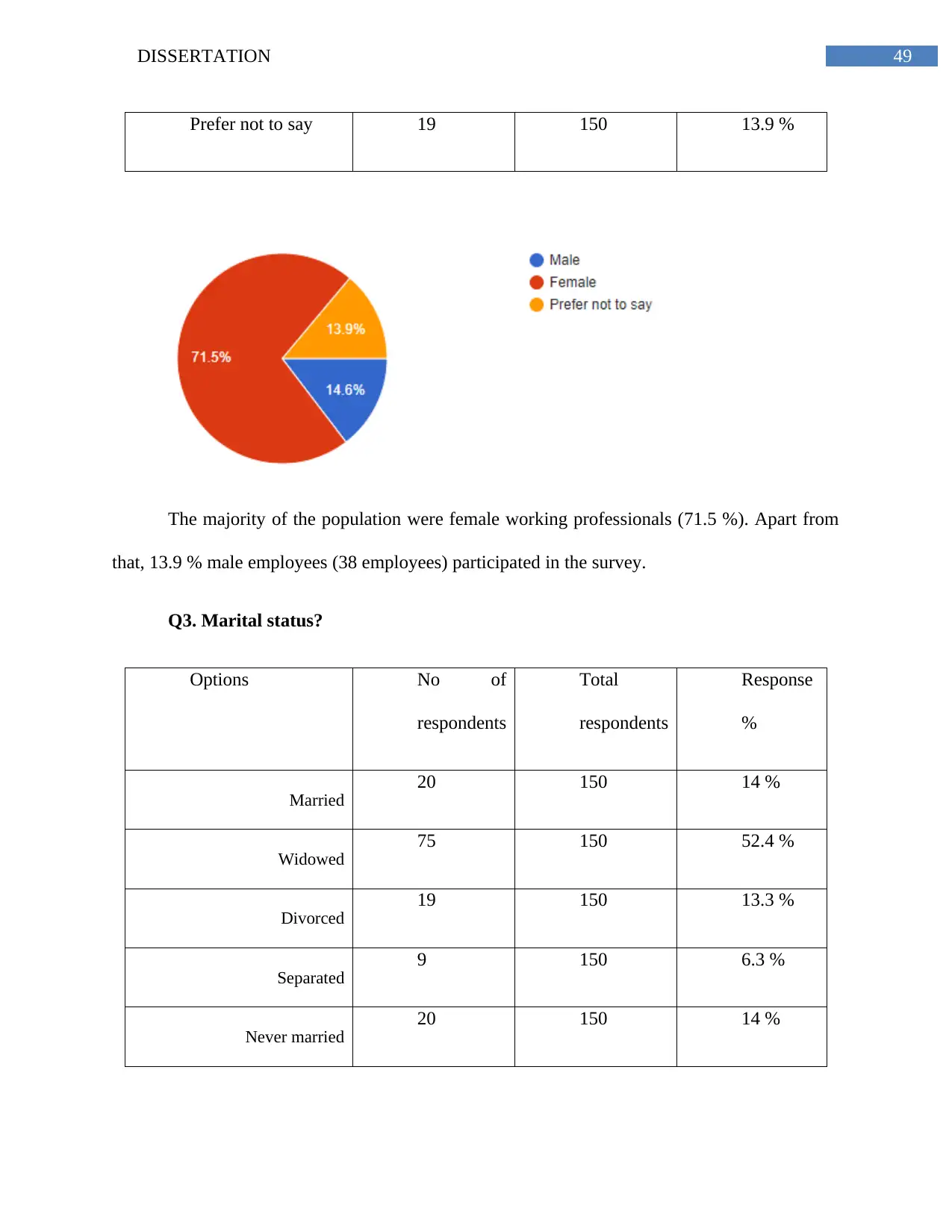
Prefer not to say 19 150 13.9 %
The majority of the population were female working professionals (71.5 %). Apart from
that, 13.9 % male employees (38 employees) participated in the survey.
Q3. Marital status?
Options No of
respondents
Total
respondents
Response
%
Married
20 150 14 %
Widowed
75 150 52.4 %
Divorced
19 150 13.3 %
Separated
9 150 6.3 %
Never married
20 150 14 %
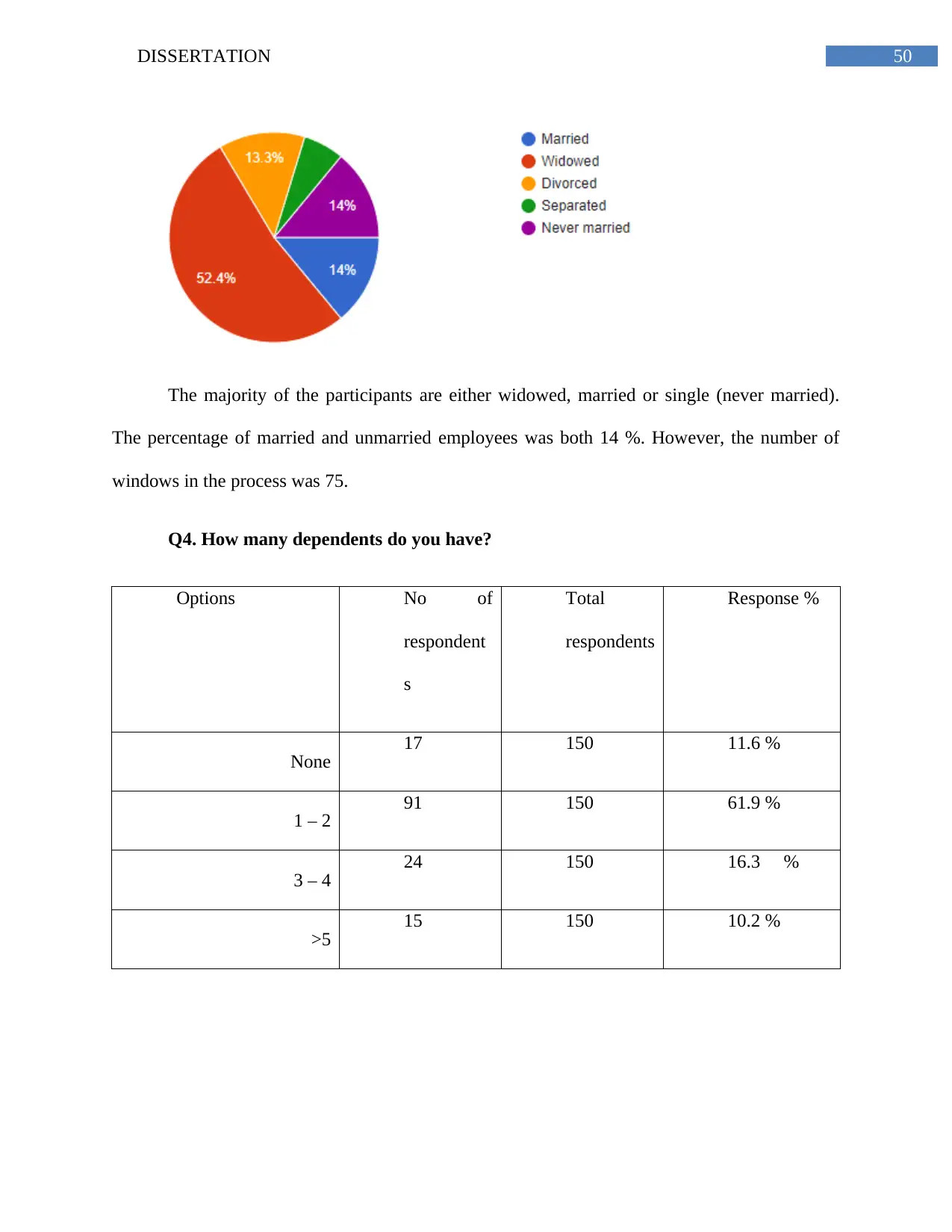
The majority of the participants are either widowed, married or single (never married).
The percentage of married and unmarried employees was both 14 %. However, the number of
windows in the process was 75.
Q4. How many dependents do you have?
Options No of
respondent
s
Total
respondents
Response %
None 17 150 11.6 %
1 – 2 91 150 61.9 %
3 – 4 24 150 16.3 %
>5 15 150 10.2 %
⊘ This is a preview!⊘
Do you want full access?
Subscribe today to unlock all pages.

Trusted by 1+ million students worldwide
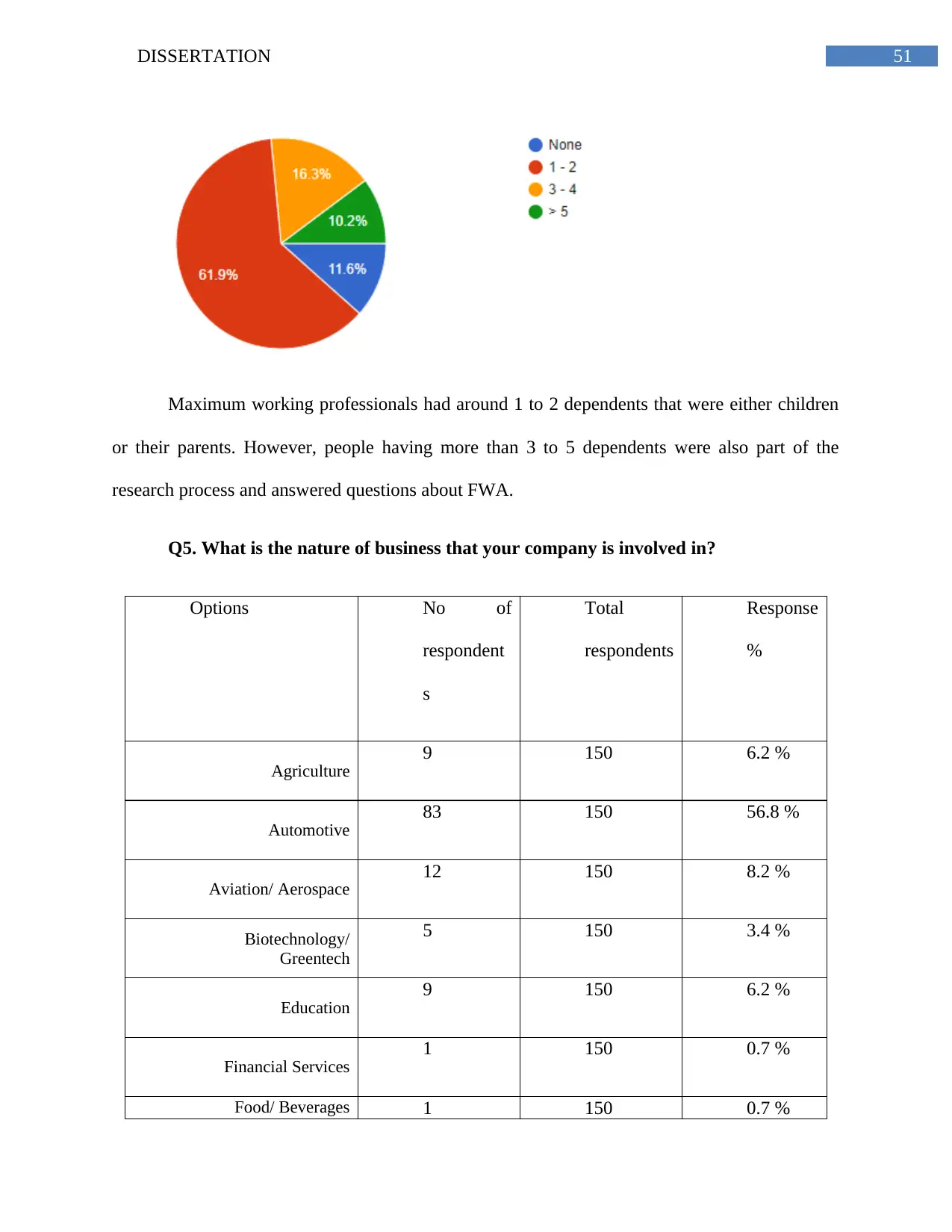
Maximum working professionals had around 1 to 2 dependents that were either children
or their parents. However, people having more than 3 to 5 dependents were also part of the
research process and answered questions about FWA.
Q5. What is the nature of business that your company is involved in?
Options No of
respondent
s
Total
respondents
Response
%
Agriculture
9 150 6.2 %
Automotive
83 150 56.8 %
Aviation/ Aerospace
12 150 8.2 %
Biotechnology/
Greentech
5 150 3.4 %
Education
9 150 6.2 %
Financial Services
1 150 0.7 %
Food/ Beverages 1 150 0.7 %
Paraphrase This Document
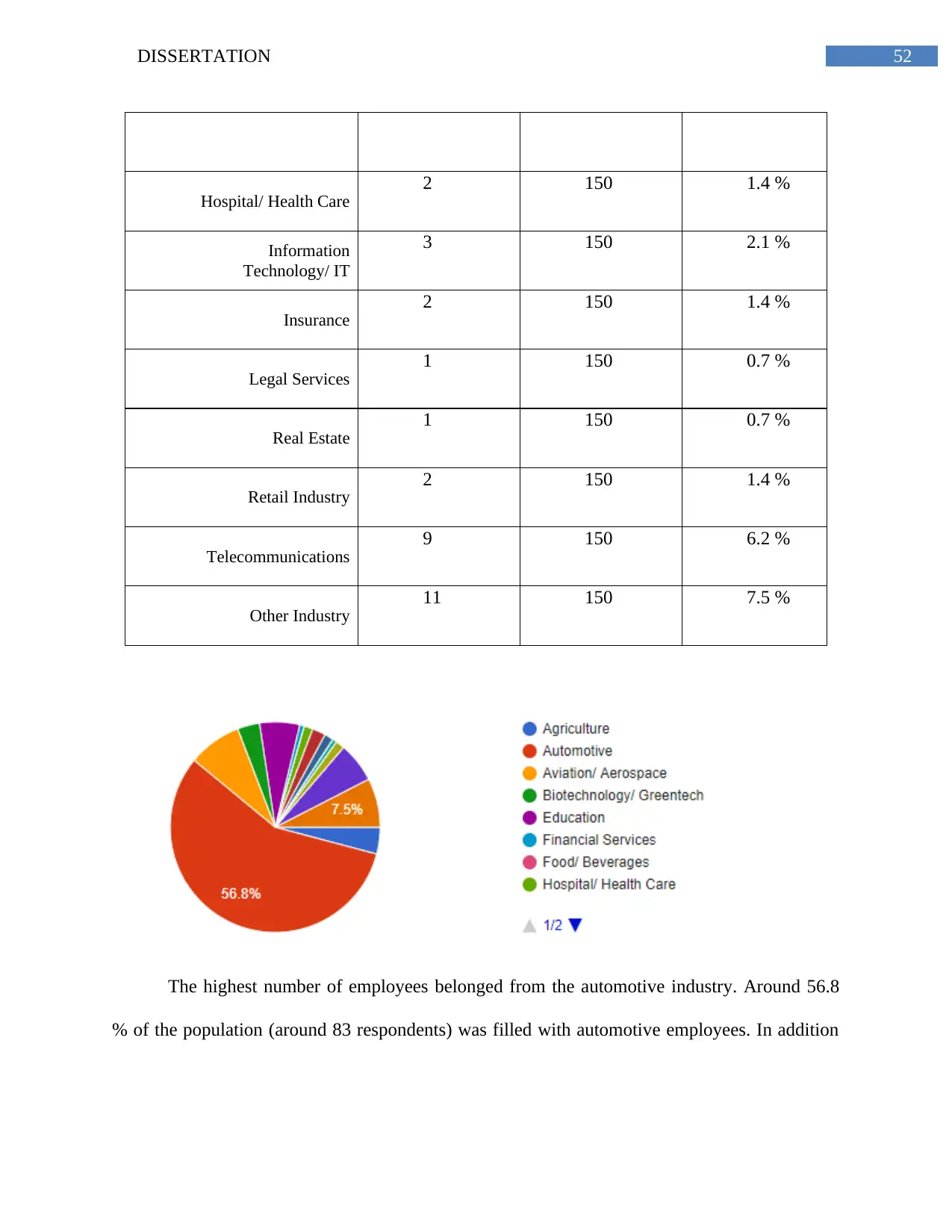
Hospital/ Health Care
2 150 1.4 %
Information
Technology/ IT
3 150 2.1 %
Insurance
2 150 1.4 %
Legal Services
1 150 0.7 %
Real Estate
1 150 0.7 %
Retail Industry
2 150 1.4 %
Telecommunications
9 150 6.2 %
Other Industry
11 150 7.5 %
The highest number of employees belonged from the automotive industry. Around 56.8
% of the population (around 83 respondents) was filled with automotive employees. In addition
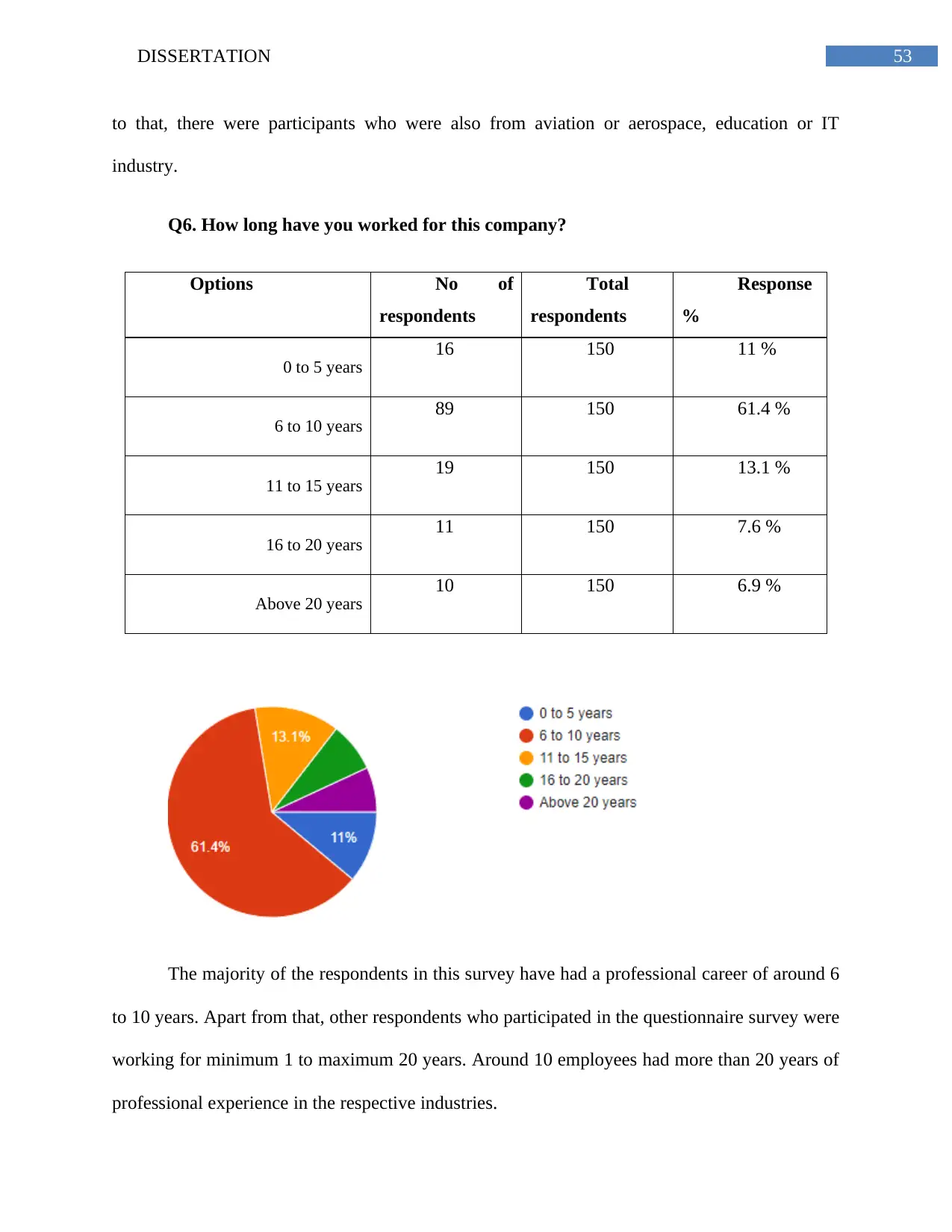
to that, there were participants who were also from aviation or aerospace, education or IT
industry.
Q6. How long have you worked for this company?
Options No of
respondents
Total
respondents
Response
%
0 to 5 years
16 150 11 %
6 to 10 years
89 150 61.4 %
11 to 15 years
19 150 13.1 %
16 to 20 years
11 150 7.6 %
Above 20 years
10 150 6.9 %
The majority of the respondents in this survey have had a professional career of around 6
to 10 years. Apart from that, other respondents who participated in the questionnaire survey were
working for minimum 1 to maximum 20 years. Around 10 employees had more than 20 years of
professional experience in the respective industries.
⊘ This is a preview!⊘
Do you want full access?
Subscribe today to unlock all pages.

Trusted by 1+ million students worldwide
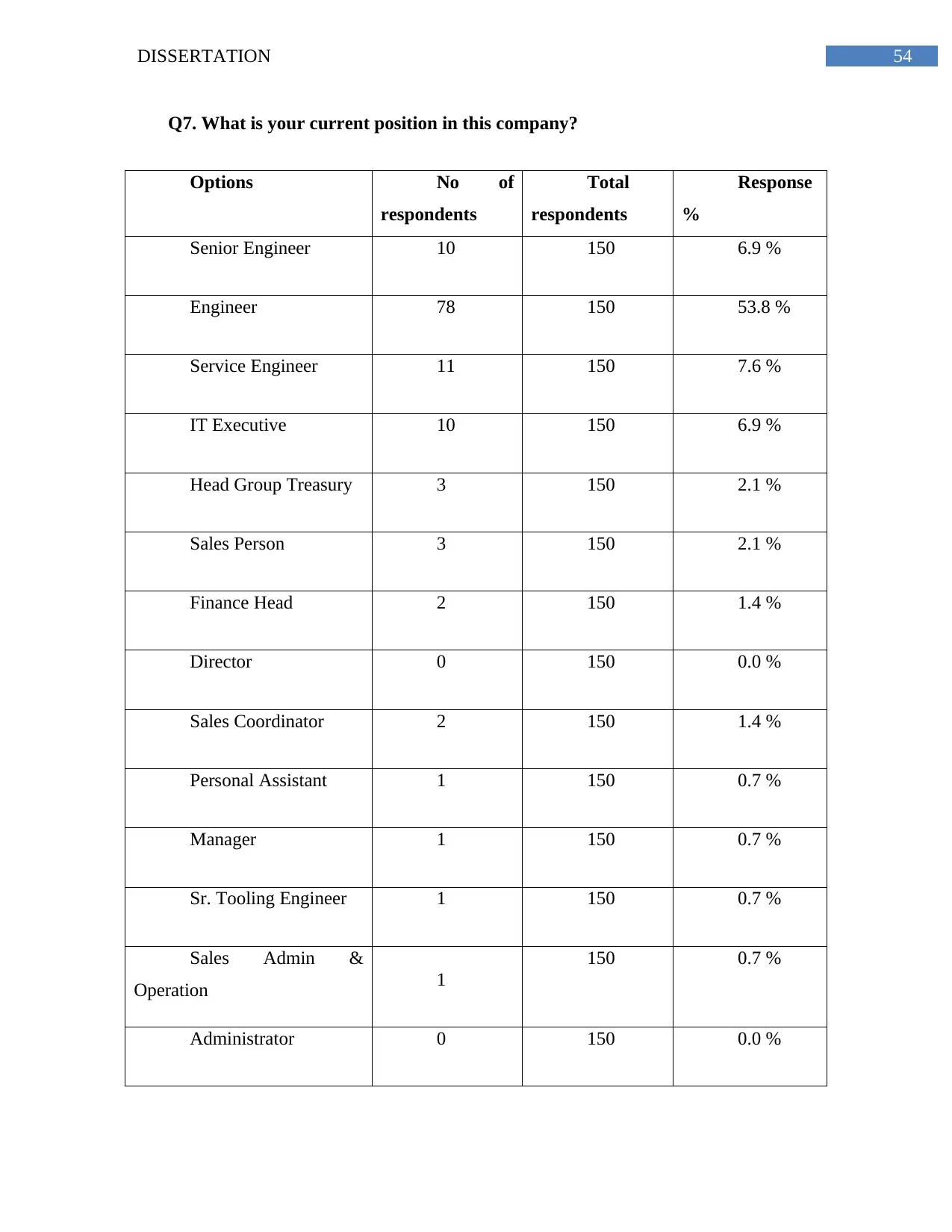
Q7. What is your current position in this company?
Options No of
respondents
Total
respondents
Response
%
Senior Engineer 10 150 6.9 %
Engineer 78 150 53.8 %
Service Engineer 11 150 7.6 %
IT Executive 10 150 6.9 %
Head Group Treasury 3 150 2.1 %
Sales Person 3 150 2.1 %
Finance Head 2 150 1.4 %
Director 0 150 0.0 %
Sales Coordinator 2 150 1.4 %
Personal Assistant 1 150 0.7 %
Manager 1 150 0.7 %
Sr. Tooling Engineer 1 150 0.7 %
Sales Admin &
Operation 1
150 0.7 %
Administrator 0 150 0.0 %
Paraphrase This Document
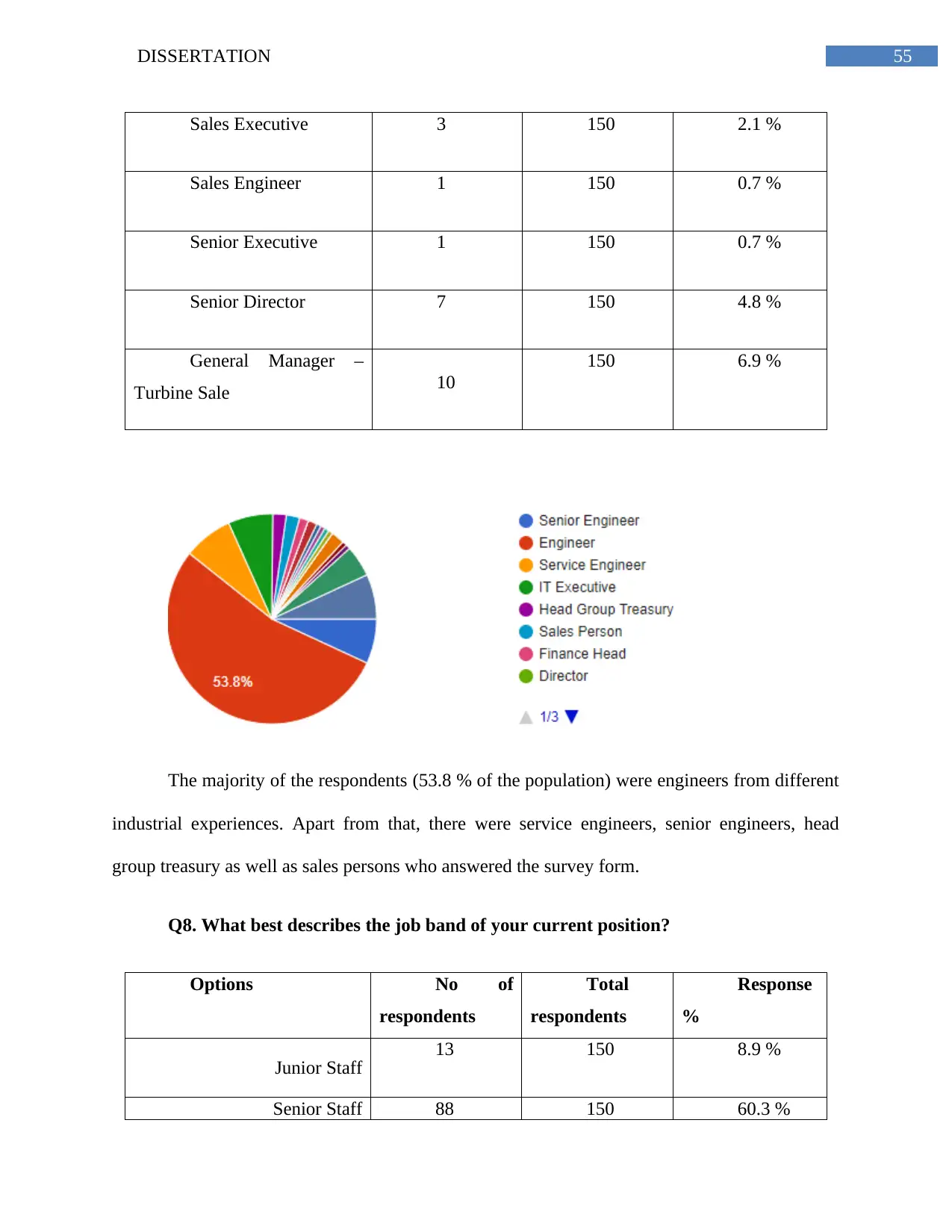
Sales Executive 3 150 2.1 %
Sales Engineer 1 150 0.7 %
Senior Executive 1 150 0.7 %
Senior Director 7 150 4.8 %
General Manager –
Turbine Sale 10
150 6.9 %
The majority of the respondents (53.8 % of the population) were engineers from different
industrial experiences. Apart from that, there were service engineers, senior engineers, head
group treasury as well as sales persons who answered the survey form.
Q8. What best describes the job band of your current position?
Options No of
respondents
Total
respondents
Response
%
Junior Staff 13 150 8.9 %
Senior Staff 88 150 60.3 %
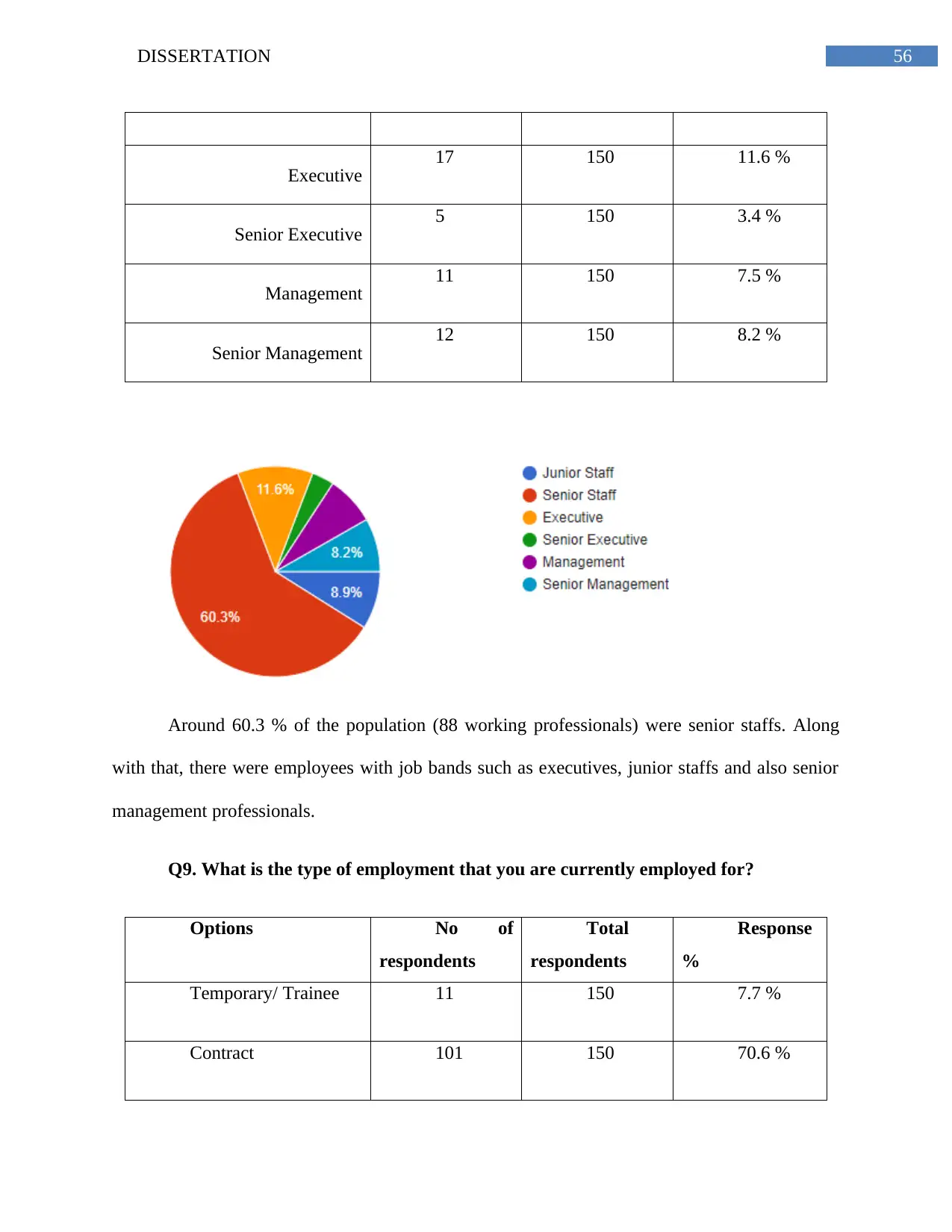
Executive 17 150 11.6 %
Senior Executive 5 150 3.4 %
Management 11 150 7.5 %
Senior Management 12 150 8.2 %
Around 60.3 % of the population (88 working professionals) were senior staffs. Along
with that, there were employees with job bands such as executives, junior staffs and also senior
management professionals.
Q9. What is the type of employment that you are currently employed for?
Options No of
respondents
Total
respondents
Response
%
Temporary/ Trainee 11 150 7.7 %
Contract 101 150 70.6 %
⊘ This is a preview!⊘
Do you want full access?
Subscribe today to unlock all pages.

Trusted by 1+ million students worldwide

Permanent 31 150 21.7 %
The majority of the respondents (101 number of people) i.e. around 70.6 % of the sample
size were working in a contractual basis. There were 31 permanent employees and 7.7 %
respondents were trainee or temporary employees.
Q10. Please indicate your current income group.
Options No of
respondents
Total
respondents
Response
%
Less than RM1,050 10 150 6.8 %
RM1,151 to RM3,999 79 150 54.1 %
RM4,000 to RM7,999 16 150 11 %
RM8,000 to
RM11,999
13 150 8.9 %
RM12,000 to
RM15,999
5 150 3.4 %
RM16,000 to
RM19,999
10 150 6.8 %
Paraphrase This Document
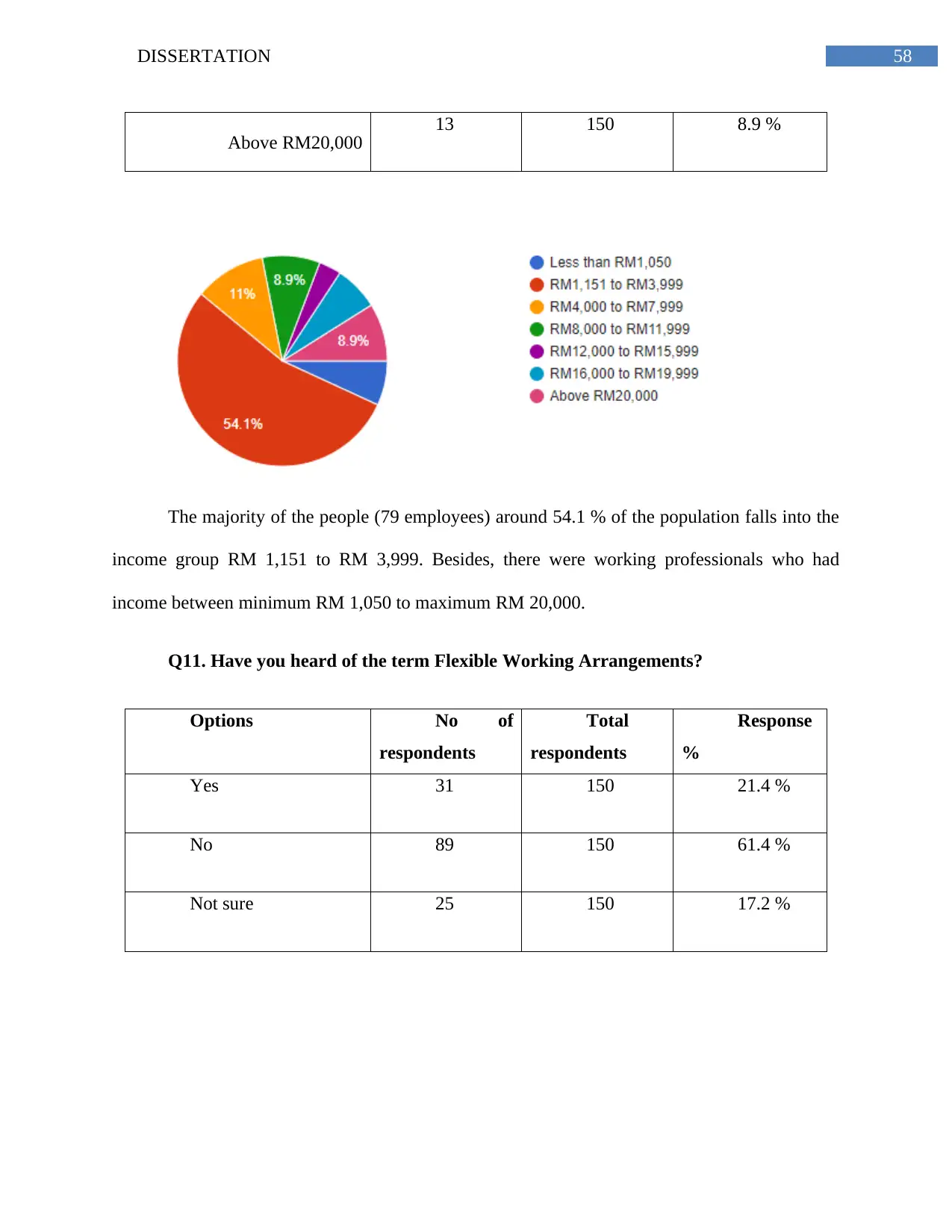
Above RM20,000 13 150 8.9 %
The majority of the people (79 employees) around 54.1 % of the population falls into the
income group RM 1,151 to RM 3,999. Besides, there were working professionals who had
income between minimum RM 1,050 to maximum RM 20,000.
Q11. Have you heard of the term Flexible Working Arrangements?
Options No of
respondents
Total
respondents
Response
%
Yes 31 150 21.4 %
No 89 150 61.4 %
Not sure 25 150 17.2 %
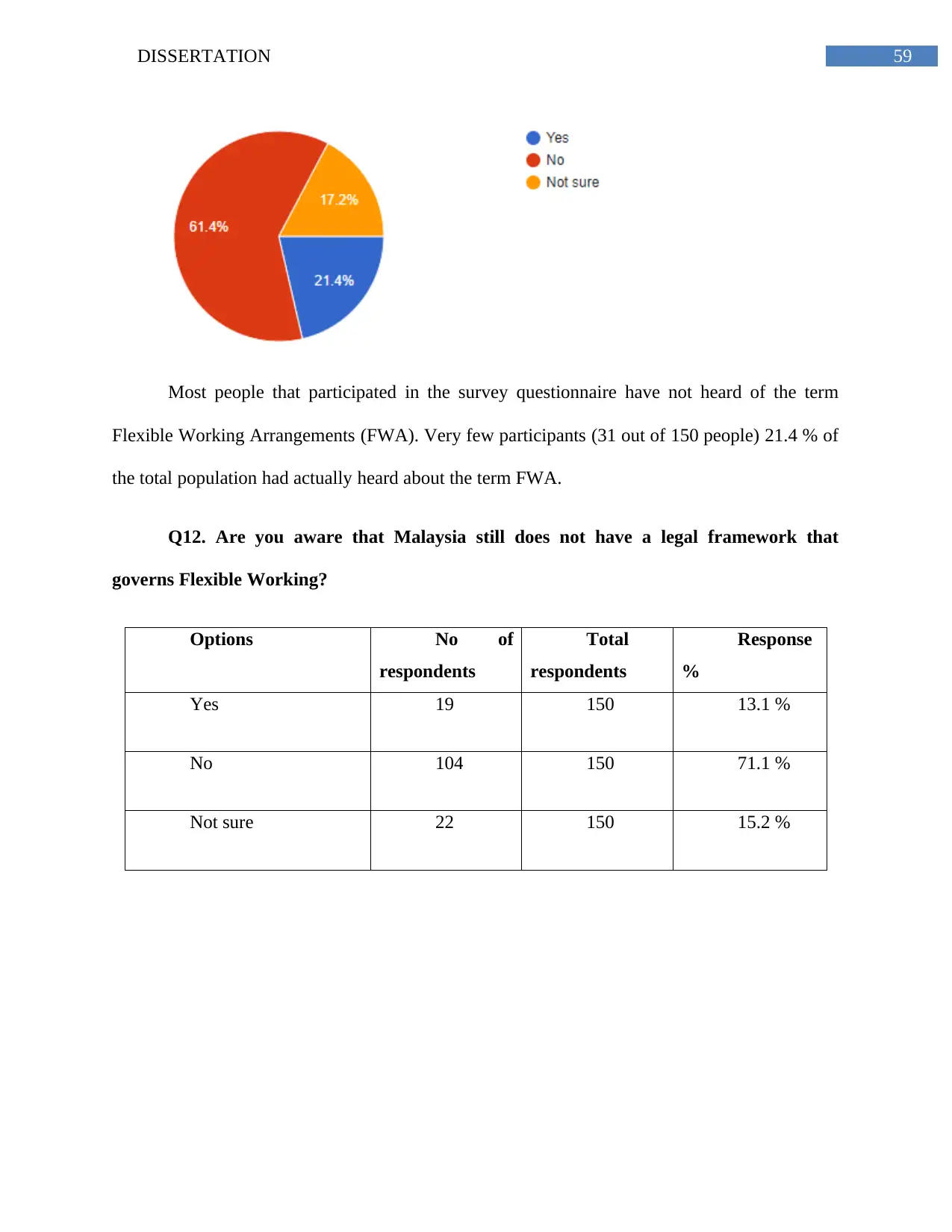
Most people that participated in the survey questionnaire have not heard of the term
Flexible Working Arrangements (FWA). Very few participants (31 out of 150 people) 21.4 % of
the total population had actually heard about the term FWA.
Q12. Are you aware that Malaysia still does not have a legal framework that
governs Flexible Working?
Options No of
respondents
Total
respondents
Response
%
Yes 19 150 13.1 %
No 104 150 71.1 %
Not sure 22 150 15.2 %
⊘ This is a preview!⊘
Do you want full access?
Subscribe today to unlock all pages.

Trusted by 1+ million students worldwide
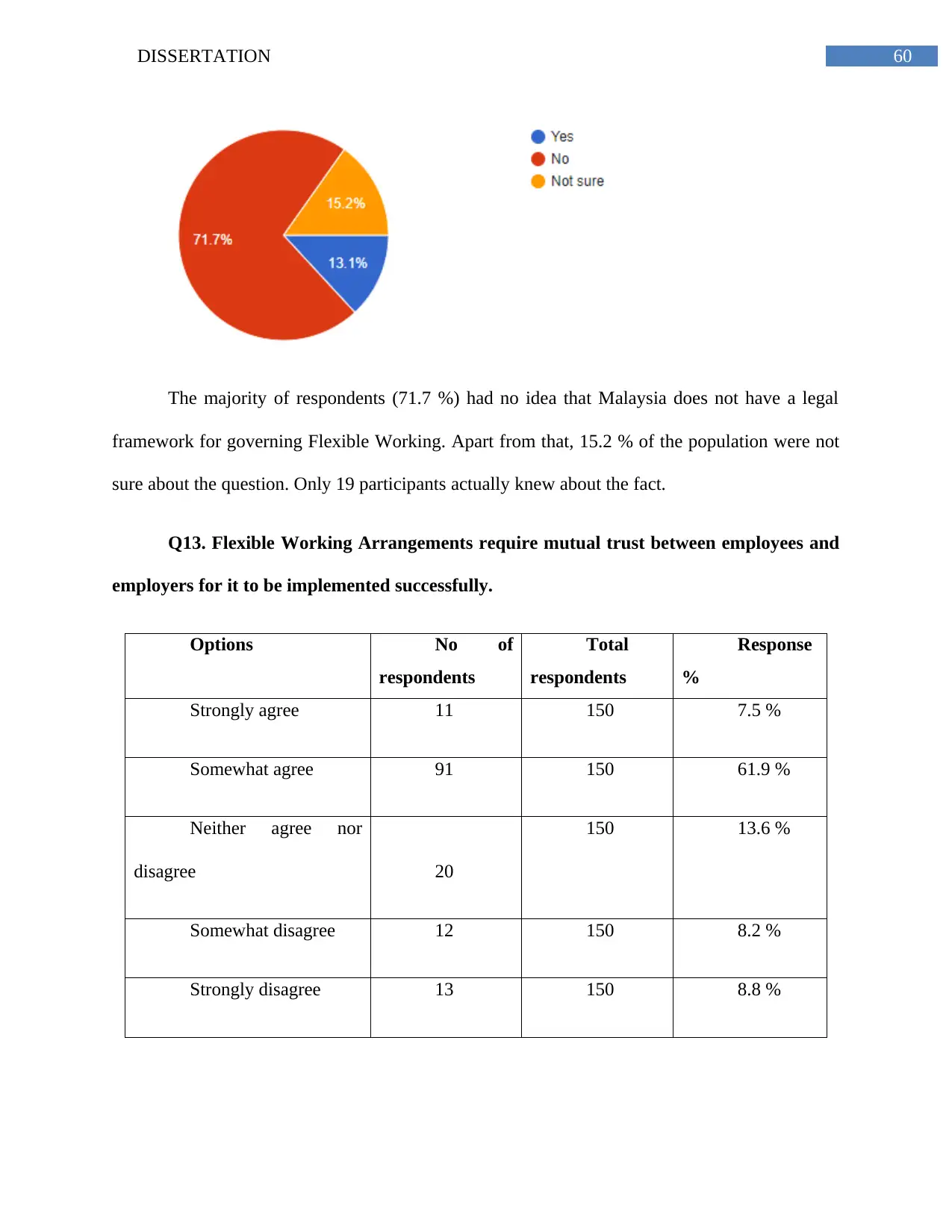
The majority of respondents (71.7 %) had no idea that Malaysia does not have a legal
framework for governing Flexible Working. Apart from that, 15.2 % of the population were not
sure about the question. Only 19 participants actually knew about the fact.
Q13. Flexible Working Arrangements require mutual trust between employees and
employers for it to be implemented successfully.
Options No of
respondents
Total
respondents
Response
%
Strongly agree 11 150 7.5 %
Somewhat agree 91 150 61.9 %
Neither agree nor
disagree 20
150 13.6 %
Somewhat disagree 12 150 8.2 %
Strongly disagree 13 150 8.8 %
Paraphrase This Document

61.9 % of the population or 91 respondents somewhat agrees that the Flexible Working
Arrangements require mutual trust between employees and employers for it to be implemented
successfully. 20 of them neither agreed nor disagreed on the statement, whereas only 13 people
strongly disagreed.
Q14. Flexible Working Arrangements will cause employee performance to drop
significantly.
Options No of
respondents
Total
respondents
Response
%
Strongly agree 11 150 7.6 %
Somewhat agree 91 150 62.8 %
Neither agree nor
disagree 17
150 11.7 %
Somewhat disagree 8 150 5.5 %
Strongly disagree 18 150 12.4 %
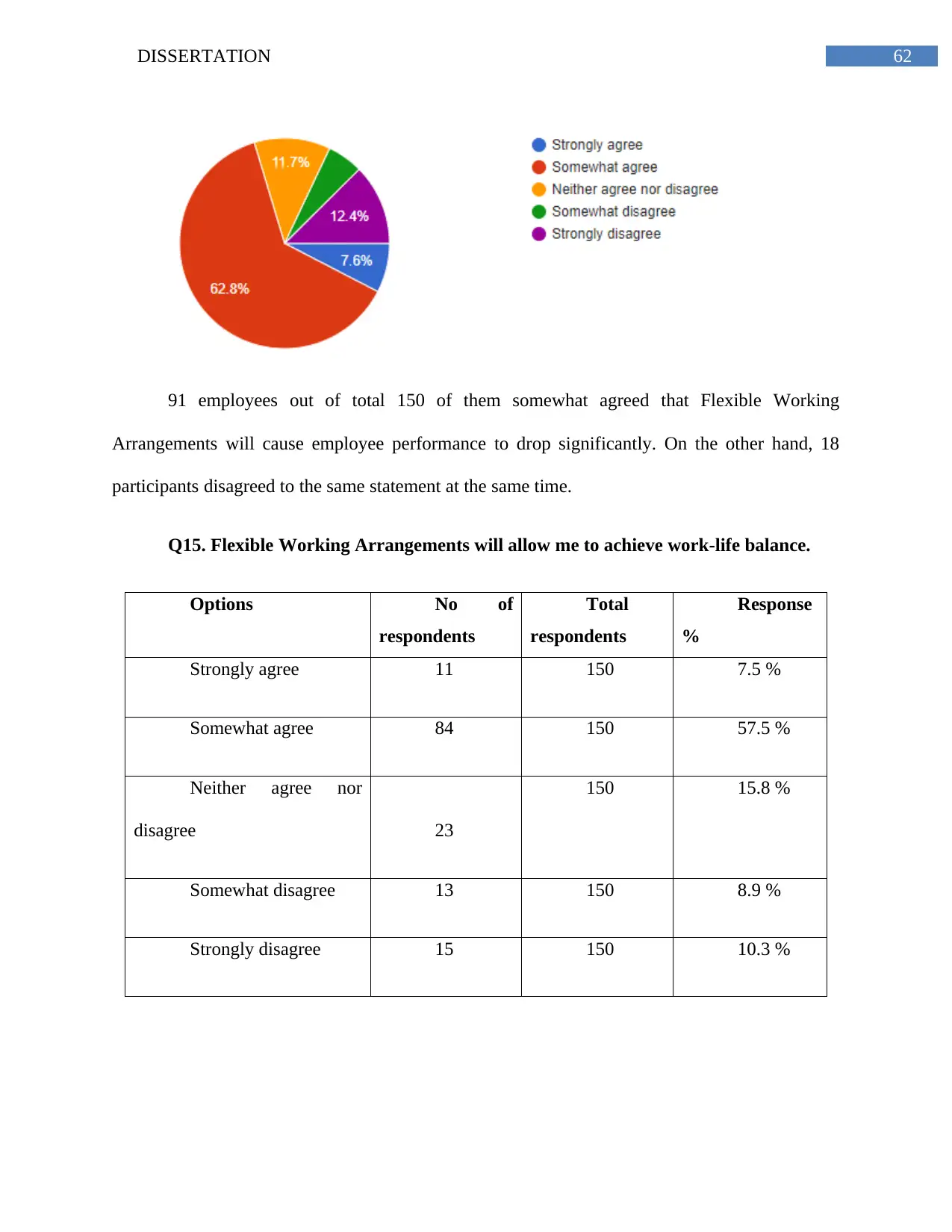
91 employees out of total 150 of them somewhat agreed that Flexible Working
Arrangements will cause employee performance to drop significantly. On the other hand, 18
participants disagreed to the same statement at the same time.
Q15. Flexible Working Arrangements will allow me to achieve work-life balance.
Options No of
respondents
Total
respondents
Response
%
Strongly agree 11 150 7.5 %
Somewhat agree 84 150 57.5 %
Neither agree nor
disagree 23
150 15.8 %
Somewhat disagree 13 150 8.9 %
Strongly disagree 15 150 10.3 %
⊘ This is a preview!⊘
Do you want full access?
Subscribe today to unlock all pages.

Trusted by 1+ million students worldwide
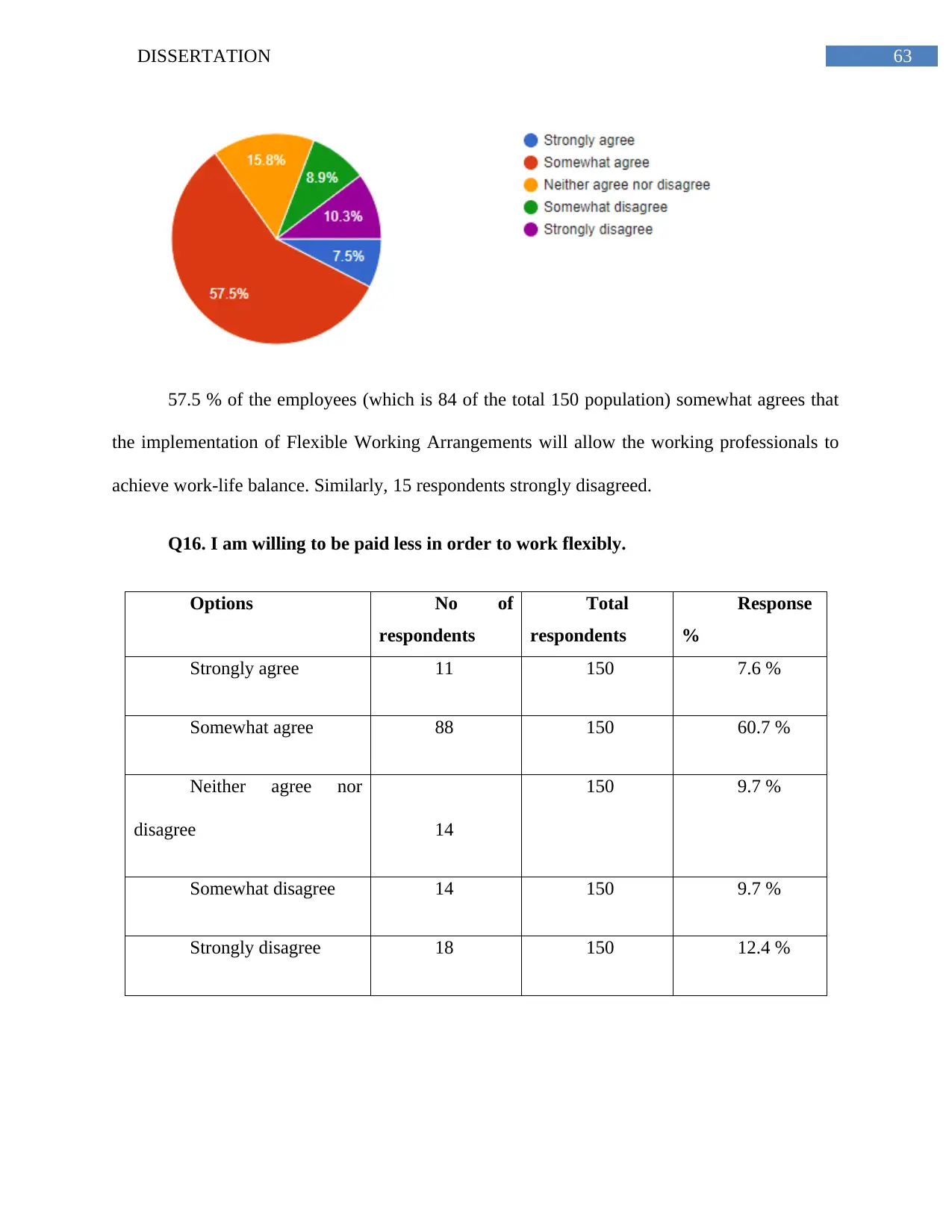
57.5 % of the employees (which is 84 of the total 150 population) somewhat agrees that
the implementation of Flexible Working Arrangements will allow the working professionals to
achieve work-life balance. Similarly, 15 respondents strongly disagreed.
Q16. I am willing to be paid less in order to work flexibly.
Options No of
respondents
Total
respondents
Response
%
Strongly agree 11 150 7.6 %
Somewhat agree 88 150 60.7 %
Neither agree nor
disagree 14
150 9.7 %
Somewhat disagree 14 150 9.7 %
Strongly disagree 18 150 12.4 %
Paraphrase This Document
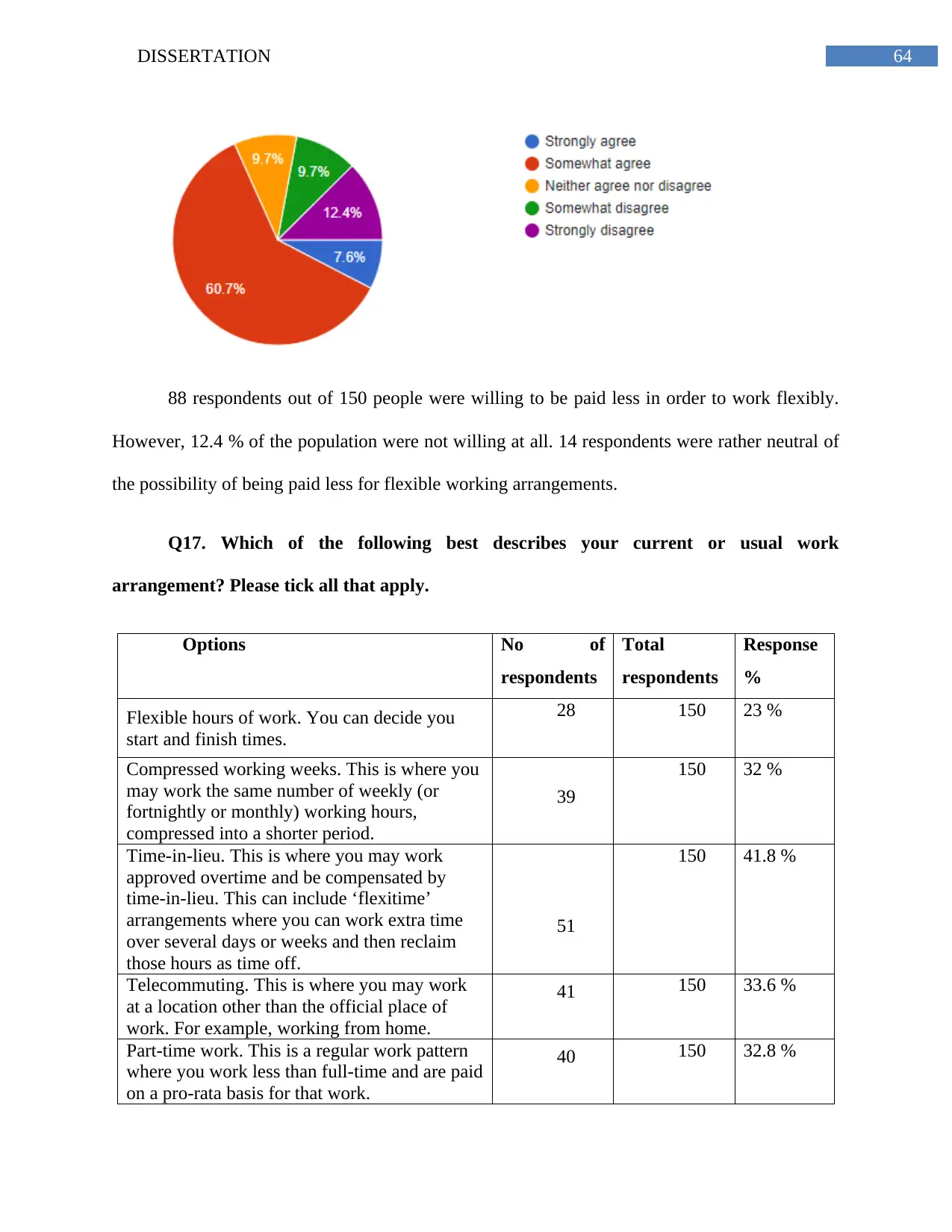
88 respondents out of 150 people were willing to be paid less in order to work flexibly.
However, 12.4 % of the population were not willing at all. 14 respondents were rather neutral of
the possibility of being paid less for flexible working arrangements.
Q17. Which of the following best describes your current or usual work
arrangement? Please tick all that apply.
Options No of
respondents
Total
respondents
Response
%
Flexible hours of work. You can decide you
start and finish times.
28 150 23 %
Compressed working weeks. This is where you
may work the same number of weekly (or
fortnightly or monthly) working hours,
compressed into a shorter period.
39
150 32 %
Time-in-lieu. This is where you may work
approved overtime and be compensated by
time-in-lieu. This can include ‘flexitime’
arrangements where you can work extra time
over several days or weeks and then reclaim
those hours as time off.
51
150 41.8 %
Telecommuting. This is where you may work
at a location other than the official place of
work. For example, working from home.
41 150 33.6 %
Part-time work. This is a regular work pattern
where you work less than full-time and are paid
on a pro-rata basis for that work.
40 150 32.8 %
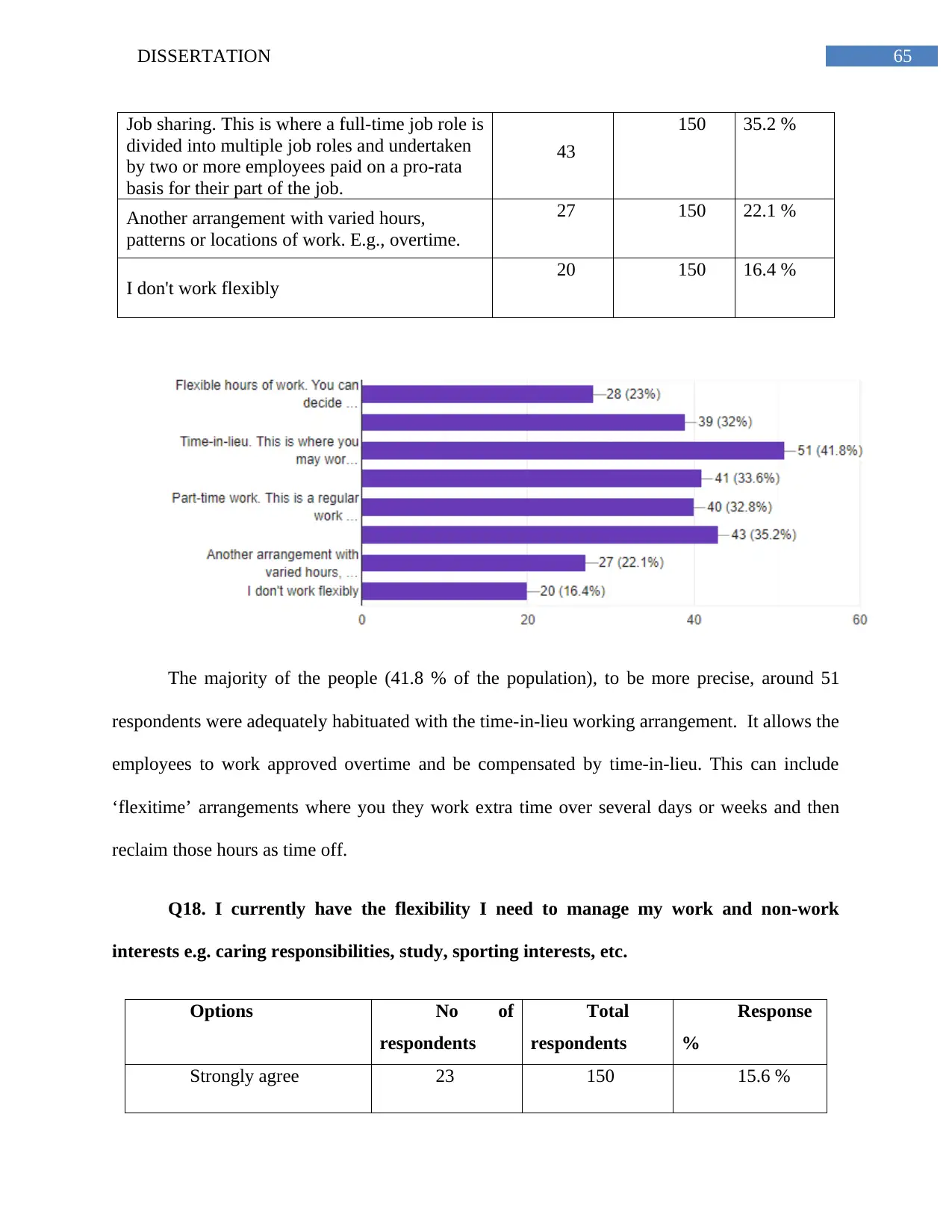
Job sharing. This is where a full-time job role is
divided into multiple job roles and undertaken
by two or more employees paid on a pro-rata
basis for their part of the job.
43
150 35.2 %
Another arrangement with varied hours,
patterns or locations of work. E.g., overtime.
27 150 22.1 %
I don't work flexibly 20 150 16.4 %
The majority of the people (41.8 % of the population), to be more precise, around 51
respondents were adequately habituated with the time-in-lieu working arrangement. It allows the
employees to work approved overtime and be compensated by time-in-lieu. This can include
‘flexitime’ arrangements where you they work extra time over several days or weeks and then
reclaim those hours as time off.
Q18. I currently have the flexibility I need to manage my work and non-work
interests e.g. caring responsibilities, study, sporting interests, etc.
Options No of
respondents
Total
respondents
Response
%
Strongly agree 23 150 15.6 %
⊘ This is a preview!⊘
Do you want full access?
Subscribe today to unlock all pages.

Trusted by 1+ million students worldwide
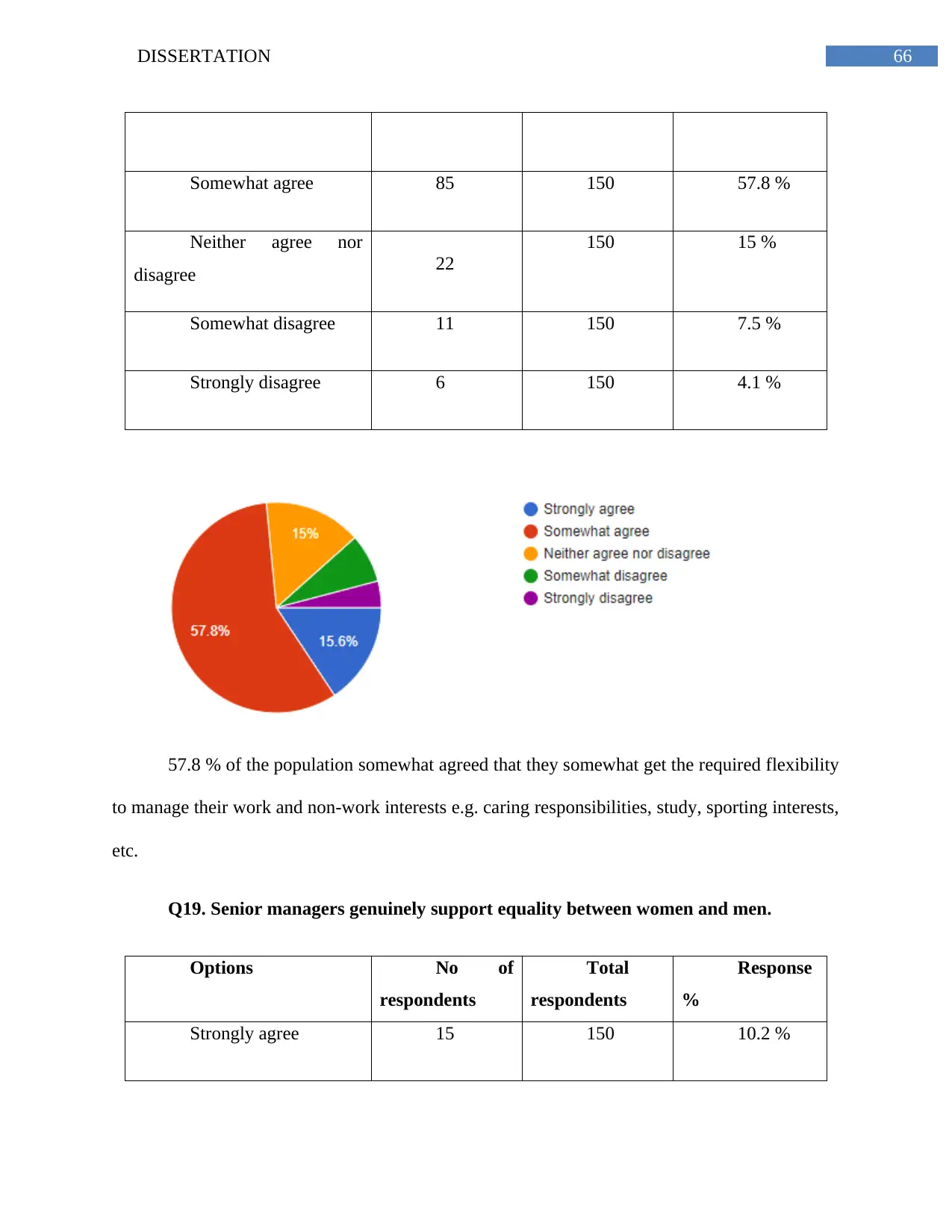
Somewhat agree 85 150 57.8 %
Neither agree nor
disagree 22
150 15 %
Somewhat disagree 11 150 7.5 %
Strongly disagree 6 150 4.1 %
57.8 % of the population somewhat agreed that they somewhat get the required flexibility
to manage their work and non-work interests e.g. caring responsibilities, study, sporting interests,
etc.
Q19. Senior managers genuinely support equality between women and men.
Options No of
respondents
Total
respondents
Response
%
Strongly agree 15 150 10.2 %
Paraphrase This Document
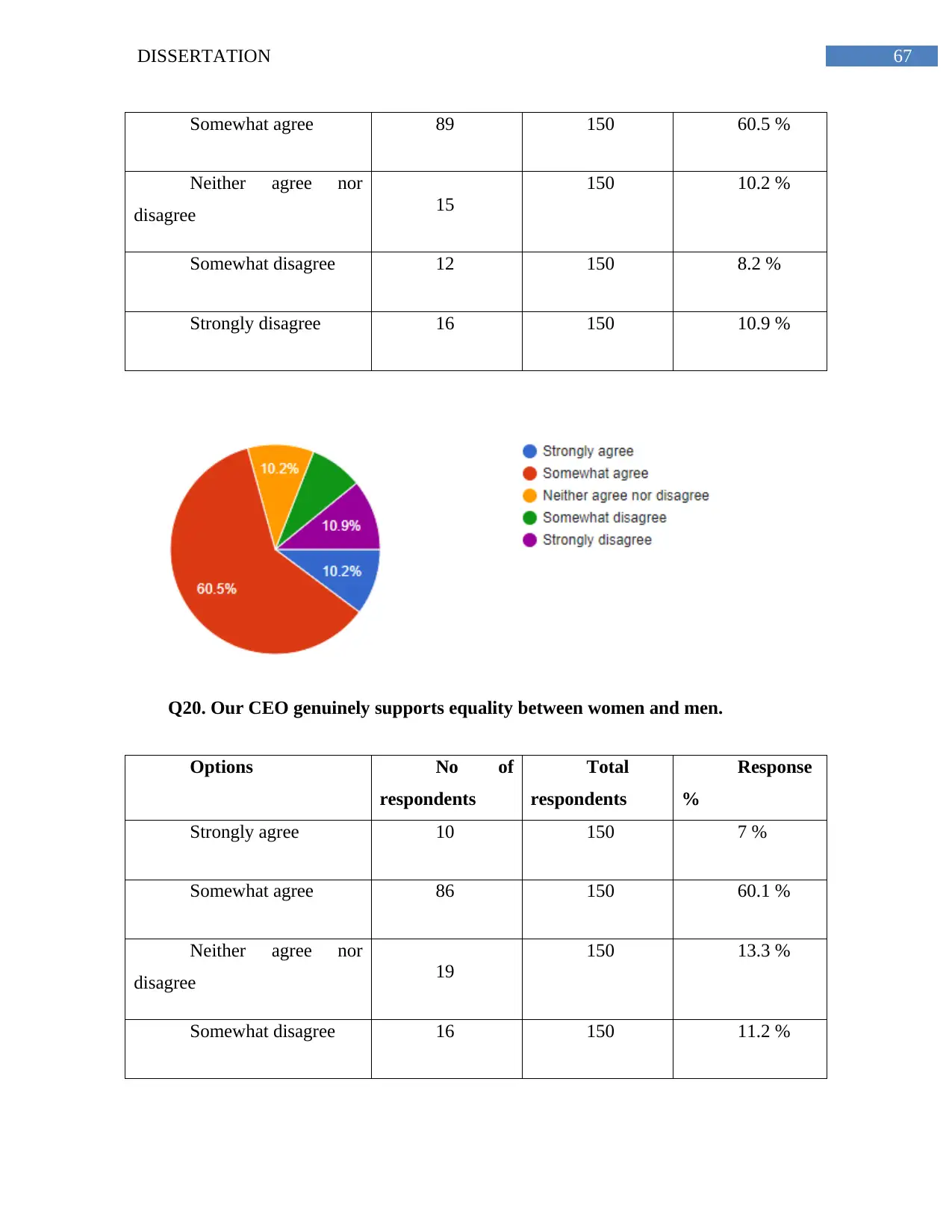
Somewhat agree 89 150 60.5 %
Neither agree nor
disagree 15
150 10.2 %
Somewhat disagree 12 150 8.2 %
Strongly disagree 16 150 10.9 %
Q20. Our CEO genuinely supports equality between women and men.
Options No of
respondents
Total
respondents
Response
%
Strongly agree 10 150 7 %
Somewhat agree 86 150 60.1 %
Neither agree nor
disagree 19
150 13.3 %
Somewhat disagree 16 150 11.2 %

Strongly disagree 12 150 8.4 %
Q21. I have the same opportunities for promotion as anyone else with my ability and
experience.
Options No of
respondents
Total
respondents
Response
%
Strongly agree 15 150 10.1 %
Somewhat agree 85 150 57.4 %
Neither agree nor
disagree 19
150 12.8 %
Somewhat disagree 9 150 6.1 %
Strongly disagree 20 150 13.5 %
⊘ This is a preview!⊘
Do you want full access?
Subscribe today to unlock all pages.

Trusted by 1+ million students worldwide
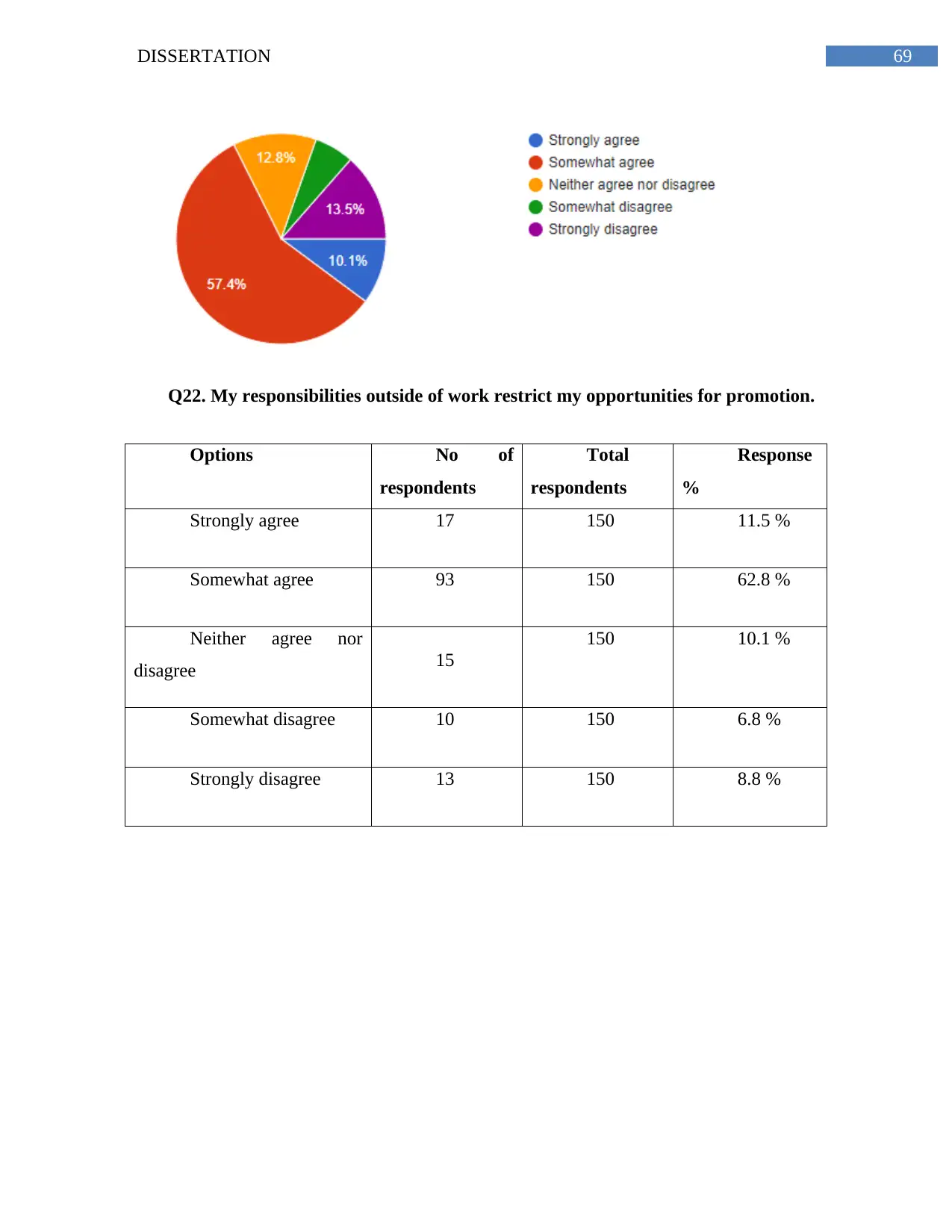
Q22. My responsibilities outside of work restrict my opportunities for promotion.
Options No of
respondents
Total
respondents
Response
%
Strongly agree 17 150 11.5 %
Somewhat agree 93 150 62.8 %
Neither agree nor
disagree 15
150 10.1 %
Somewhat disagree 10 150 6.8 %
Strongly disagree 13 150 8.8 %
Paraphrase This Document
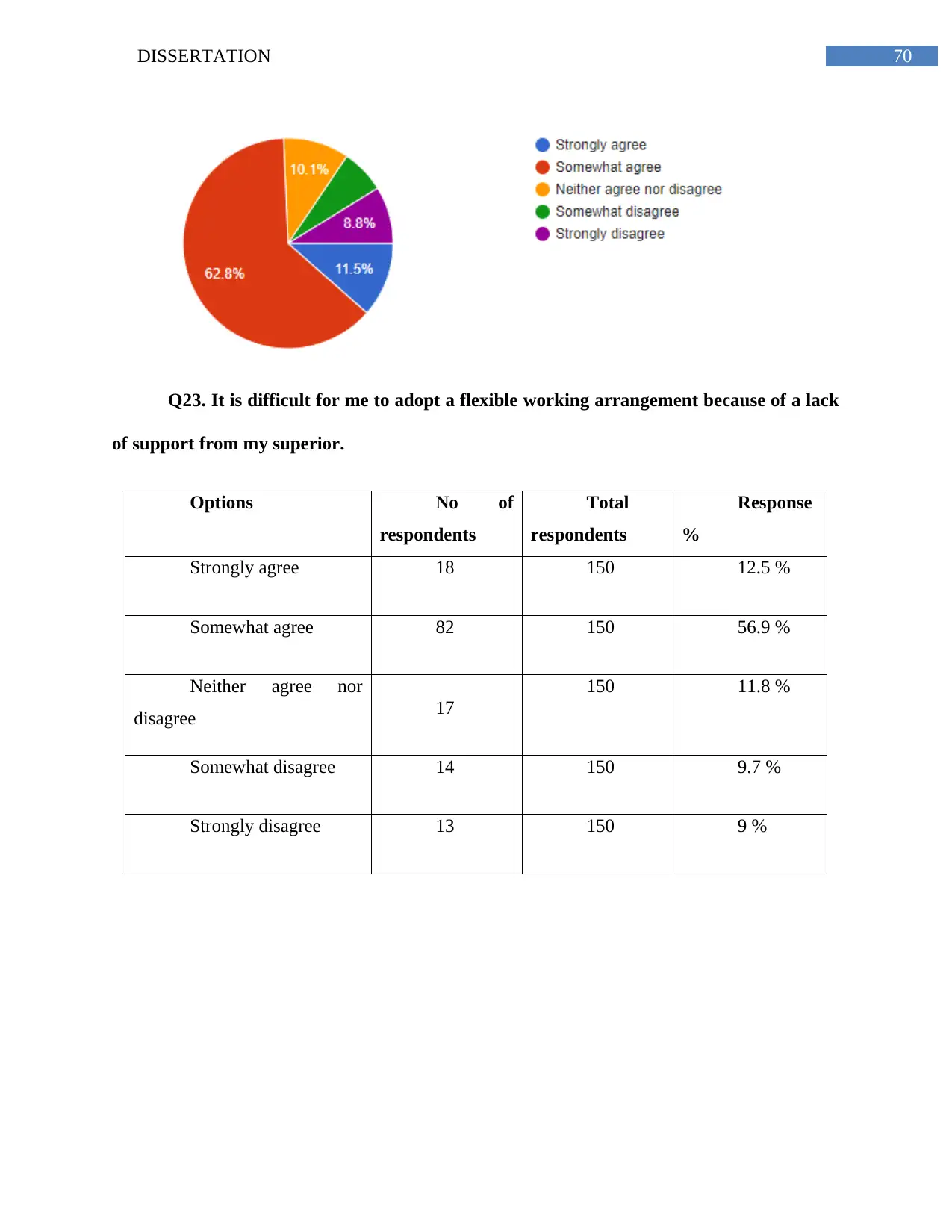
Q23. It is difficult for me to adopt a flexible working arrangement because of a lack
of support from my superior.
Options No of
respondents
Total
respondents
Response
%
Strongly agree 18 150 12.5 %
Somewhat agree 82 150 56.9 %
Neither agree nor
disagree 17
150 11.8 %
Somewhat disagree 14 150 9.7 %
Strongly disagree 13 150 9 %
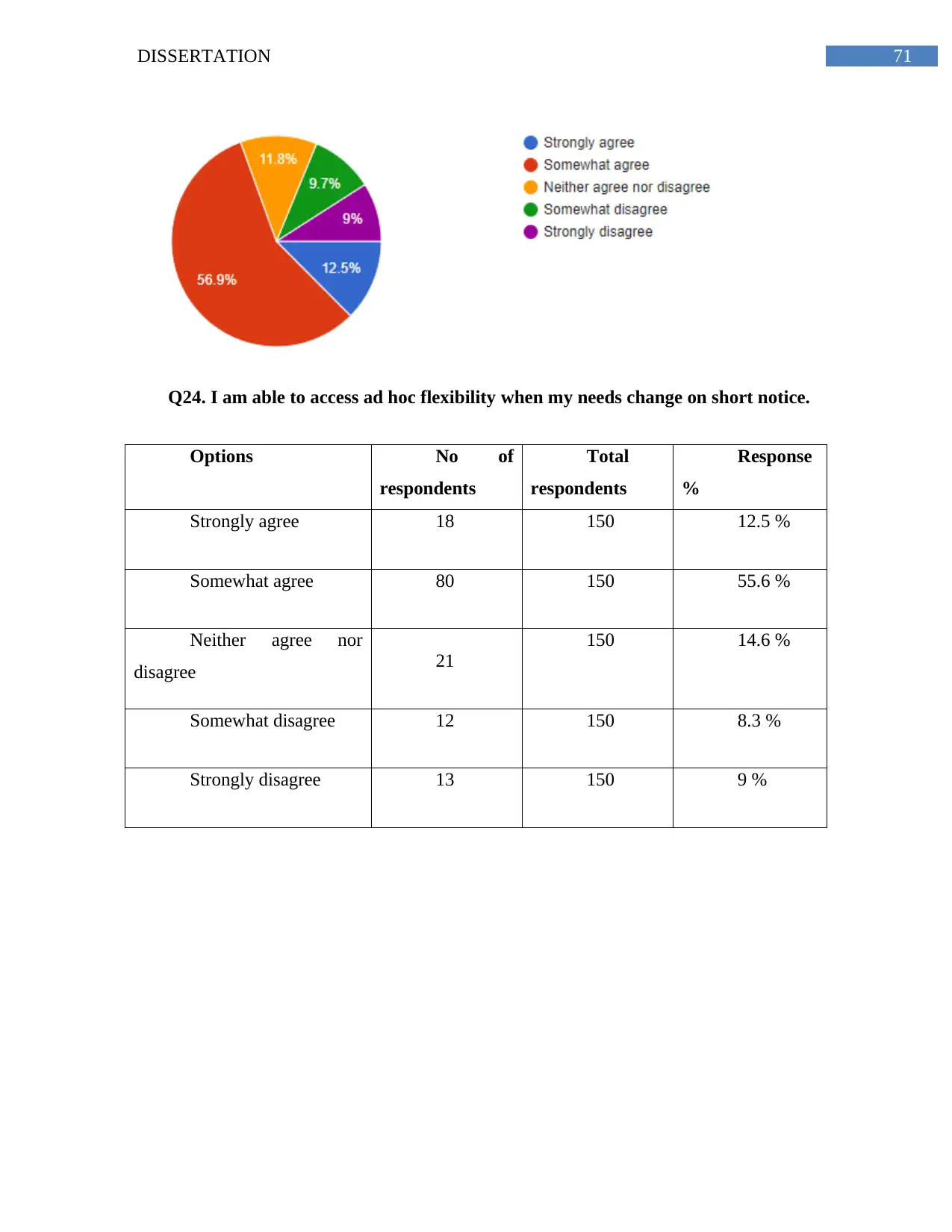
Q24. I am able to access ad hoc flexibility when my needs change on short notice.
Options No of
respondents
Total
respondents
Response
%
Strongly agree 18 150 12.5 %
Somewhat agree 80 150 55.6 %
Neither agree nor
disagree 21
150 14.6 %
Somewhat disagree 12 150 8.3 %
Strongly disagree 13 150 9 %
⊘ This is a preview!⊘
Do you want full access?
Subscribe today to unlock all pages.

Trusted by 1+ million students worldwide
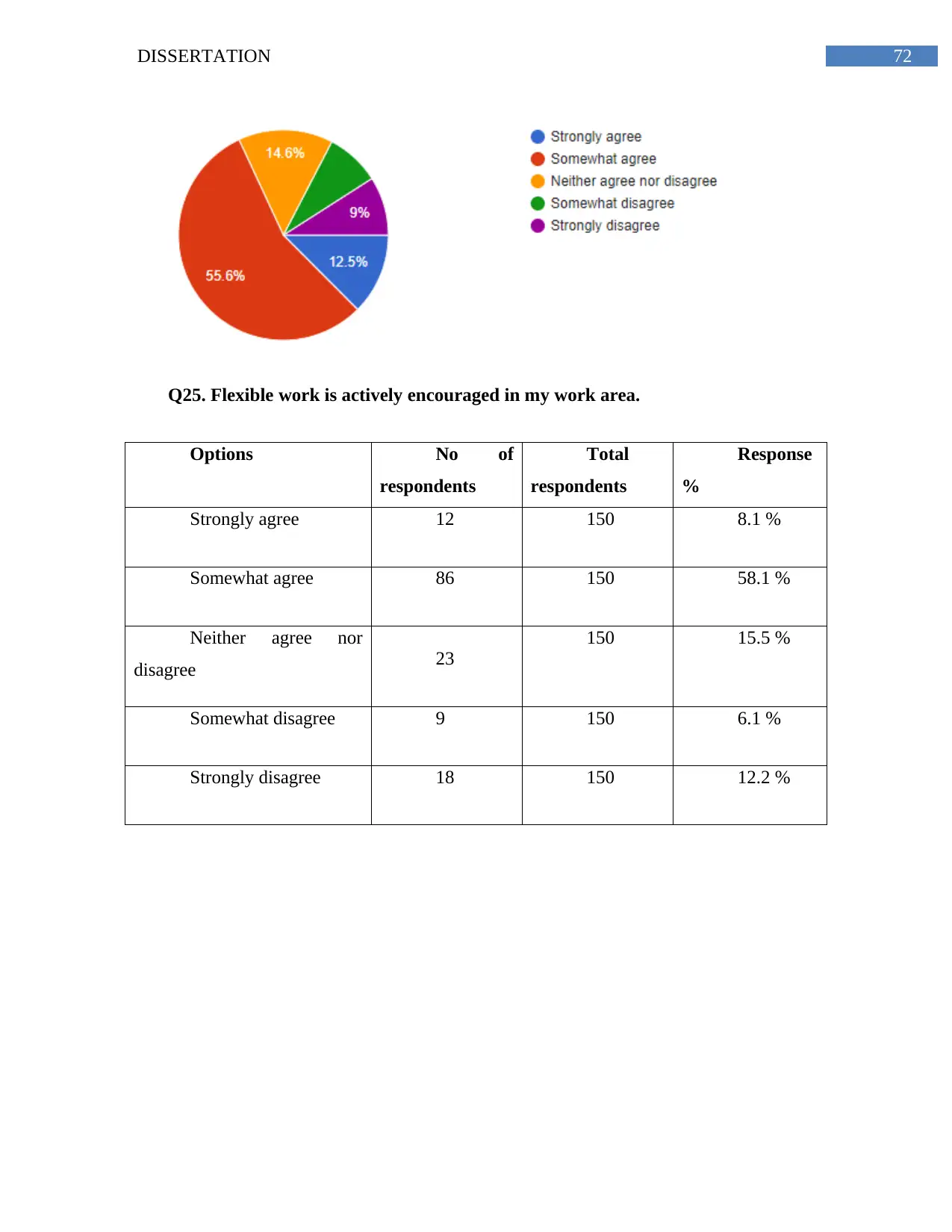
Q25. Flexible work is actively encouraged in my work area.
Options No of
respondents
Total
respondents
Response
%
Strongly agree 12 150 8.1 %
Somewhat agree 86 150 58.1 %
Neither agree nor
disagree 23
150 15.5 %
Somewhat disagree 9 150 6.1 %
Strongly disagree 18 150 12.2 %
Paraphrase This Document
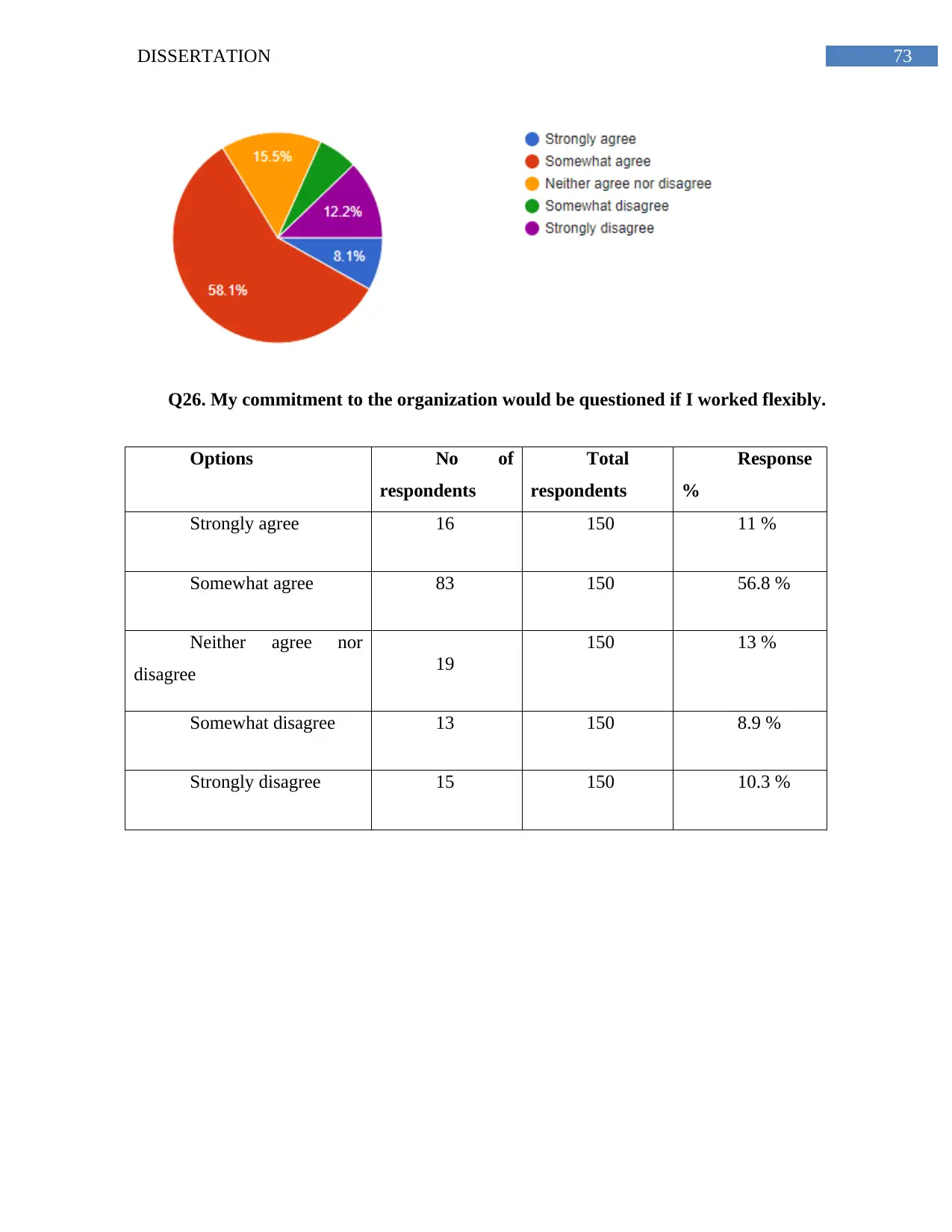
Q26. My commitment to the organization would be questioned if I worked flexibly.
Options No of
respondents
Total
respondents
Response
%
Strongly agree 16 150 11 %
Somewhat agree 83 150 56.8 %
Neither agree nor
disagree 19
150 13 %
Somewhat disagree 13 150 8.9 %
Strongly disagree 15 150 10.3 %
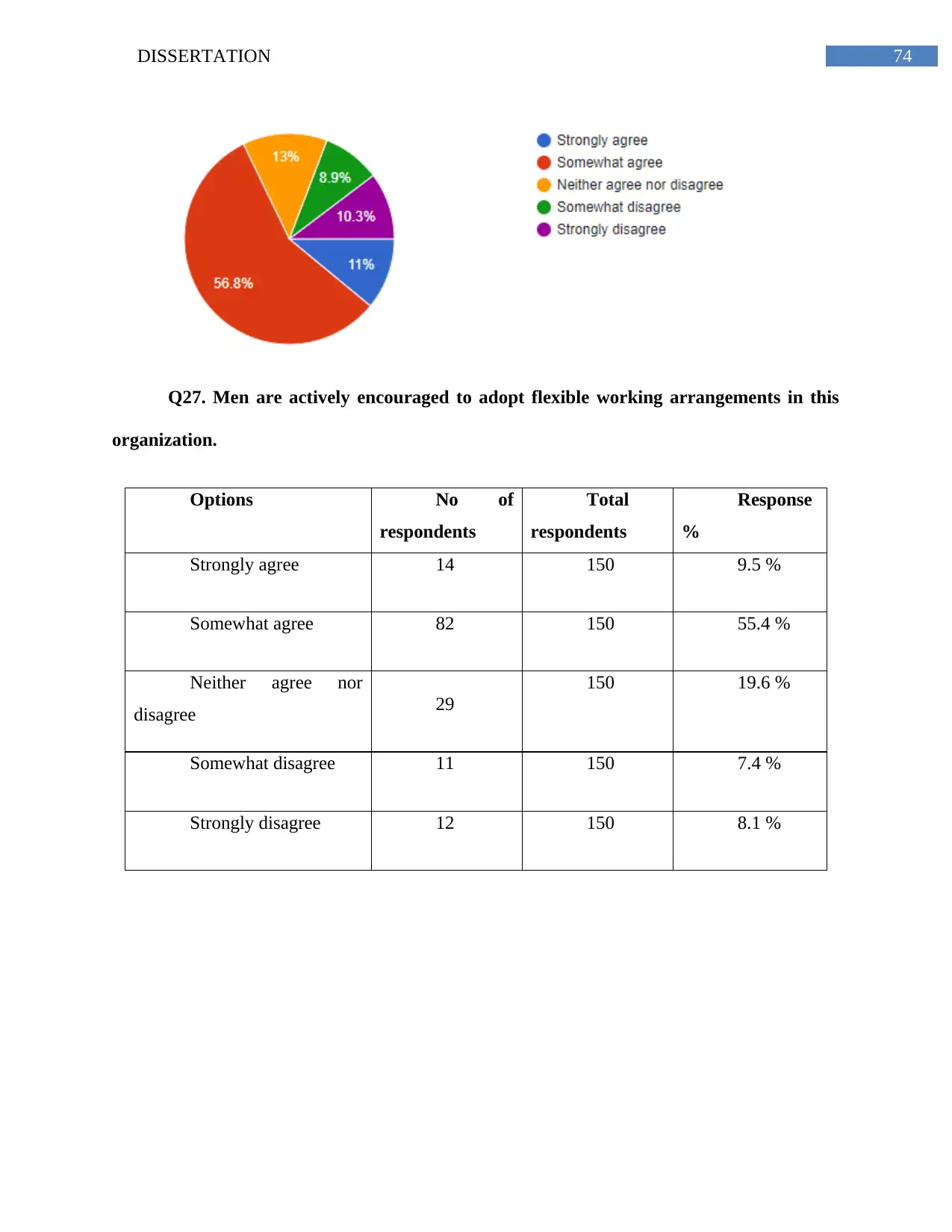
Q27. Men are actively encouraged to adopt flexible working arrangements in this
organization.
Options No of
respondents
Total
respondents
Response
%
Strongly agree 14 150 9.5 %
Somewhat agree 82 150 55.4 %
Neither agree nor
disagree 29
150 19.6 %
Somewhat disagree 11 150 7.4 %
Strongly disagree 12 150 8.1 %
⊘ This is a preview!⊘
Do you want full access?
Subscribe today to unlock all pages.

Trusted by 1+ million students worldwide
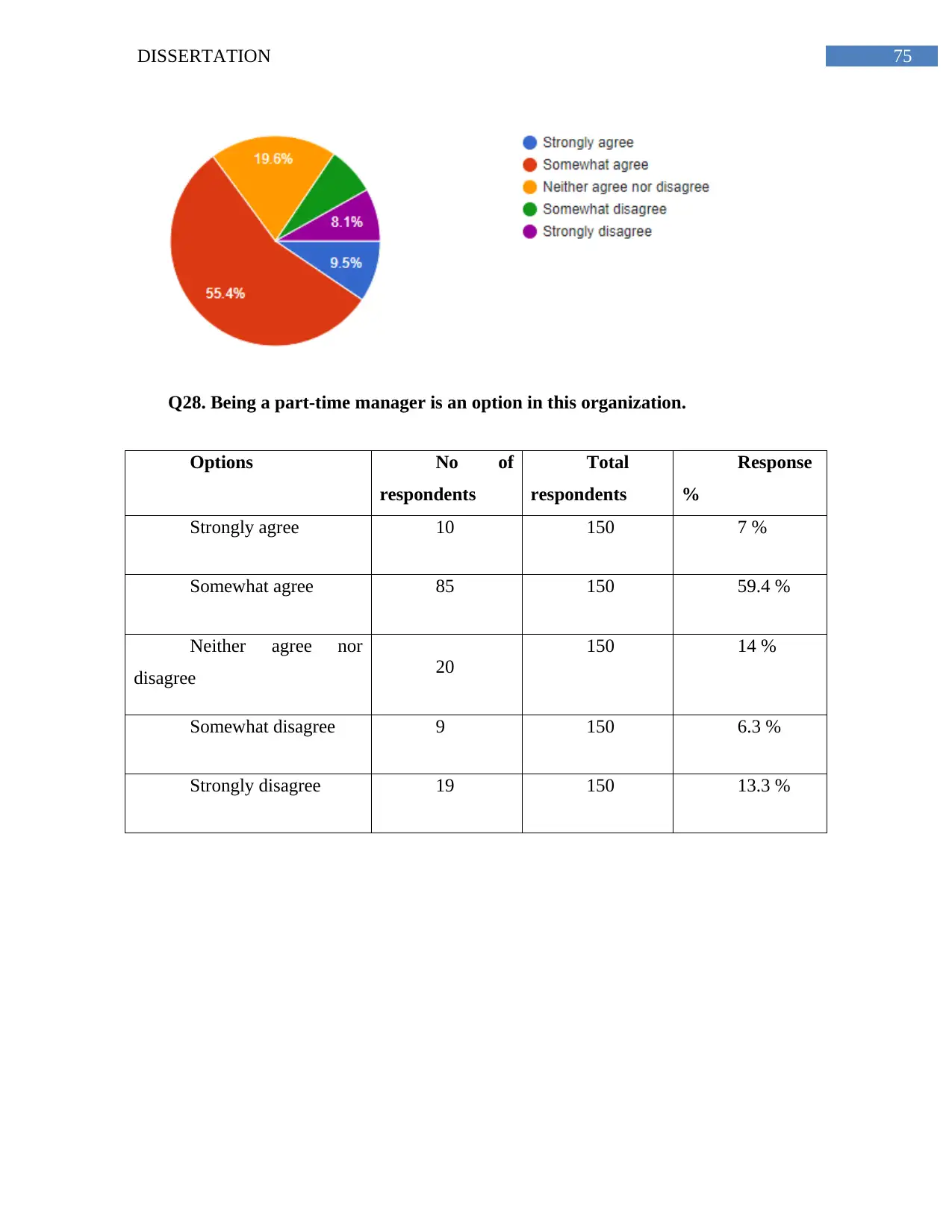
Q28. Being a part-time manager is an option in this organization.
Options No of
respondents
Total
respondents
Response
%
Strongly agree 10 150 7 %
Somewhat agree 85 150 59.4 %
Neither agree nor
disagree 20
150 14 %
Somewhat disagree 9 150 6.3 %
Strongly disagree 19 150 13.3 %
Paraphrase This Document
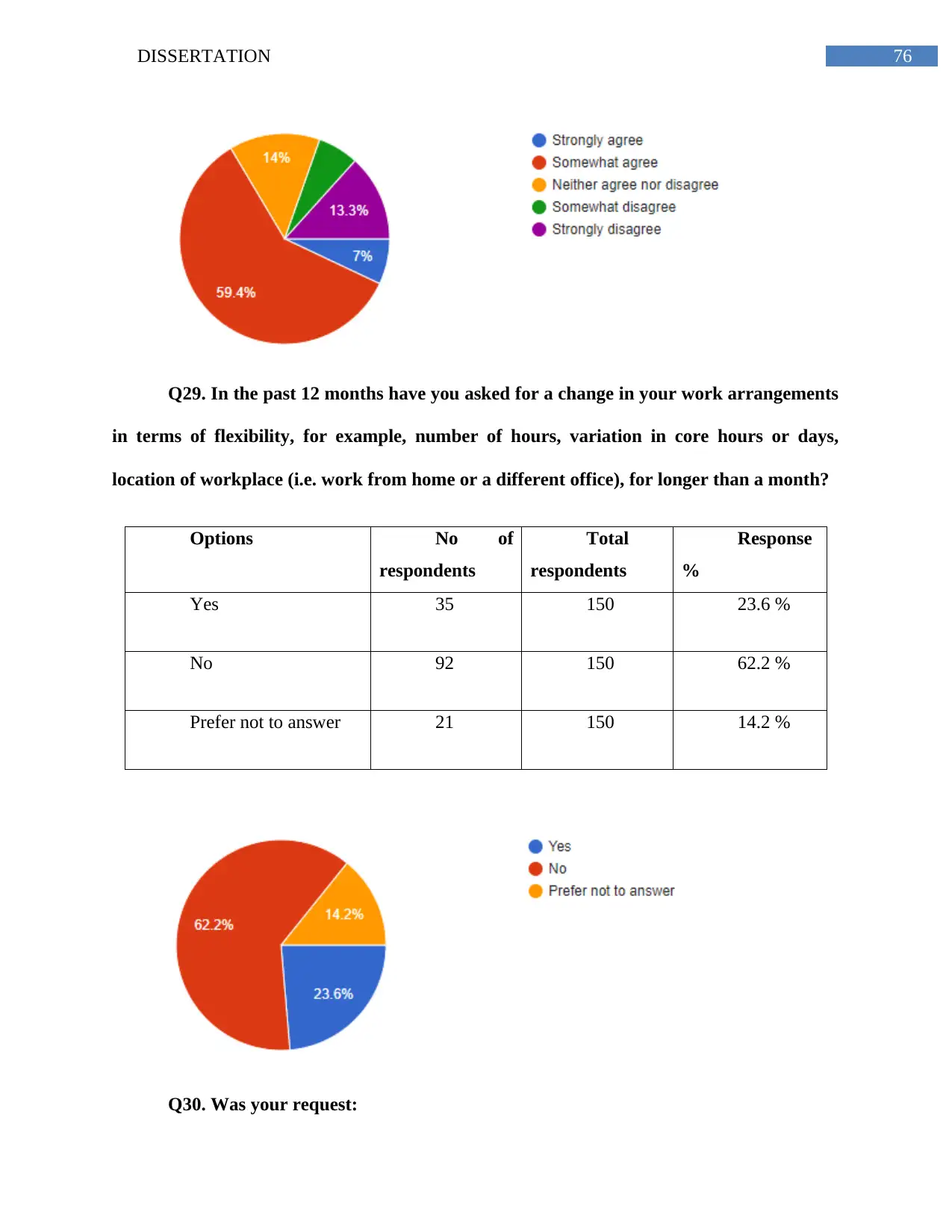
Q29. In the past 12 months have you asked for a change in your work arrangements
in terms of flexibility, for example, number of hours, variation in core hours or days,
location of workplace (i.e. work from home or a different office), for longer than a month?
Options No of
respondents
Total
respondents
Response
%
Yes 35 150 23.6 %
No 92 150 62.2 %
Prefer not to answer 21 150 14.2 %
Q30. Was your request:
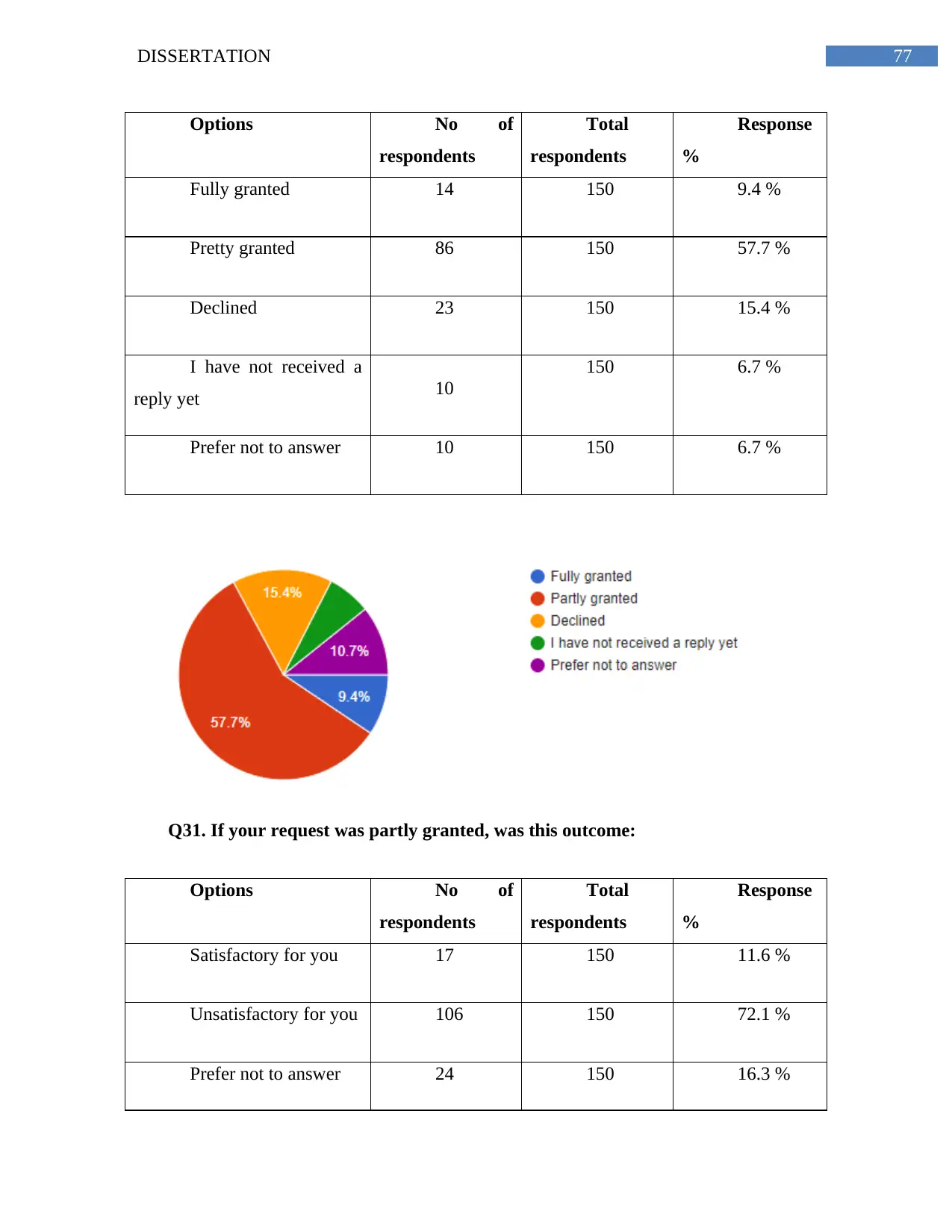
Options No of
respondents
Total
respondents
Response
%
Fully granted 14 150 9.4 %
Pretty granted 86 150 57.7 %
Declined 23 150 15.4 %
I have not received a
reply yet 10
150 6.7 %
Prefer not to answer 10 150 6.7 %
Q31. If your request was partly granted, was this outcome:
Options No of
respondents
Total
respondents
Response
%
Satisfactory for you 17 150 11.6 %
Unsatisfactory for you 106 150 72.1 %
Prefer not to answer 24 150 16.3 %
⊘ This is a preview!⊘
Do you want full access?
Subscribe today to unlock all pages.

Trusted by 1+ million students worldwide
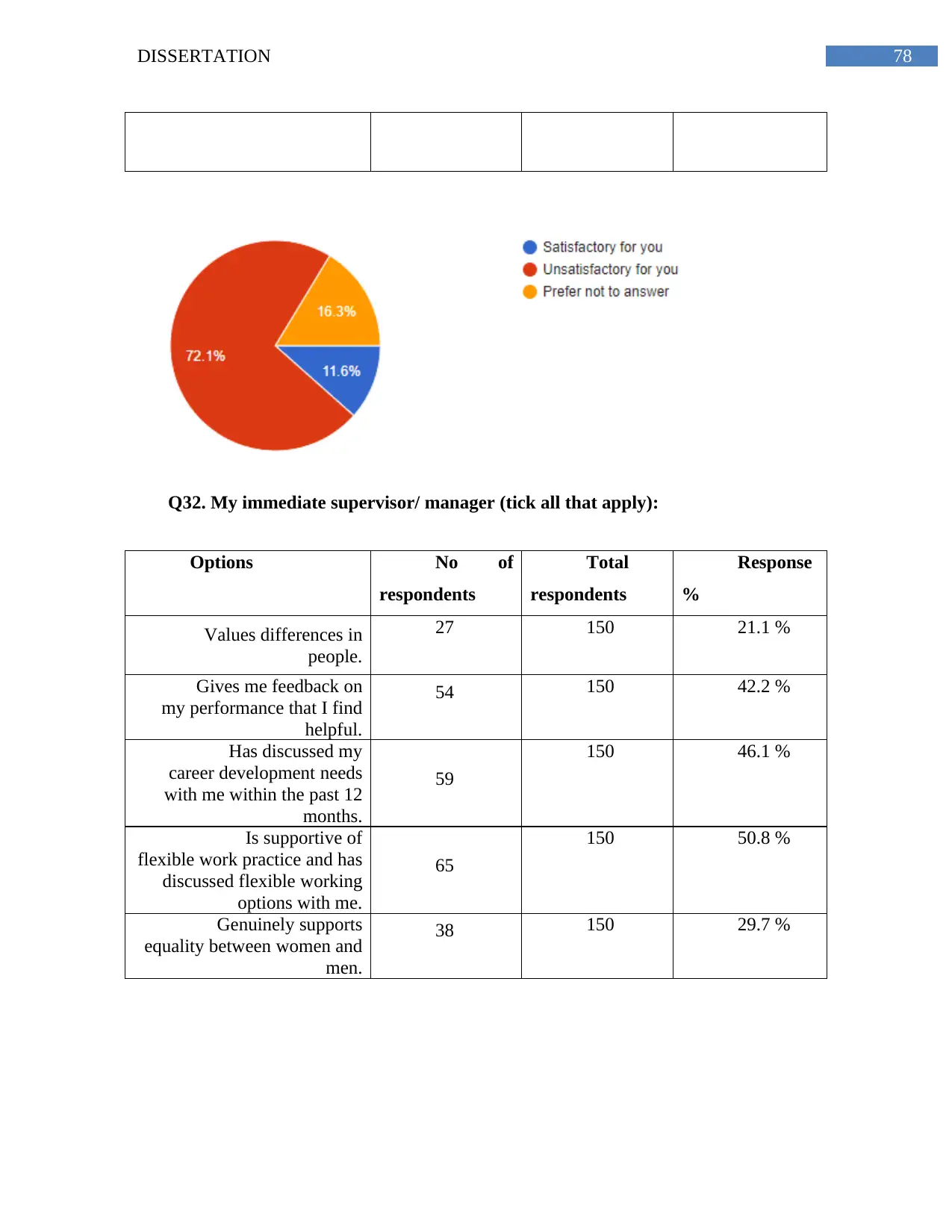
Q32. My immediate supervisor/ manager (tick all that apply):
Options No of
respondents
Total
respondents
Response
%
Values differences in
people.
27 150 21.1 %
Gives me feedback on
my performance that I find
helpful.
54 150 42.2 %
Has discussed my
career development needs
with me within the past 12
months.
59
150 46.1 %
Is supportive of
flexible work practice and has
discussed flexible working
options with me.
65
150 50.8 %
Genuinely supports
equality between women and
men.
38 150 29.7 %
Paraphrase This Document

Q33. I would recommend working in this organization to my male friends.
Options No of
respondents
Total
respondents
Response
%
Strongly agree 13 150 8.8 %
Somewhat agree 85 150 57.8 %
Neither agree nor
disagree 22
150 15 %
Somewhat disagree 18 150 12.2 %
Strongly disagree 9 150 6.1 %
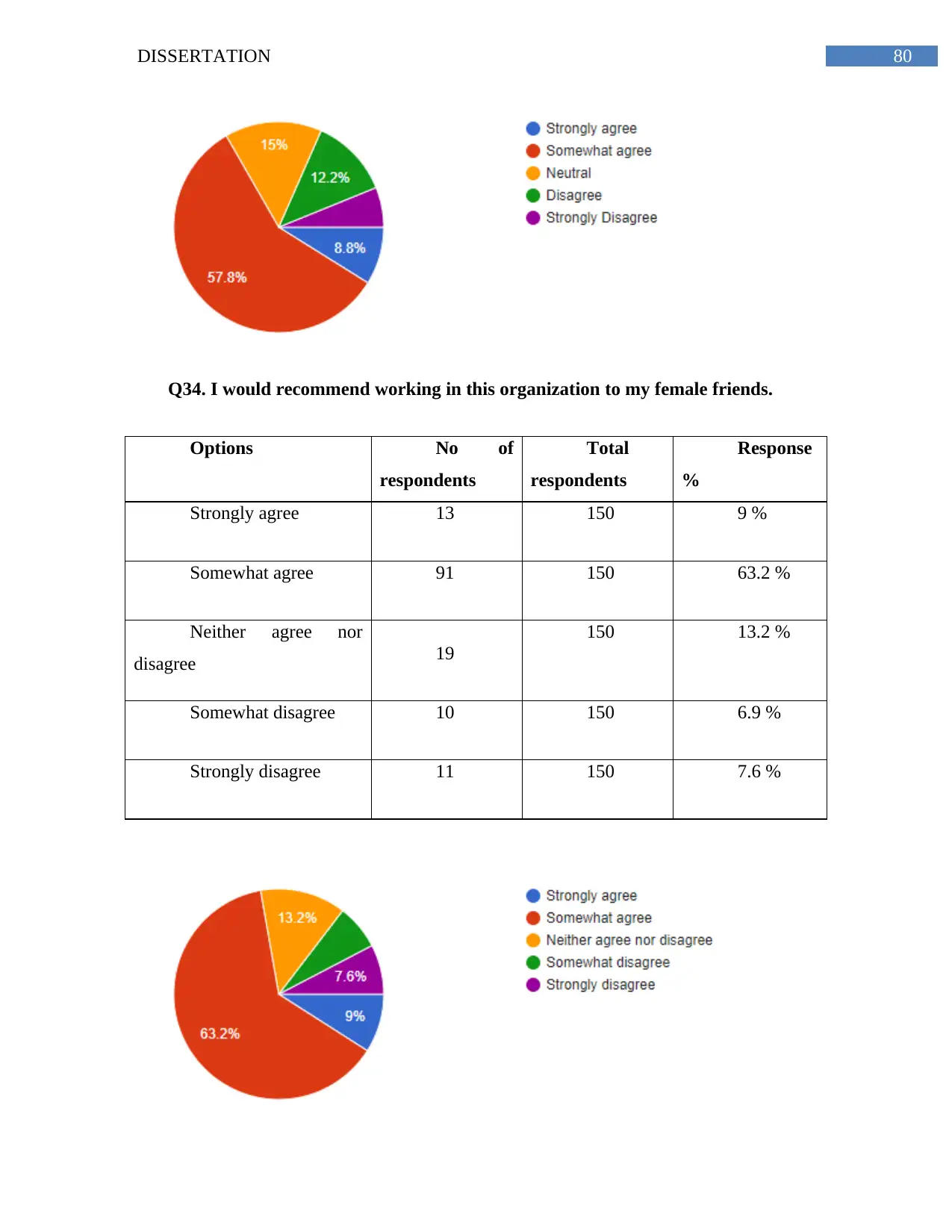
Q34. I would recommend working in this organization to my female friends.
Options No of
respondents
Total
respondents
Response
%
Strongly agree 13 150 9 %
Somewhat agree 91 150 63.2 %
Neither agree nor
disagree 19
150 13.2 %
Somewhat disagree 10 150 6.9 %
Strongly disagree 11 150 7.6 %
⊘ This is a preview!⊘
Do you want full access?
Subscribe today to unlock all pages.

Trusted by 1+ million students worldwide
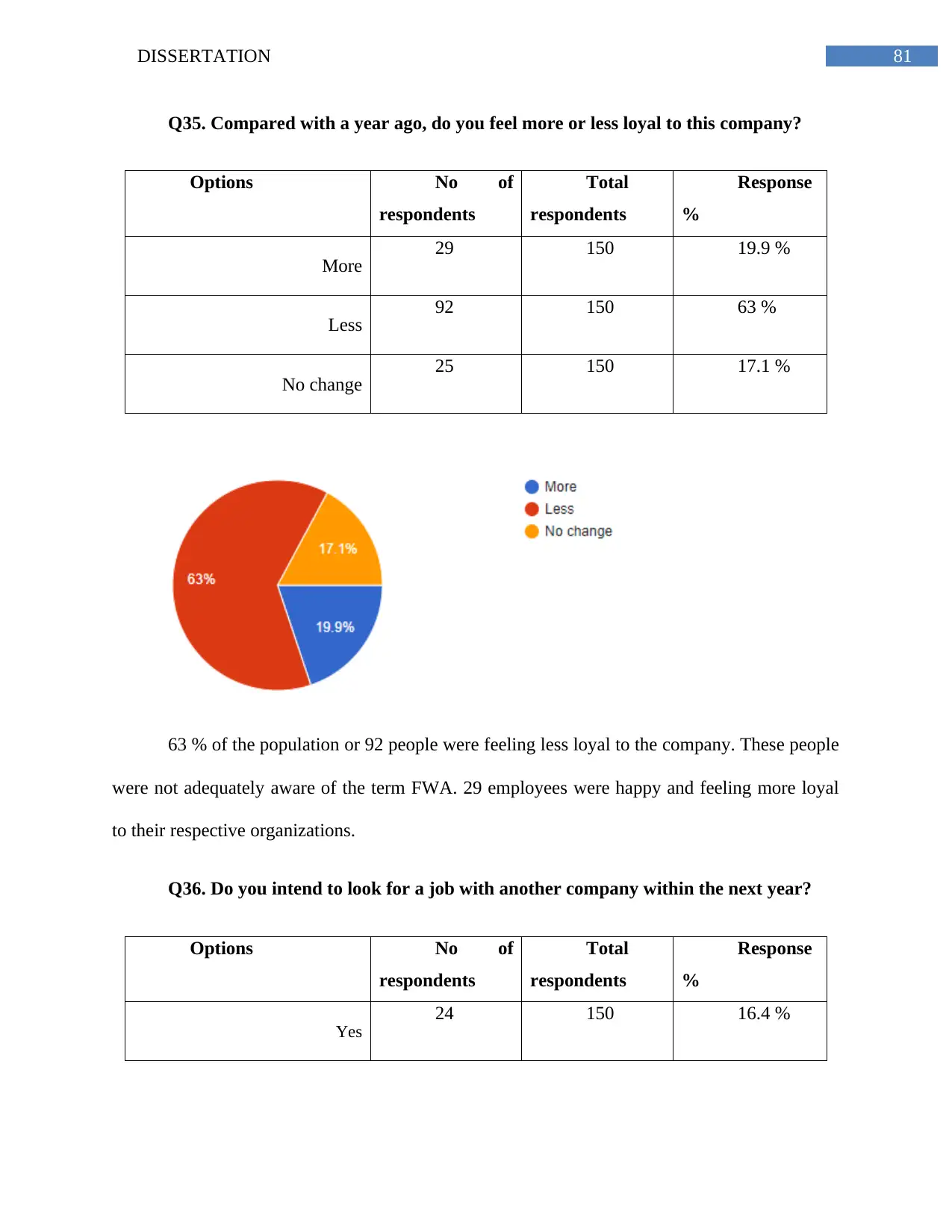
Q35. Compared with a year ago, do you feel more or less loyal to this company?
Options No of
respondents
Total
respondents
Response
%
More 29 150 19.9 %
Less 92 150 63 %
No change 25 150 17.1 %
63 % of the population or 92 people were feeling less loyal to the company. These people
were not adequately aware of the term FWA. 29 employees were happy and feeling more loyal
to their respective organizations.
Q36. Do you intend to look for a job with another company within the next year?
Options No of
respondents
Total
respondents
Response
%
Yes
24 150 16.4 %
Paraphrase This Document
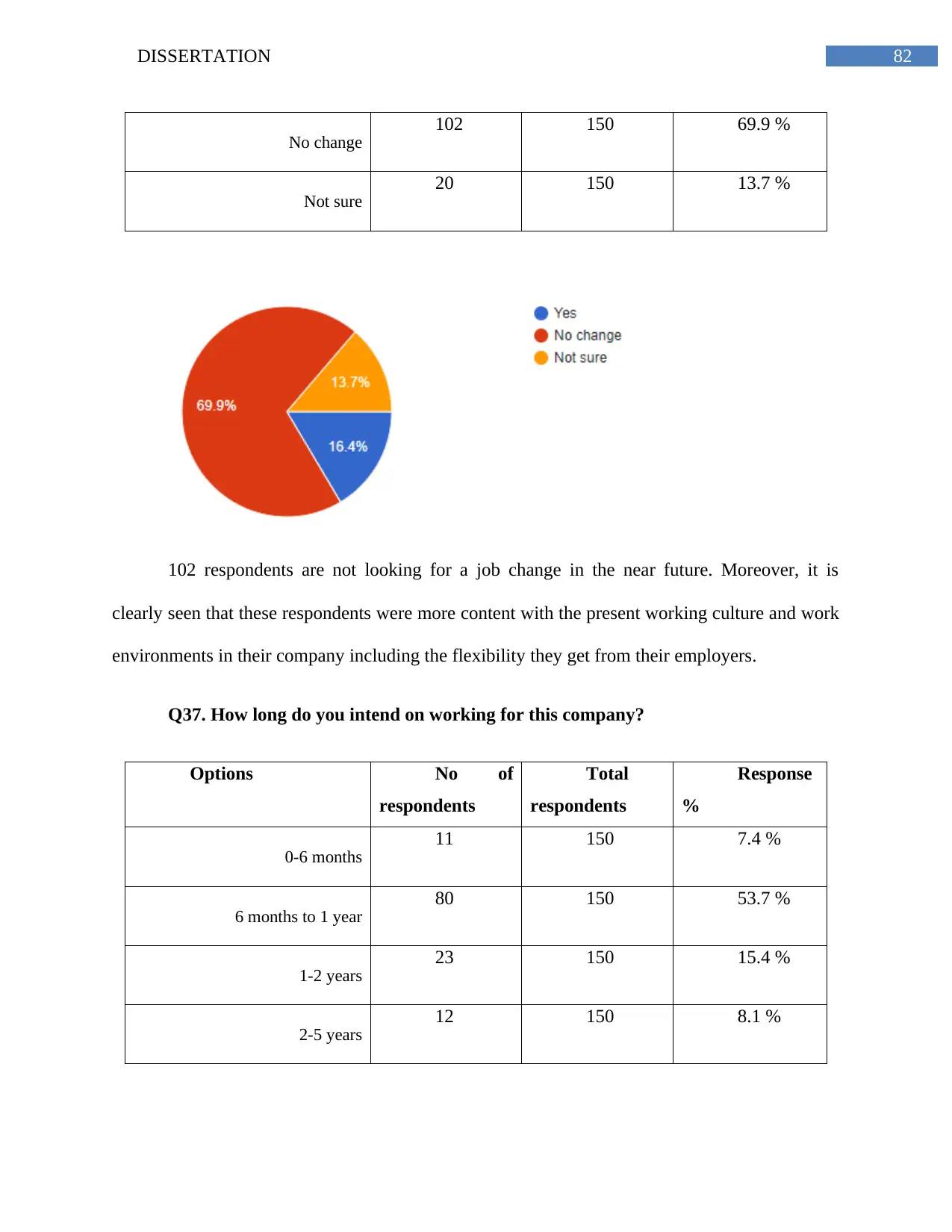
No change
102 150 69.9 %
Not sure
20 150 13.7 %
102 respondents are not looking for a job change in the near future. Moreover, it is
clearly seen that these respondents were more content with the present working culture and work
environments in their company including the flexibility they get from their employers.
Q37. How long do you intend on working for this company?
Options No of
respondents
Total
respondents
Response
%
0-6 months
11 150 7.4 %
6 months to 1 year
80 150 53.7 %
1-2 years
23 150 15.4 %
2-5 years
12 150 8.1 %
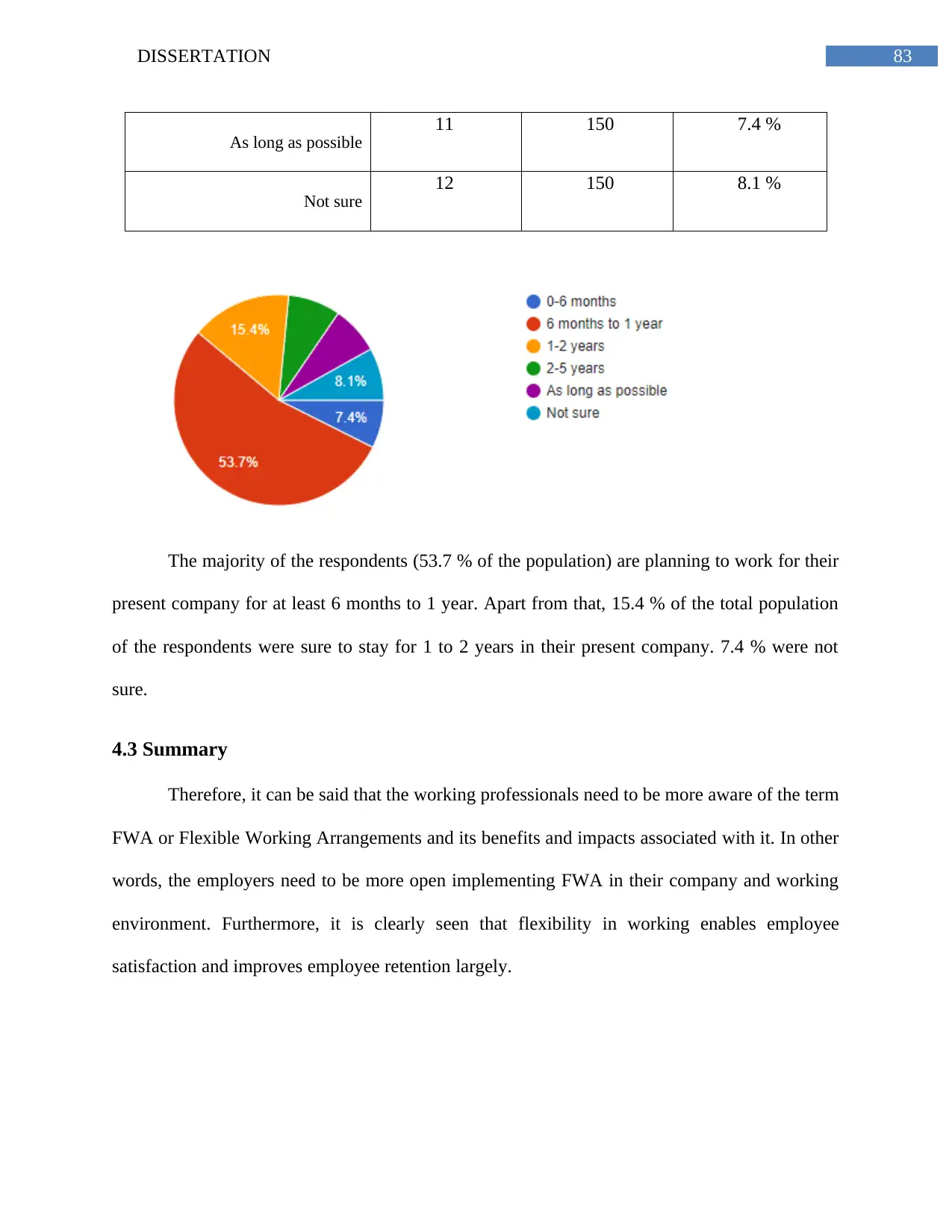
As long as possible
11 150 7.4 %
Not sure
12 150 8.1 %
The majority of the respondents (53.7 % of the population) are planning to work for their
present company for at least 6 months to 1 year. Apart from that, 15.4 % of the total population
of the respondents were sure to stay for 1 to 2 years in their present company. 7.4 % were not
sure.
4.3 Summary
Therefore, it can be said that the working professionals need to be more aware of the term
FWA or Flexible Working Arrangements and its benefits and impacts associated with it. In other
words, the employers need to be more open implementing FWA in their company and working
environment. Furthermore, it is clearly seen that flexibility in working enables employee
satisfaction and improves employee retention largely.
⊘ This is a preview!⊘
Do you want full access?
Subscribe today to unlock all pages.

Trusted by 1+ million students worldwide
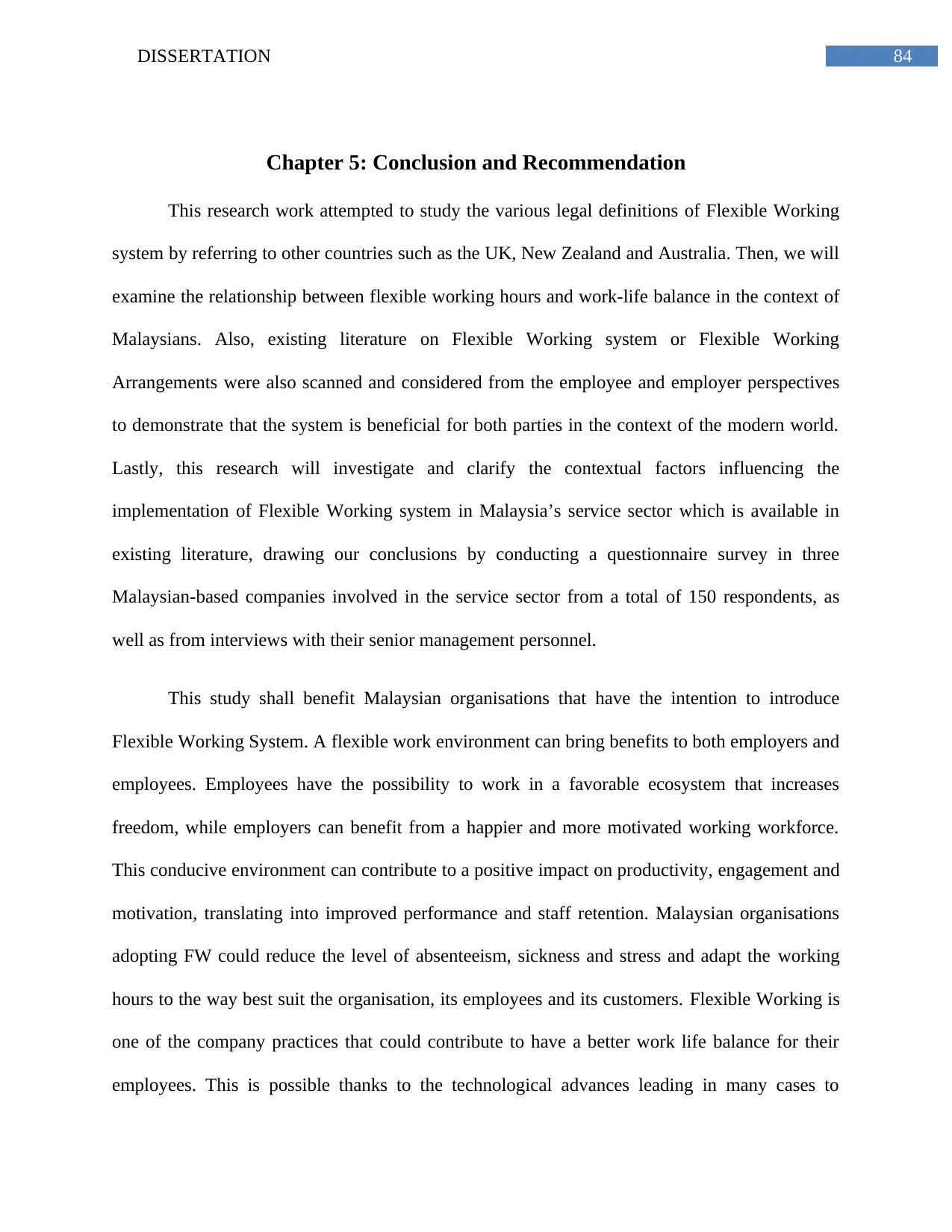
Chapter 5: Conclusion and Recommendation
This research work attempted to study the various legal definitions of Flexible Working
system by referring to other countries such as the UK, New Zealand and Australia. Then, we will
examine the relationship between flexible working hours and work-life balance in the context of
Malaysians. Also, existing literature on Flexible Working system or Flexible Working
Arrangements were also scanned and considered from the employee and employer perspectives
to demonstrate that the system is beneficial for both parties in the context of the modern world.
Lastly, this research will investigate and clarify the contextual factors influencing the
implementation of Flexible Working system in Malaysia’s service sector which is available in
existing literature, drawing our conclusions by conducting a questionnaire survey in three
Malaysian-based companies involved in the service sector from a total of 150 respondents, as
well as from interviews with their senior management personnel.
This study shall benefit Malaysian organisations that have the intention to introduce
Flexible Working System. A flexible work environment can bring benefits to both employers and
employees. Employees have the possibility to work in a favorable ecosystem that increases
freedom, while employers can benefit from a happier and more motivated working workforce.
This conducive environment can contribute to a positive impact on productivity, engagement and
motivation, translating into improved performance and staff retention. Malaysian organisations
adopting FW could reduce the level of absenteeism, sickness and stress and adapt the working
hours to the way best suit the organisation, its employees and its customers. Flexible Working is
one of the company practices that could contribute to have a better work life balance for their
employees. This is possible thanks to the technological advances leading in many cases to
Paraphrase This Document
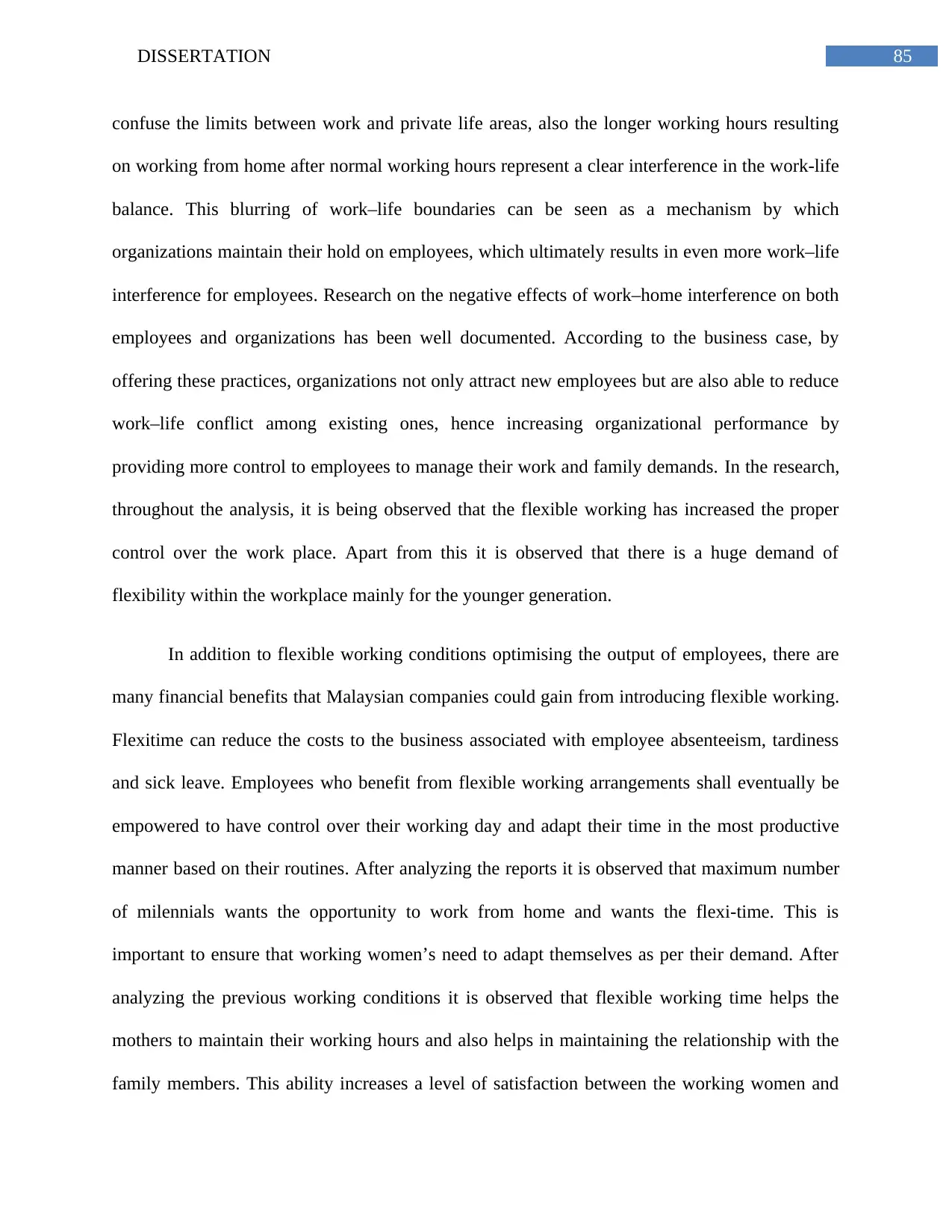
confuse the limits between work and private life areas, also the longer working hours resulting
on working from home after normal working hours represent a clear interference in the work-life
balance. This blurring of work–life boundaries can be seen as a mechanism by which
organizations maintain their hold on employees, which ultimately results in even more work–life
interference for employees. Research on the negative effects of work–home interference on both
employees and organizations has been well documented. According to the business case, by
offering these practices, organizations not only attract new employees but are also able to reduce
work–life conflict among existing ones, hence increasing organizational performance by
providing more control to employees to manage their work and family demands. In the research,
throughout the analysis, it is being observed that the flexible working has increased the proper
control over the work place. Apart from this it is observed that there is a huge demand of
flexibility within the workplace mainly for the younger generation.
In addition to flexible working conditions optimising the output of employees, there are
many financial benefits that Malaysian companies could gain from introducing flexible working.
Flexitime can reduce the costs to the business associated with employee absenteeism, tardiness
and sick leave. Employees who benefit from flexible working arrangements shall eventually be
empowered to have control over their working day and adapt their time in the most productive
manner based on their routines. After analyzing the reports it is observed that maximum number
of milennials wants the opportunity to work from home and wants the flexi-time. This is
important to ensure that working women’s need to adapt themselves as per their demand. After
analyzing the previous working conditions it is observed that flexible working time helps the
mothers to maintain their working hours and also helps in maintaining the relationship with the
family members. This ability increases a level of satisfaction between the working women and
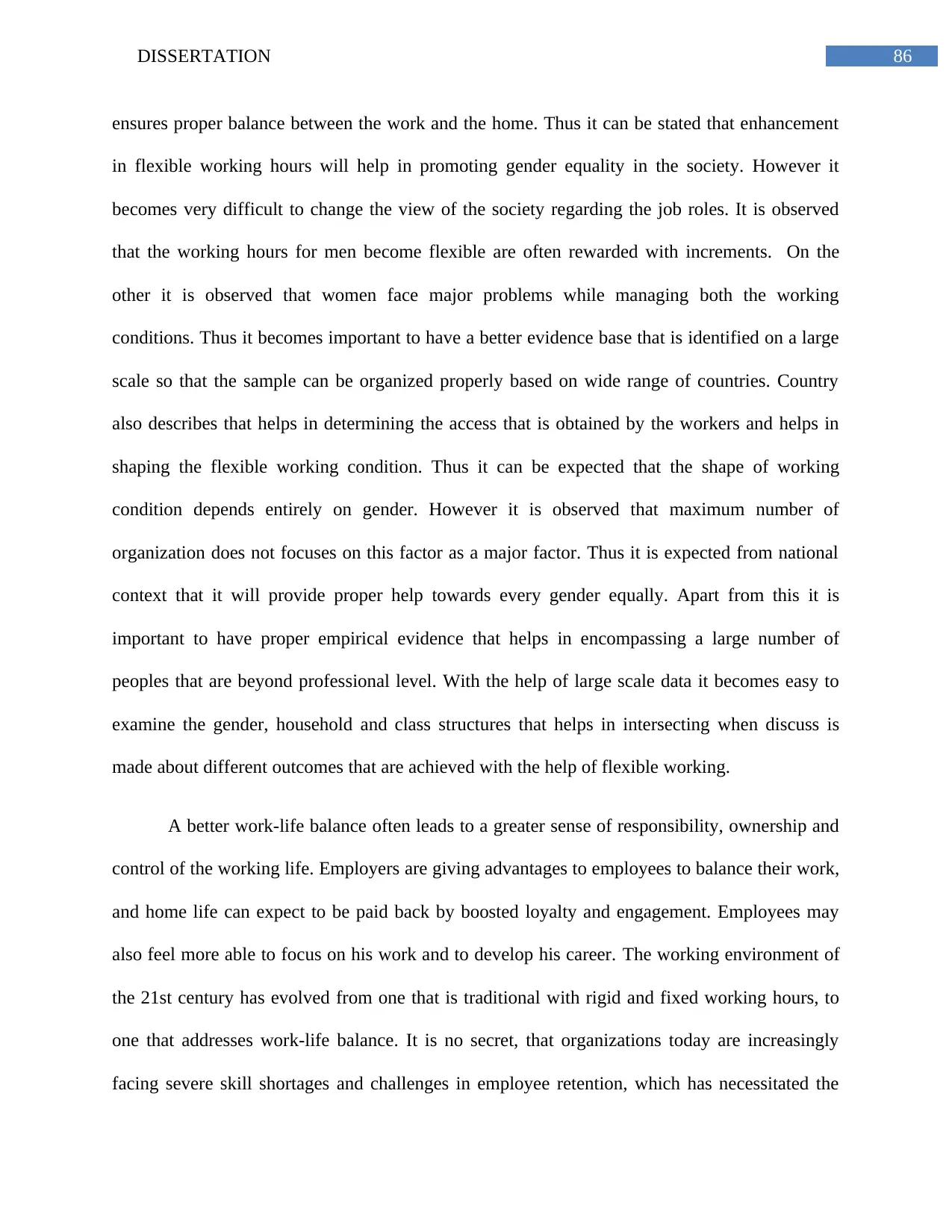
ensures proper balance between the work and the home. Thus it can be stated that enhancement
in flexible working hours will help in promoting gender equality in the society. However it
becomes very difficult to change the view of the society regarding the job roles. It is observed
that the working hours for men become flexible are often rewarded with increments. On the
other it is observed that women face major problems while managing both the working
conditions. Thus it becomes important to have a better evidence base that is identified on a large
scale so that the sample can be organized properly based on wide range of countries. Country
also describes that helps in determining the access that is obtained by the workers and helps in
shaping the flexible working condition. Thus it can be expected that the shape of working
condition depends entirely on gender. However it is observed that maximum number of
organization does not focuses on this factor as a major factor. Thus it is expected from national
context that it will provide proper help towards every gender equally. Apart from this it is
important to have proper empirical evidence that helps in encompassing a large number of
peoples that are beyond professional level. With the help of large scale data it becomes easy to
examine the gender, household and class structures that helps in intersecting when discuss is
made about different outcomes that are achieved with the help of flexible working.
A better work-life balance often leads to a greater sense of responsibility, ownership and
control of the working life. Employers are giving advantages to employees to balance their work,
and home life can expect to be paid back by boosted loyalty and engagement. Employees may
also feel more able to focus on his work and to develop his career. The working environment of
the 21st century has evolved from one that is traditional with rigid and fixed working hours, to
one that addresses work-life balance. It is no secret, that organizations today are increasingly
facing severe skill shortages and challenges in employee retention, which has necessitated the
⊘ This is a preview!⊘
Do you want full access?
Subscribe today to unlock all pages.

Trusted by 1+ million students worldwide

need to adopt a new approach that incorporates a culture of trust in the form of offering
flexibility to employees in the workplace. Also, the evolution in demographics, cultural,
economic and legal environments have also brought about impacts on various human resource
management aspects, including employee recruitment and retention. The answer to this is the
emergence of Flexible Working systems (FWS), or known also as Flexible Working
Arrangements (FWA).
Flexible working can contribute to reducing stress and fatigue; factors which may lead to
employees losing focus and motivation and as a result, underperforming at their job function.
Also allows employers to better balance work demands with personal demands ensuring
improved concentration on work tasks during work hours. As Flexible working improves
employee satisfaction and retention, the need to recruit new employees and the associated costs
are diminished. Most importantly, flexible working is inexpensive to implement and can offer a
quick, measurable return on investment in the form of employee output. As Malaysia strives hard
to become a developed nation, it had slowly embraced industrialisation in the decades since
gaining independence in 1957, when agriculture was still the predominant economic driver, and
subsequently the manufacturing sector becoming the leading sector in terms of employment
between 1970 and 1980, and in terms of job creation between 1985 and 1995.
Despite the fact that monetary rewards such as salary, allowances and annual bonuses are
still of paramount importance to the employee, there has been a shift in emphasis towards non-
monetary benefits, where flexible working has been observed to be used as a tool to manage
employee turnovers. Scholars have argued that monetary rewards alone are not sustainable
drivers for job commitment and motivations, due to the social value shifts among the younger
generation. Due to this reason, leading conglomerates around the world such as Nestle and
Paraphrase This Document
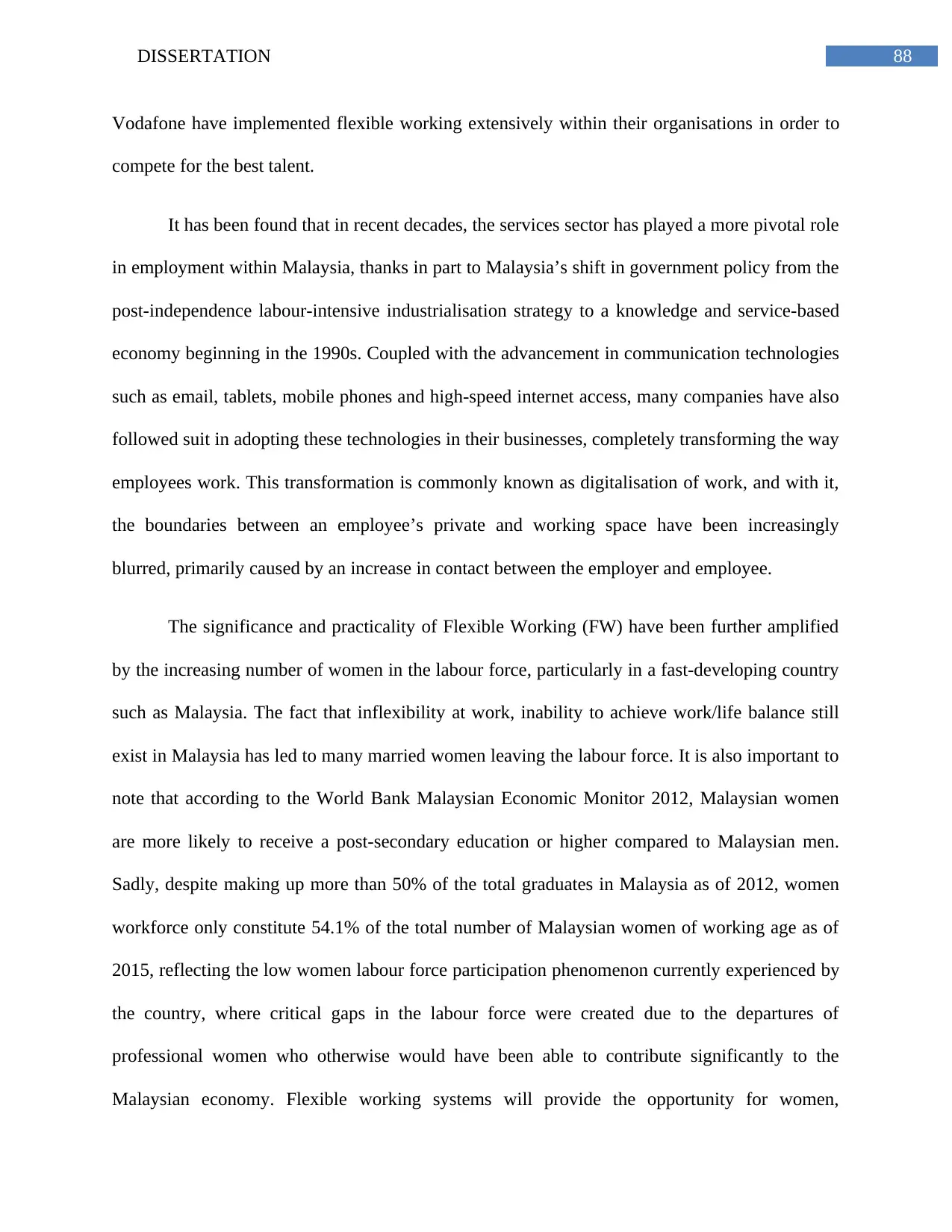
Vodafone have implemented flexible working extensively within their organisations in order to
compete for the best talent.
It has been found that in recent decades, the services sector has played a more pivotal role
in employment within Malaysia, thanks in part to Malaysia’s shift in government policy from the
post-independence labour-intensive industrialisation strategy to a knowledge and service-based
economy beginning in the 1990s. Coupled with the advancement in communication technologies
such as email, tablets, mobile phones and high-speed internet access, many companies have also
followed suit in adopting these technologies in their businesses, completely transforming the way
employees work. This transformation is commonly known as digitalisation of work, and with it,
the boundaries between an employee’s private and working space have been increasingly
blurred, primarily caused by an increase in contact between the employer and employee.
The significance and practicality of Flexible Working (FW) have been further amplified
by the increasing number of women in the labour force, particularly in a fast-developing country
such as Malaysia. The fact that inflexibility at work, inability to achieve work/life balance still
exist in Malaysia has led to many married women leaving the labour force. It is also important to
note that according to the World Bank Malaysian Economic Monitor 2012, Malaysian women
are more likely to receive a post-secondary education or higher compared to Malaysian men.
Sadly, despite making up more than 50% of the total graduates in Malaysia as of 2012, women
workforce only constitute 54.1% of the total number of Malaysian women of working age as of
2015, reflecting the low women labour force participation phenomenon currently experienced by
the country, where critical gaps in the labour force were created due to the departures of
professional women who otherwise would have been able to contribute significantly to the
Malaysian economy. Flexible working systems will provide the opportunity for women,

particularly married women with children, to strike a balance between work and family and
significantly close these gaps in the labour force.
Despite some progress being made over the years, there is still a lack of legislation that
governs flexible working in Malaysia. For the first time in June 2007, staggered working hours
in government offices were formally introduced after studies have found that it had contributed
to higher productivity amongst government servants. In the Public Services Department of
Malaysia, for example, civil servants were given three options to choose from as to when they
would like to start and complete work i.e. 7.30am to 4.30pm, 8.00am to 5.00pm, 8.30 to 5.30pm,
but they would still need to fulfil a fixed daily number of working hours. Companies in the
private sector such as Wah Seong Bhd., Airbus, DKSH, Keysight Technologies, Aegis, Besi,
BASF, Dell Computers, IBM, Intel Malaysia, Standard Chartered Bank Malaysia Bhd., Pantai
Holdings Sdn. Bhd. and Sunway Group has also introduced staggered working hours, each with
their different starting and ending working hours.
⊘ This is a preview!⊘
Do you want full access?
Subscribe today to unlock all pages.

Trusted by 1+ million students worldwide

Chapter 6: Reflective Learning
This research has provided me a lot of benefits regarding my academic and future
professional career. I have learned the practical applications of various research methods and
techniques as well as gained problem solving skills that helped me progress in this research. I
have also learned the gathering of primary and secondary through research surveys,
questionnaires, literature review and others. The research topic in this case was significantly
challenging as it focused on a complex problem in a country and I needed to conduct the study
considering the national background and also had to contact at least 150 people for conducting
detailed survey. Although FW is an extensive topic and can be implemented in various sectors of
the business world, in this study, I only focussed on three different businesses related to the
service sector, namely aircraft maintenance, oil palm manufacturing equipment supply and
healthcare services. Through employee surveys and interviews with the employers from this
three different sectors, I seeked to identify the potential barriers and challenges that may arise as
a result of the FW implementation, and finally explore the necessary pre-requisites or changes
needed to enable the successful adoption of FWS in Malaysia’s service sector. Based on my
study results, I published my work in this report with specific connection to the research topic
ensuring the research questions are answered through the results.
Paraphrase This Document
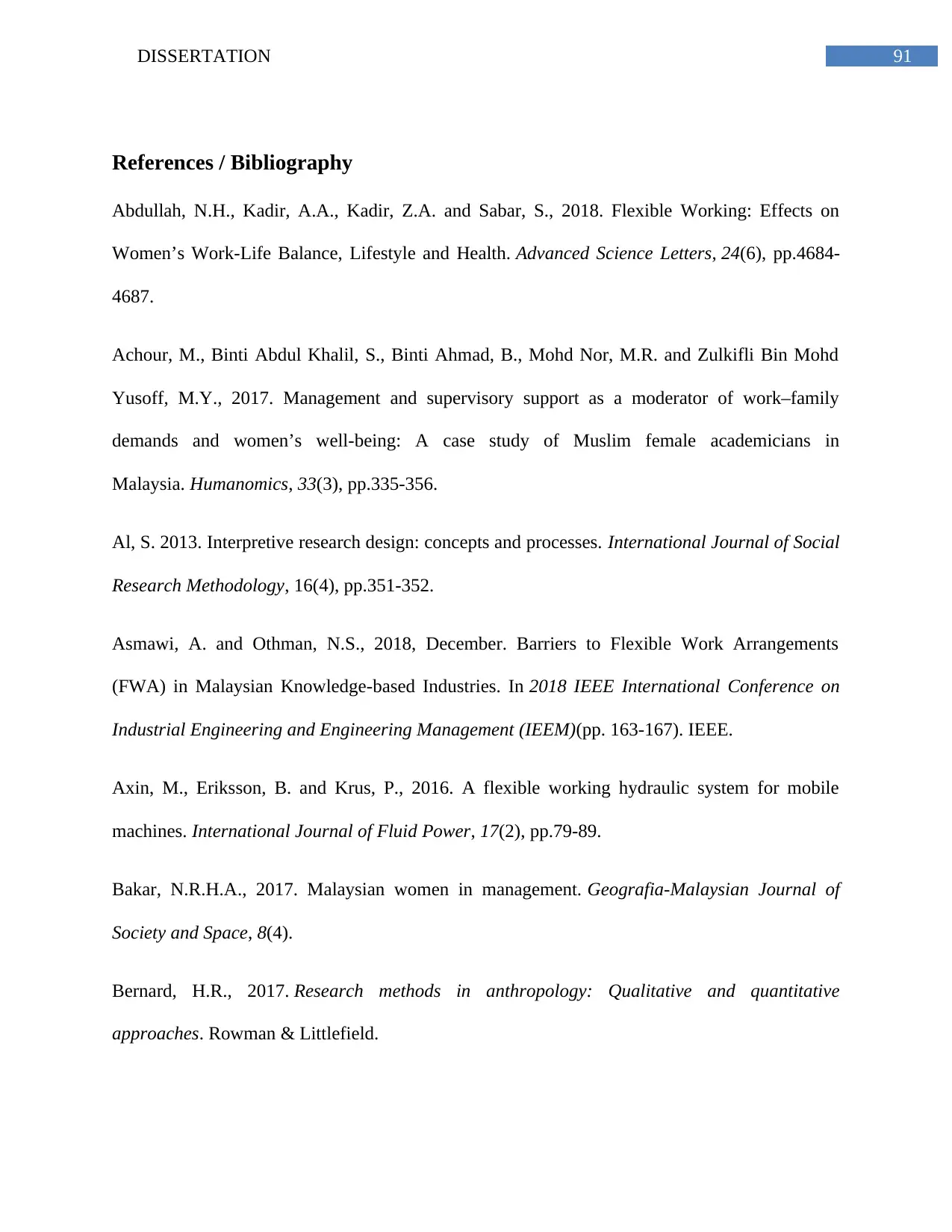
References / Bibliography
Abdullah, N.H., Kadir, A.A., Kadir, Z.A. and Sabar, S., 2018. Flexible Working: Effects on
Women’s Work-Life Balance, Lifestyle and Health. Advanced Science Letters, 24(6), pp.4684-
4687.
Achour, M., Binti Abdul Khalil, S., Binti Ahmad, B., Mohd Nor, M.R. and Zulkifli Bin Mohd
Yusoff, M.Y., 2017. Management and supervisory support as a moderator of work–family
demands and women’s well-being: A case study of Muslim female academicians in
Malaysia. Humanomics, 33(3), pp.335-356.
Al, S. 2013. Interpretive research design: concepts and processes. International Journal of Social
Research Methodology, 16(4), pp.351-352.
Asmawi, A. and Othman, N.S., 2018, December. Barriers to Flexible Work Arrangements
(FWA) in Malaysian Knowledge-based Industries. In 2018 IEEE International Conference on
Industrial Engineering and Engineering Management (IEEM)(pp. 163-167). IEEE.
Axin, M., Eriksson, B. and Krus, P., 2016. A flexible working hydraulic system for mobile
machines. International Journal of Fluid Power, 17(2), pp.79-89.
Bakar, N.R.H.A., 2017. Malaysian women in management. Geografia-Malaysian Journal of
Society and Space, 8(4).
Bernard, H.R., 2017. Research methods in anthropology: Qualitative and quantitative
approaches. Rowman & Littlefield.
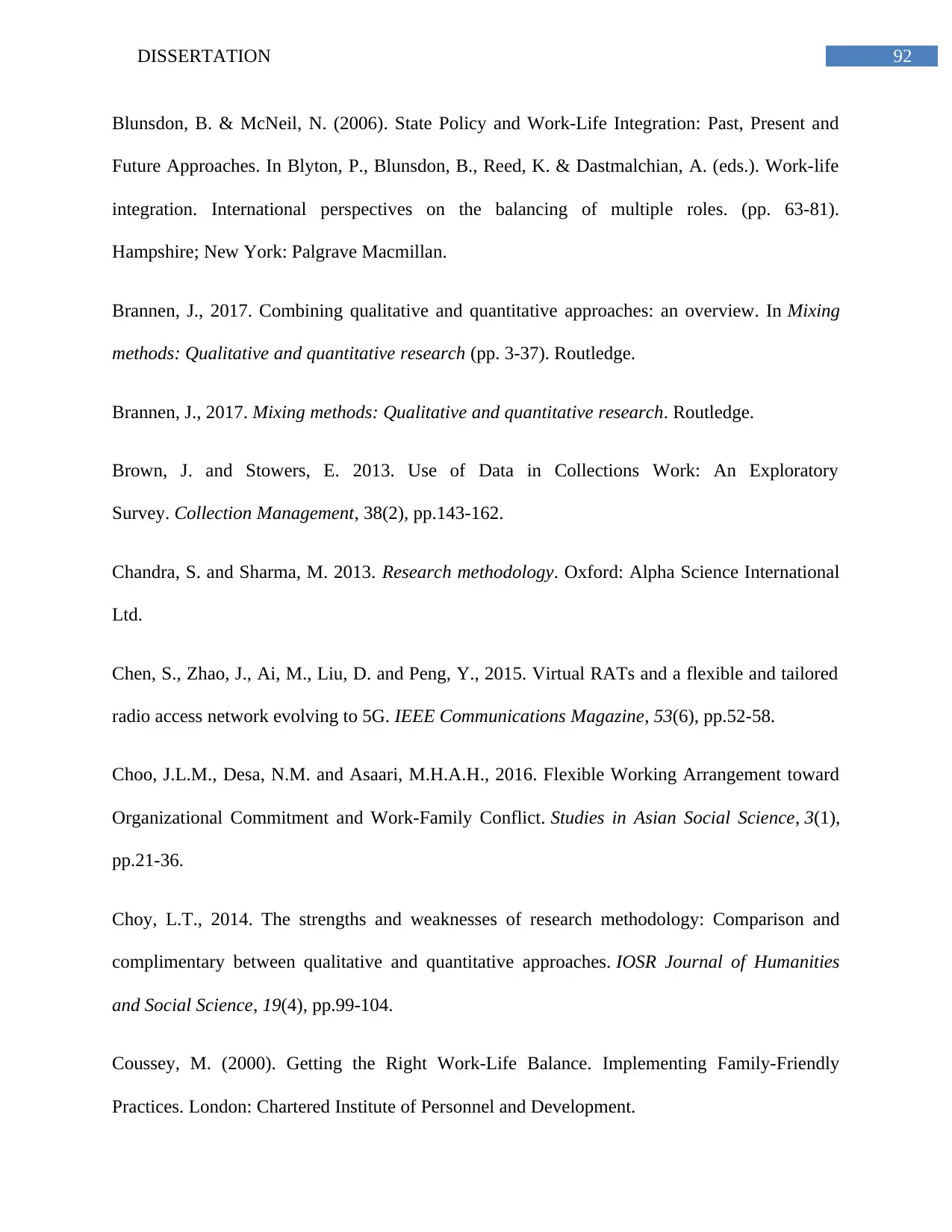
Blunsdon, B. & McNeil, N. (2006). State Policy and Work-Life Integration: Past, Present and
Future Approaches. In Blyton, P., Blunsdon, B., Reed, K. & Dastmalchian, A. (eds.). Work-life
integration. International perspectives on the balancing of multiple roles. (pp. 63-81).
Hampshire; New York: Palgrave Macmillan.
Brannen, J., 2017. Combining qualitative and quantitative approaches: an overview. In Mixing
methods: Qualitative and quantitative research (pp. 3-37). Routledge.
Brannen, J., 2017. Mixing methods: Qualitative and quantitative research. Routledge.
Brown, J. and Stowers, E. 2013. Use of Data in Collections Work: An Exploratory
Survey. Collection Management, 38(2), pp.143-162.
Chandra, S. and Sharma, M. 2013. Research methodology. Oxford: Alpha Science International
Ltd.
Chen, S., Zhao, J., Ai, M., Liu, D. and Peng, Y., 2015. Virtual RATs and a flexible and tailored
radio access network evolving to 5G. IEEE Communications Magazine, 53(6), pp.52-58.
Choo, J.L.M., Desa, N.M. and Asaari, M.H.A.H., 2016. Flexible Working Arrangement toward
Organizational Commitment and Work-Family Conflict. Studies in Asian Social Science, 3(1),
pp.21-36.
Choy, L.T., 2014. The strengths and weaknesses of research methodology: Comparison and
complimentary between qualitative and quantitative approaches. IOSR Journal of Humanities
and Social Science, 19(4), pp.99-104.
Coussey, M. (2000). Getting the Right Work-Life Balance. Implementing Family-Friendly
Practices. London: Chartered Institute of Personnel and Development.
⊘ This is a preview!⊘
Do you want full access?
Subscribe today to unlock all pages.

Trusted by 1+ million students worldwide
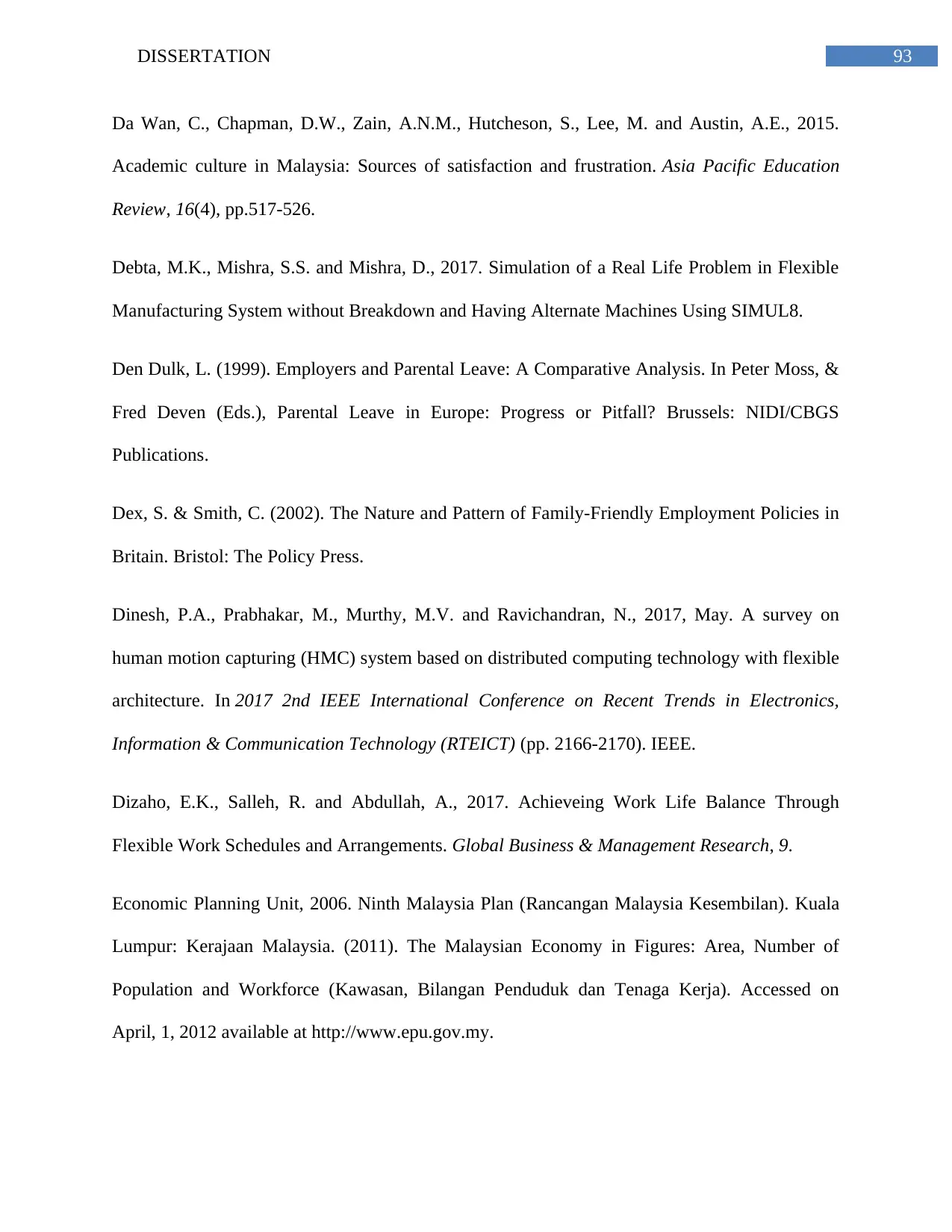
Da Wan, C., Chapman, D.W., Zain, A.N.M., Hutcheson, S., Lee, M. and Austin, A.E., 2015.
Academic culture in Malaysia: Sources of satisfaction and frustration. Asia Pacific Education
Review, 16(4), pp.517-526.
Debta, M.K., Mishra, S.S. and Mishra, D., 2017. Simulation of a Real Life Problem in Flexible
Manufacturing System without Breakdown and Having Alternate Machines Using SIMUL8.
Den Dulk, L. (1999). Employers and Parental Leave: A Comparative Analysis. In Peter Moss, &
Fred Deven (Eds.), Parental Leave in Europe: Progress or Pitfall? Brussels: NIDI/CBGS
Publications.
Dex, S. & Smith, C. (2002). The Nature and Pattern of Family-Friendly Employment Policies in
Britain. Bristol: The Policy Press.
Dinesh, P.A., Prabhakar, M., Murthy, M.V. and Ravichandran, N., 2017, May. A survey on
human motion capturing (HMC) system based on distributed computing technology with flexible
architecture. In 2017 2nd IEEE International Conference on Recent Trends in Electronics,
Information & Communication Technology (RTEICT) (pp. 2166-2170). IEEE.
Dizaho, E.K., Salleh, R. and Abdullah, A., 2017. Achieveing Work Life Balance Through
Flexible Work Schedules and Arrangements. Global Business & Management Research, 9.
Economic Planning Unit, 2006. Ninth Malaysia Plan (Rancangan Malaysia Kesembilan). Kuala
Lumpur: Kerajaan Malaysia. (2011). The Malaysian Economy in Figures: Area, Number of
Population and Workforce (Kawasan, Bilangan Penduduk dan Tenaga Kerja). Accessed on
April, 1, 2012 available at http://www.epu.gov.my.
Paraphrase This Document
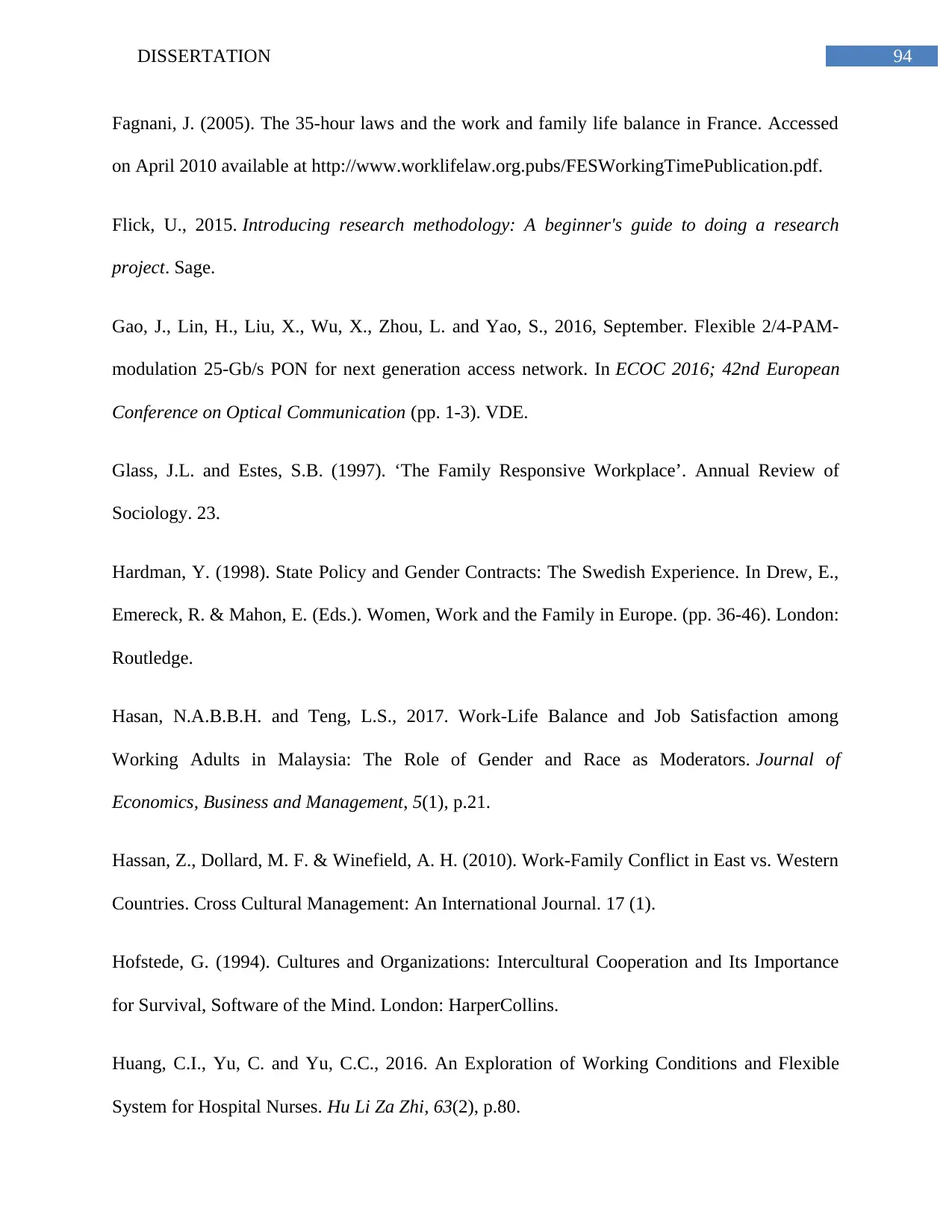
Fagnani, J. (2005). The 35-hour laws and the work and family life balance in France. Accessed
on April 2010 available at http://www.worklifelaw.org.pubs/FESWorkingTimePublication.pdf.
Flick, U., 2015. Introducing research methodology: A beginner's guide to doing a research
project. Sage.
Gao, J., Lin, H., Liu, X., Wu, X., Zhou, L. and Yao, S., 2016, September. Flexible 2/4-PAM-
modulation 25-Gb/s PON for next generation access network. In ECOC 2016; 42nd European
Conference on Optical Communication (pp. 1-3). VDE.
Glass, J.L. and Estes, S.B. (1997). ‘The Family Responsive Workplace’. Annual Review of
Sociology. 23.
Hardman, Y. (1998). State Policy and Gender Contracts: The Swedish Experience. In Drew, E.,
Emereck, R. & Mahon, E. (Eds.). Women, Work and the Family in Europe. (pp. 36-46). London:
Routledge.
Hasan, N.A.B.B.H. and Teng, L.S., 2017. Work-Life Balance and Job Satisfaction among
Working Adults in Malaysia: The Role of Gender and Race as Moderators. Journal of
Economics, Business and Management, 5(1), p.21.
Hassan, Z., Dollard, M. F. & Winefield, A. H. (2010). Work-Family Conflict in East vs. Western
Countries. Cross Cultural Management: An International Journal. 17 (1).
Hofstede, G. (1994). Cultures and Organizations: Intercultural Cooperation and Its Importance
for Survival, Software of the Mind. London: HarperCollins.
Huang, C.I., Yu, C. and Yu, C.C., 2016. An Exploration of Working Conditions and Flexible
System for Hospital Nurses. Hu Li Za Zhi, 63(2), p.80.
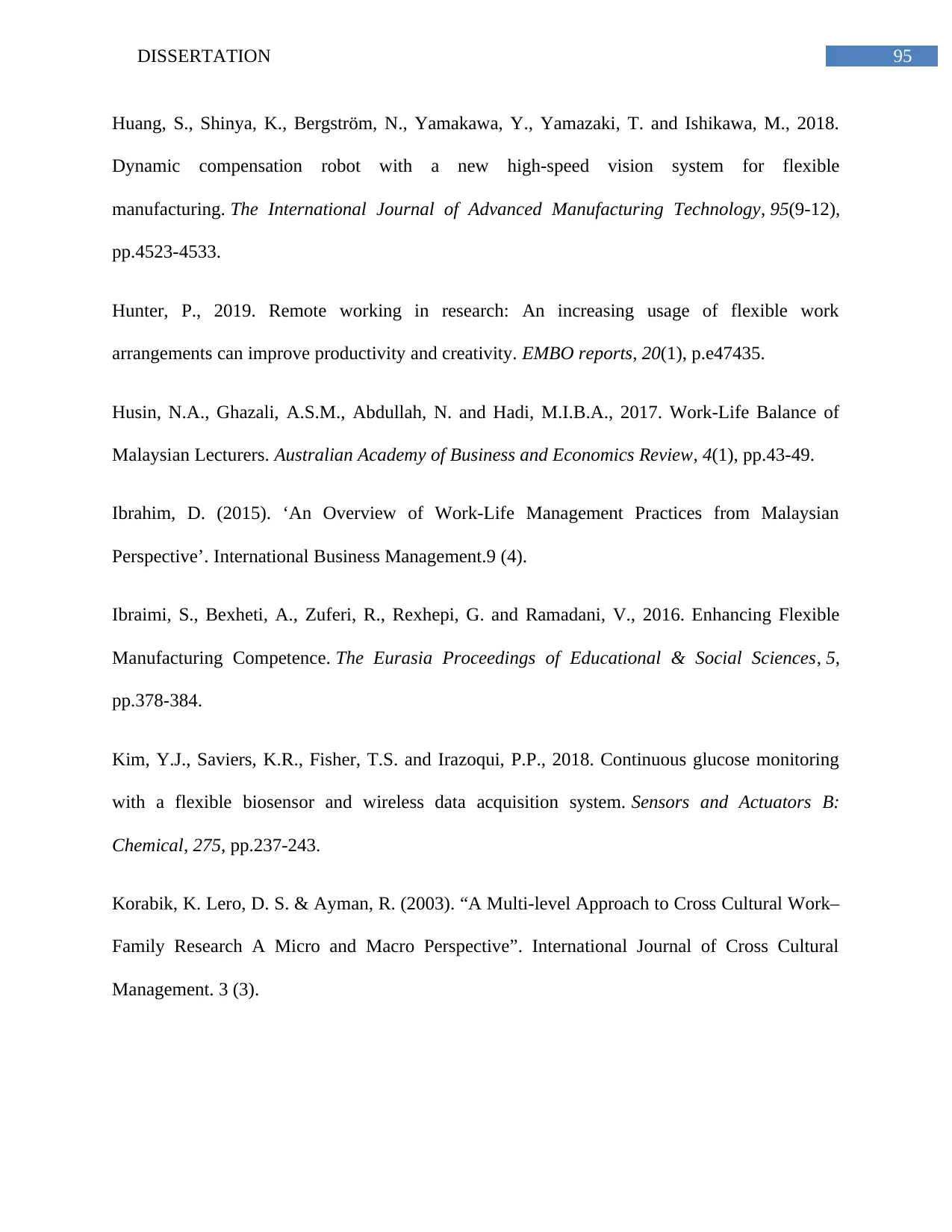
Huang, S., Shinya, K., Bergström, N., Yamakawa, Y., Yamazaki, T. and Ishikawa, M., 2018.
Dynamic compensation robot with a new high-speed vision system for flexible
manufacturing. The International Journal of Advanced Manufacturing Technology, 95(9-12),
pp.4523-4533.
Hunter, P., 2019. Remote working in research: An increasing usage of flexible work
arrangements can improve productivity and creativity. EMBO reports, 20(1), p.e47435.
Husin, N.A., Ghazali, A.S.M., Abdullah, N. and Hadi, M.I.B.A., 2017. Work-Life Balance of
Malaysian Lecturers. Australian Academy of Business and Economics Review, 4(1), pp.43-49.
Ibrahim, D. (2015). ‘An Overview of Work-Life Management Practices from Malaysian
Perspective’. International Business Management.9 (4).
Ibraimi, S., Bexheti, A., Zuferi, R., Rexhepi, G. and Ramadani, V., 2016. Enhancing Flexible
Manufacturing Competence. The Eurasia Proceedings of Educational & Social Sciences, 5,
pp.378-384.
Kim, Y.J., Saviers, K.R., Fisher, T.S. and Irazoqui, P.P., 2018. Continuous glucose monitoring
with a flexible biosensor and wireless data acquisition system. Sensors and Actuators B:
Chemical, 275, pp.237-243.
Korabik, K. Lero, D. S. & Ayman, R. (2003). “A Multi-level Approach to Cross Cultural Work–
Family Research A Micro and Macro Perspective”. International Journal of Cross Cultural
Management. 3 (3).
⊘ This is a preview!⊘
Do you want full access?
Subscribe today to unlock all pages.

Trusted by 1+ million students worldwide
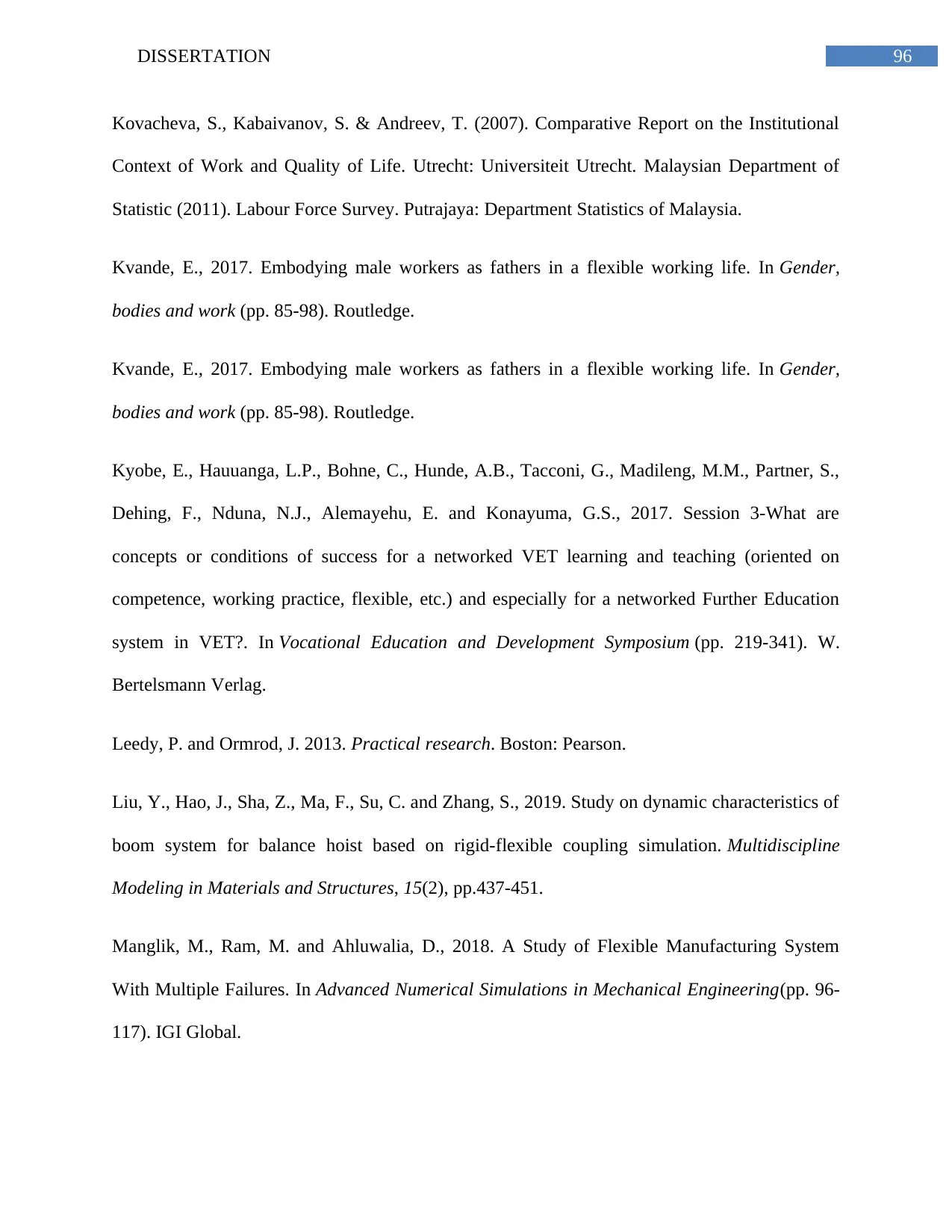
Kovacheva, S., Kabaivanov, S. & Andreev, T. (2007). Comparative Report on the Institutional
Context of Work and Quality of Life. Utrecht: Universiteit Utrecht. Malaysian Department of
Statistic (2011). Labour Force Survey. Putrajaya: Department Statistics of Malaysia.
Kvande, E., 2017. Embodying male workers as fathers in a flexible working life. In Gender,
bodies and work (pp. 85-98). Routledge.
Kvande, E., 2017. Embodying male workers as fathers in a flexible working life. In Gender,
bodies and work (pp. 85-98). Routledge.
Kyobe, E., Hauuanga, L.P., Bohne, C., Hunde, A.B., Tacconi, G., Madileng, M.M., Partner, S.,
Dehing, F., Nduna, N.J., Alemayehu, E. and Konayuma, G.S., 2017. Session 3-What are
concepts or conditions of success for a networked VET learning and teaching (oriented on
competence, working practice, flexible, etc.) and especially for a networked Further Education
system in VET?. In Vocational Education and Development Symposium (pp. 219-341). W.
Bertelsmann Verlag.
Leedy, P. and Ormrod, J. 2013. Practical research. Boston: Pearson.
Liu, Y., Hao, J., Sha, Z., Ma, F., Su, C. and Zhang, S., 2019. Study on dynamic characteristics of
boom system for balance hoist based on rigid-flexible coupling simulation. Multidiscipline
Modeling in Materials and Structures, 15(2), pp.437-451.
Manglik, M., Ram, M. and Ahluwalia, D., 2018. A Study of Flexible Manufacturing System
With Multiple Failures. In Advanced Numerical Simulations in Mechanical Engineering(pp. 96-
117). IGI Global.
Paraphrase This Document

Marczyk, G., DeMatteo, D. and Festinger, D., 2017. Primarys of research design and
methodology. John Wiley.
Mavrou, P., Papadopoulos, A.I., Seferlis, P., Linke, P. and Voutetakis, S., 2015. Systematic
nonlinear sensitivity analysis of working fluid mixtures for flexible solar rankine
cycles. Chemical Engineering Transactions, 45, pp.1777-1782.
McCusker, K. and Gunaydin, S., 2015. Research using qualitative, quantitative or mixed
methods and choice based on the research. Perfusion, 30(7), pp.537-542.
Menger, P.M., 2017. Contingent High-Skilled Work and Flexible Labor Markets. Creative
Workers and Independent Contractors Cycling Between Employment and Unemployment. Swiss
Journal of Sociology, 43(2), pp.253-284.
Miller, M.J., Miller, M.J., Santiago-Materese, D., Seibert, M.A. and Lim, D.S., 2019. A flexible
telecommunication architecture for human planetary exploration based on the BASALT science-
driven Mars analog. Astrobiology, 19(3), pp.478-496.
Mitchell, M. and Jolley, J. 2013. Research design explained. Australia: Wadsworth Cengage
Learning.
Morris-Stiff, G.J., Sarasin, S., Edwards, P., Lewis, W.G. and Lewis, M.H. (2005). “The
European Working Time Directive: One for All and All for One?” Surgery. 137 (3).
Neuman, W.L., 2013. Social research methods: Qualitative and quantitative approaches.
Pearson education.
Noble, H. and Smith, J., 2015. Issues of validity and reliability in qualitative research. Evidence-
Based Nursing, pp.ebnurs-2015.
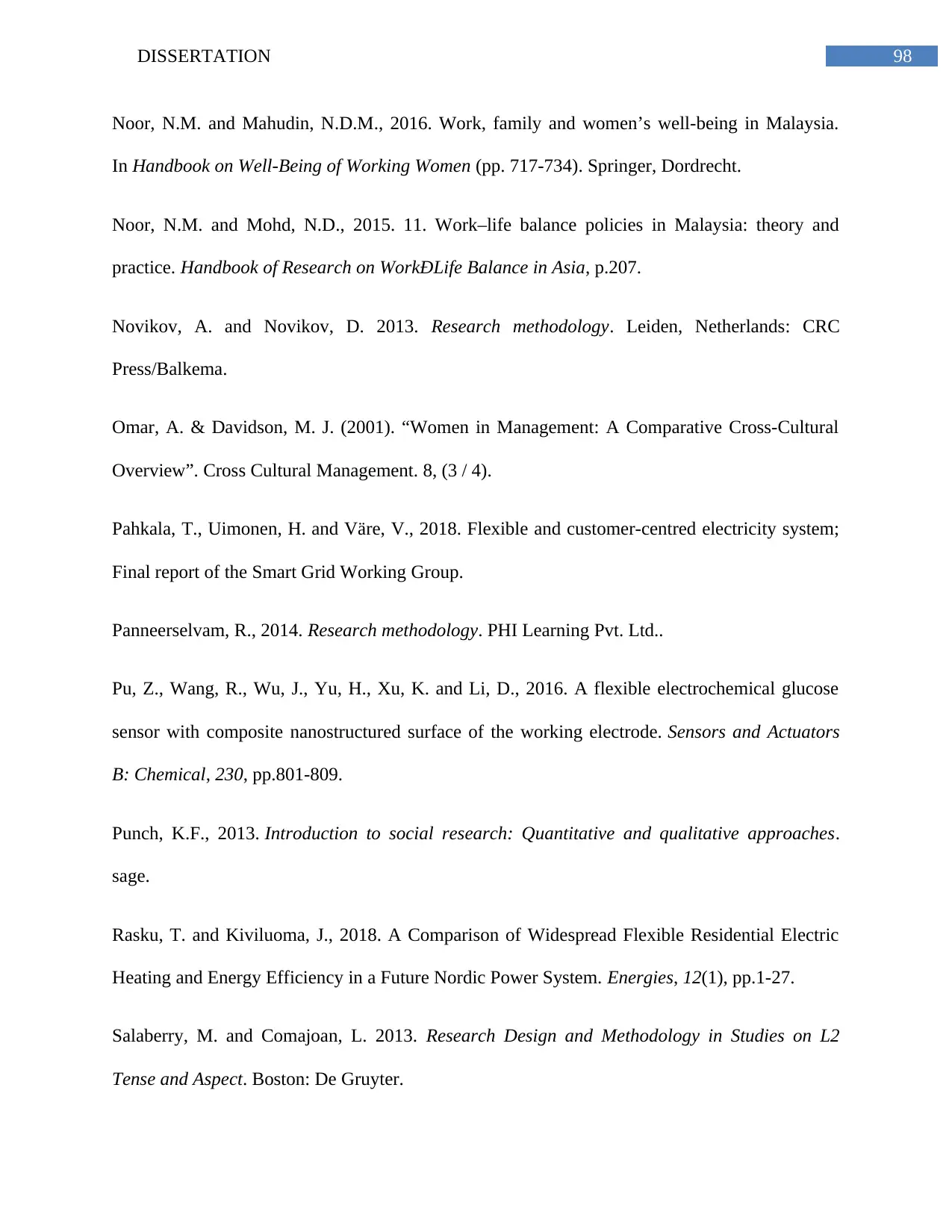
Noor, N.M. and Mahudin, N.D.M., 2016. Work, family and women’s well-being in Malaysia.
In Handbook on Well-Being of Working Women (pp. 717-734). Springer, Dordrecht.
Noor, N.M. and Mohd, N.D., 2015. 11. Work–life balance policies in Malaysia: theory and
practice. Handbook of Research on WorkÐLife Balance in Asia, p.207.
Novikov, A. and Novikov, D. 2013. Research methodology. Leiden, Netherlands: CRC
Press/Balkema.
Omar, A. & Davidson, M. J. (2001). “Women in Management: A Comparative Cross-Cultural
Overview”. Cross Cultural Management. 8, (3 / 4).
Pahkala, T., Uimonen, H. and Väre, V., 2018. Flexible and customer-centred electricity system;
Final report of the Smart Grid Working Group.
Panneerselvam, R., 2014. Research methodology. PHI Learning Pvt. Ltd..
Pu, Z., Wang, R., Wu, J., Yu, H., Xu, K. and Li, D., 2016. A flexible electrochemical glucose
sensor with composite nanostructured surface of the working electrode. Sensors and Actuators
B: Chemical, 230, pp.801-809.
Punch, K.F., 2013. Introduction to social research: Quantitative and qualitative approaches.
sage.
Rasku, T. and Kiviluoma, J., 2018. A Comparison of Widespread Flexible Residential Electric
Heating and Energy Efficiency in a Future Nordic Power System. Energies, 12(1), pp.1-27.
Salaberry, M. and Comajoan, L. 2013. Research Design and Methodology in Studies on L2
Tense and Aspect. Boston: De Gruyter.
⊘ This is a preview!⊘
Do you want full access?
Subscribe today to unlock all pages.

Trusted by 1+ million students worldwide
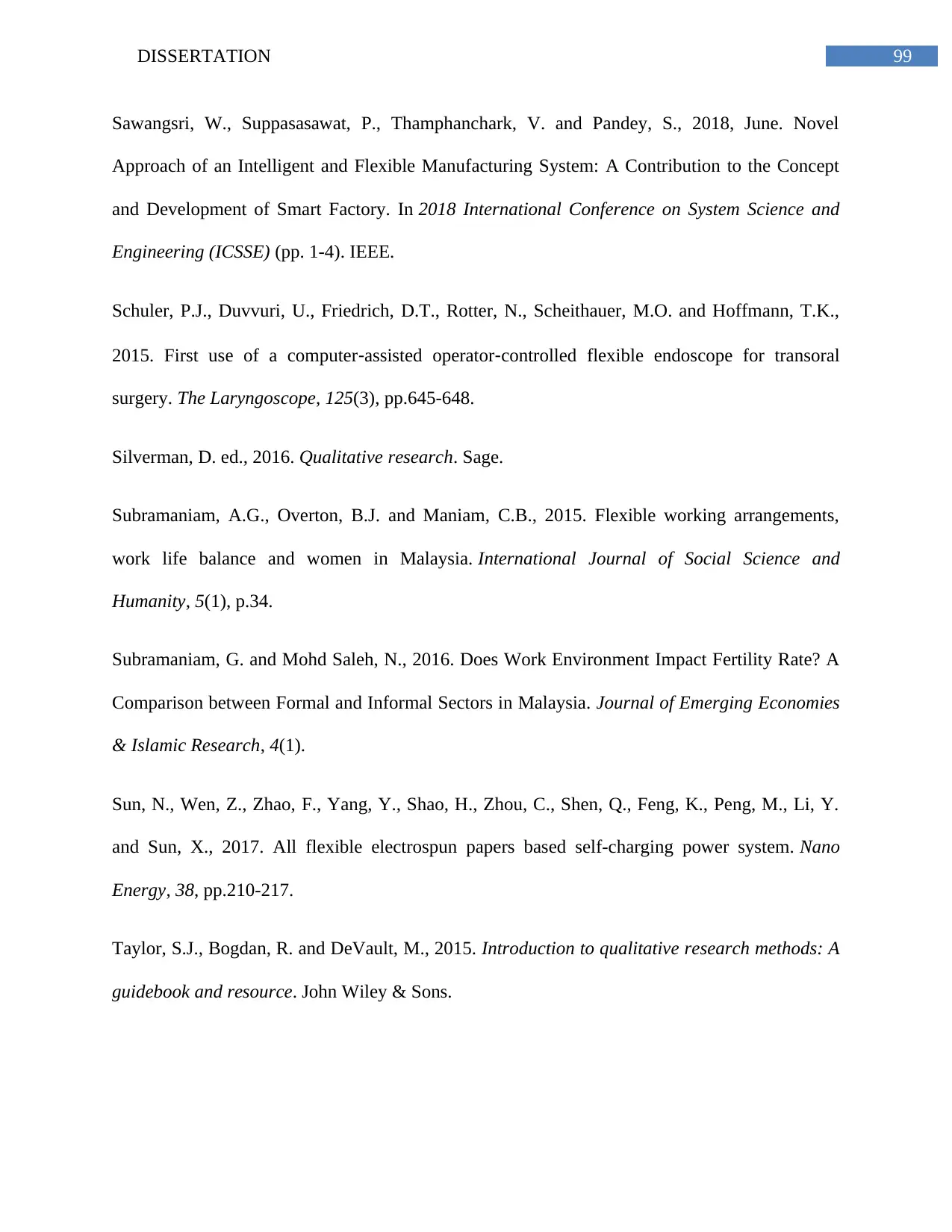
Sawangsri, W., Suppasasawat, P., Thamphanchark, V. and Pandey, S., 2018, June. Novel
Approach of an Intelligent and Flexible Manufacturing System: A Contribution to the Concept
and Development of Smart Factory. In 2018 International Conference on System Science and
Engineering (ICSSE) (pp. 1-4). IEEE.
Schuler, P.J., Duvvuri, U., Friedrich, D.T., Rotter, N., Scheithauer, M.O. and Hoffmann, T.K.,
2015. First use of a computer‐assisted operator‐controlled flexible endoscope for transoral
surgery. The Laryngoscope, 125(3), pp.645-648.
Silverman, D. ed., 2016. Qualitative research. Sage.
Subramaniam, A.G., Overton, B.J. and Maniam, C.B., 2015. Flexible working arrangements,
work life balance and women in Malaysia. International Journal of Social Science and
Humanity, 5(1), p.34.
Subramaniam, G. and Mohd Saleh, N., 2016. Does Work Environment Impact Fertility Rate? A
Comparison between Formal and Informal Sectors in Malaysia. Journal of Emerging Economies
& Islamic Research, 4(1).
Sun, N., Wen, Z., Zhao, F., Yang, Y., Shao, H., Zhou, C., Shen, Q., Feng, K., Peng, M., Li, Y.
and Sun, X., 2017. All flexible electrospun papers based self-charging power system. Nano
Energy, 38, pp.210-217.
Taylor, S.J., Bogdan, R. and DeVault, M., 2015. Introduction to qualitative research methods: A
guidebook and resource. John Wiley & Sons.
Paraphrase This Document

Thackray, H., Kor, A., Pattinson, C. and Earle, L., 2018, January. Audit of an Organisation’s ICT
Systems for Flexible Working. In 2017 World Congress on Sustainable Technologies (WCST).
IEEE.
Uprichard, E. 2013. Sampling: bridging probability and non-probability designs. International
Journal of Social Research Methodology, 16(1), pp.1-11.
Van Tassell, B., Yang, S., Le, C., Huang, L., Liu, S., Chando, P., Liu, X., Byro, A., Gerber, D.L.,
Leland, E.S. and Sanders, S.R., 2016. Metacapacitors: printed thin film, flexible capacitors for
power conversion applications. IEEE Transactions on Power Electronics, 31(4), pp.2695-2708.
Walter, M. and Andersen, C., 2013. Indigenous statistics: A quantitative research methodology.
Left Coast Press.
Wang, X., Zhu, Y., Zhu, M., Zhu, Y., Fan, H. and Wang, Y., 2017. Thermal analysis and
optimization of an ice and snow melting system using geothermy by super-long flexible heat
pipes. Applied Thermal Engineering, 112, pp.1353-1363.
Wong, P.Y., Bandar, N.F.A. and Saili, J., 2017. Workplace factors and work-life balance among
employees in selected services sector. International Journal of Business and Society, 18(S4),
pp.677-684.
Wu, N., Jiang, H., Li, W., Lin, S., Zhong, J., Yuan, F., Huang, L., Hu, B. and Zhou, J., 2017.
Output enhanced compact multilayer flexible nanogenerator for self-powered wireless remote
system. Journal of Materials Chemistry A, 5(25), pp.12787-12792.
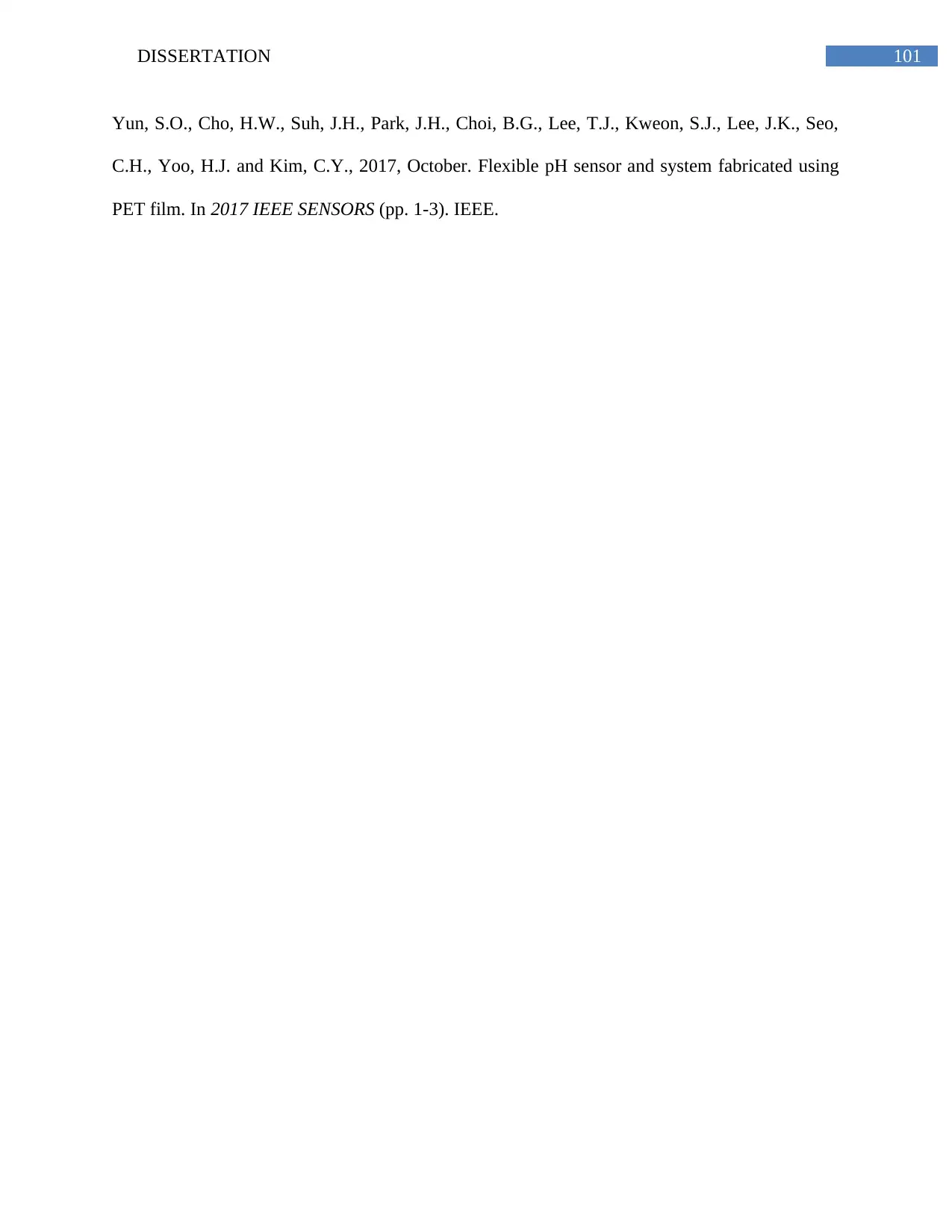
Yun, S.O., Cho, H.W., Suh, J.H., Park, J.H., Choi, B.G., Lee, T.J., Kweon, S.J., Lee, J.K., Seo,
C.H., Yoo, H.J. and Kim, C.Y., 2017, October. Flexible pH sensor and system fabricated using
PET film. In 2017 IEEE SENSORS (pp. 1-3). IEEE.
⊘ This is a preview!⊘
Do you want full access?
Subscribe today to unlock all pages.

Trusted by 1+ million students worldwide
Related Documents
Your All-in-One AI-Powered Toolkit for Academic Success.
+13062052269
info@desklib.com
Available 24*7 on WhatsApp / Email
![[object Object]](/_next/static/media/star-bottom.7253800d.svg)
© 2024 | Zucol Services PVT LTD | All rights reserved.





